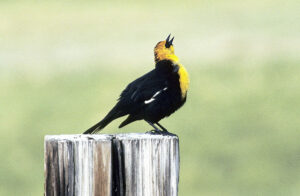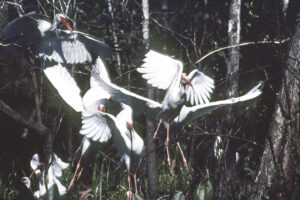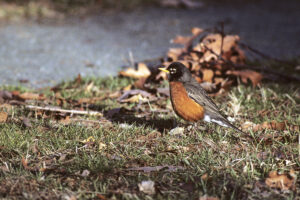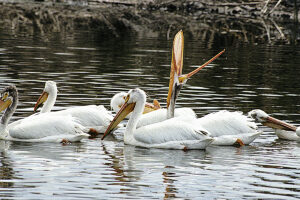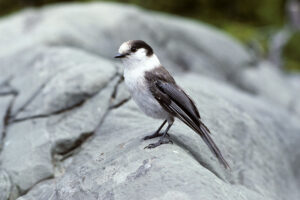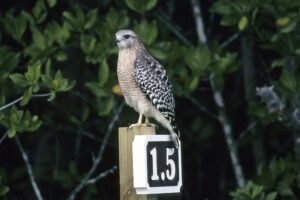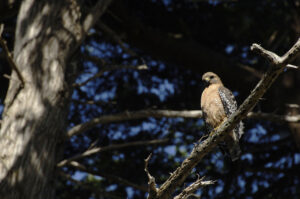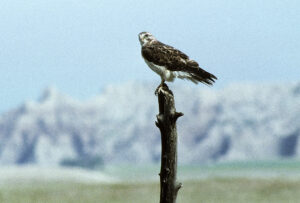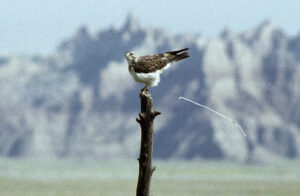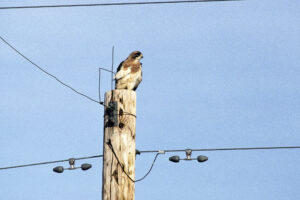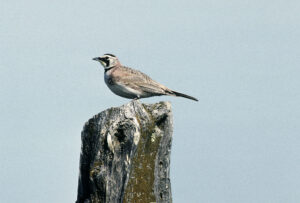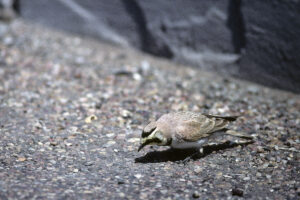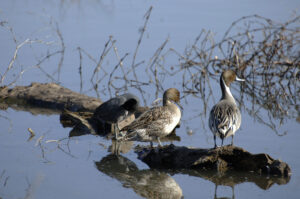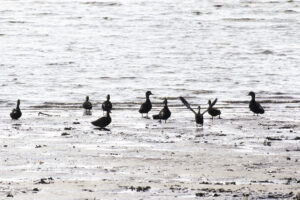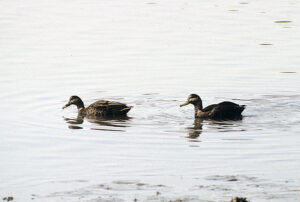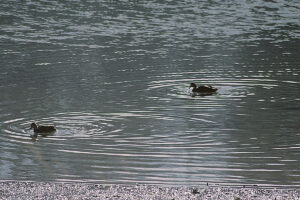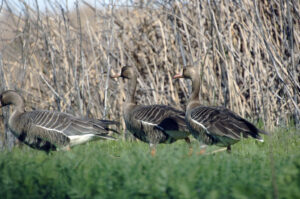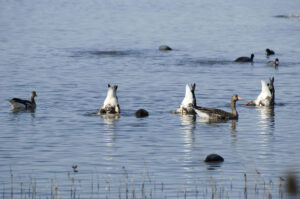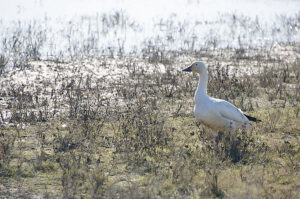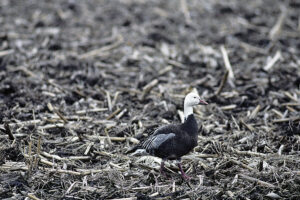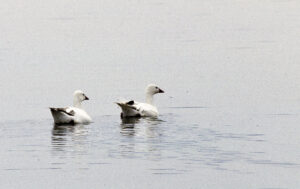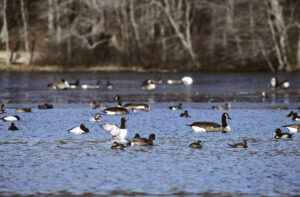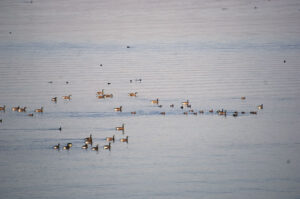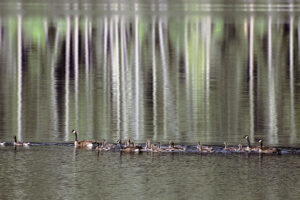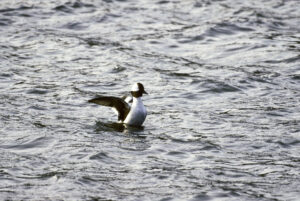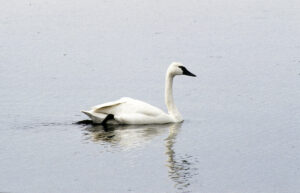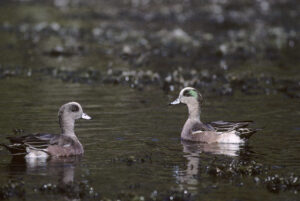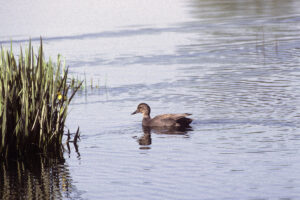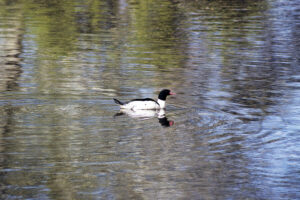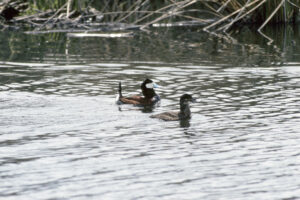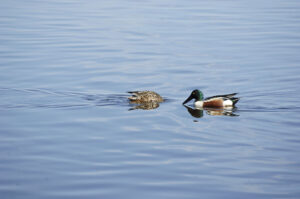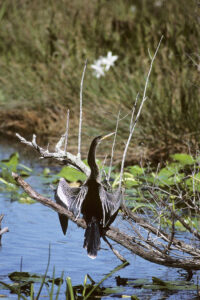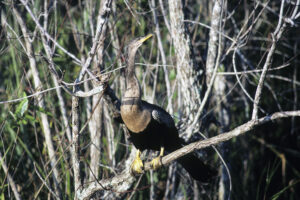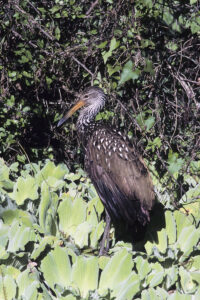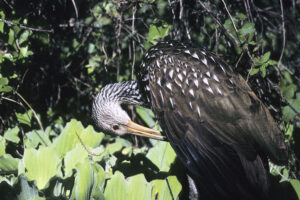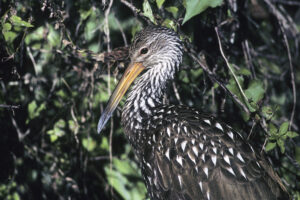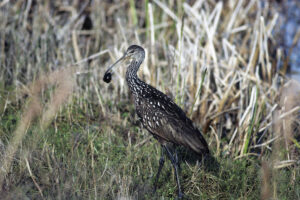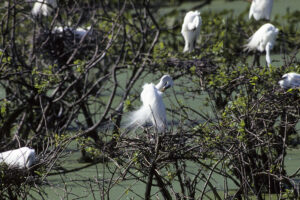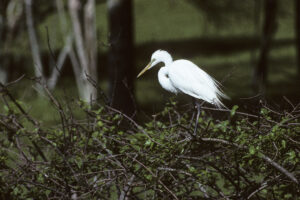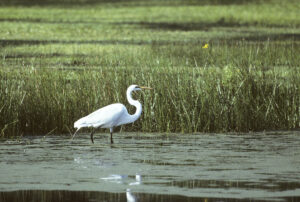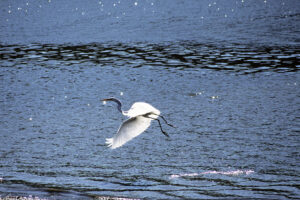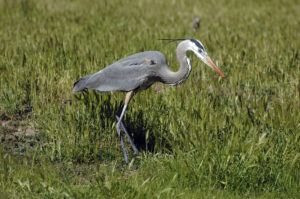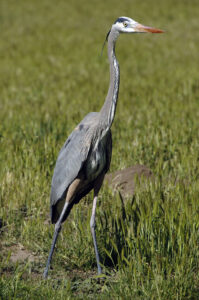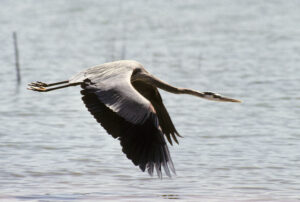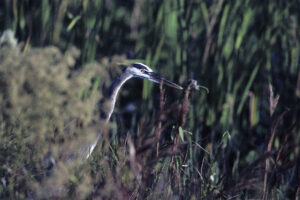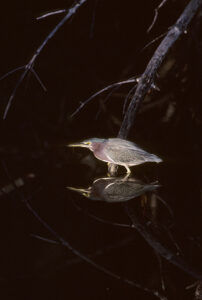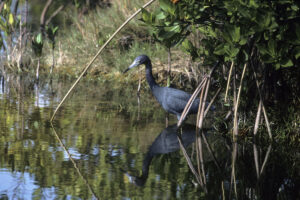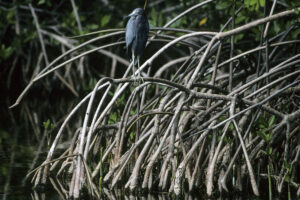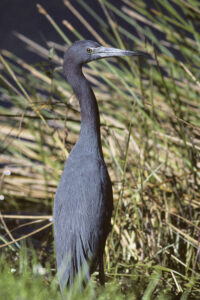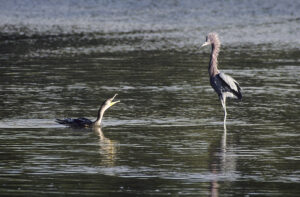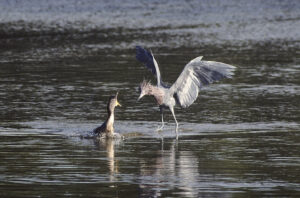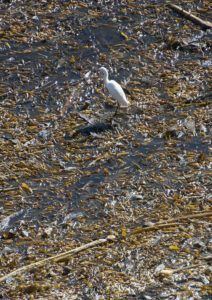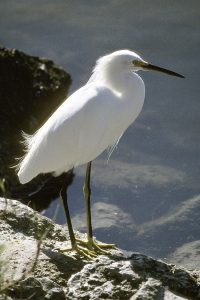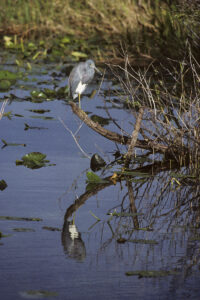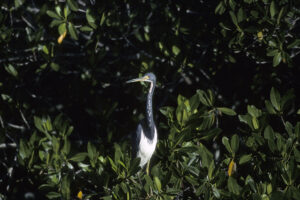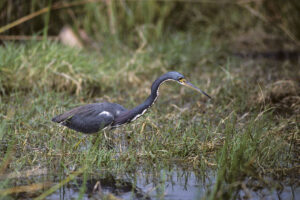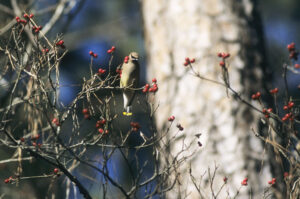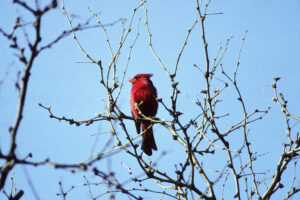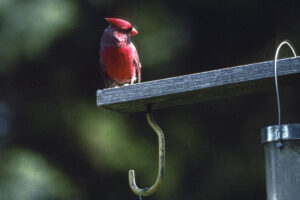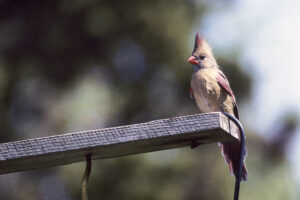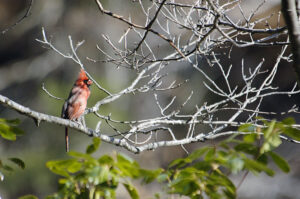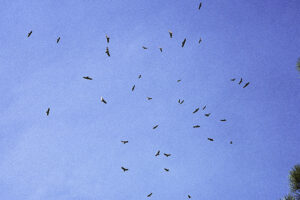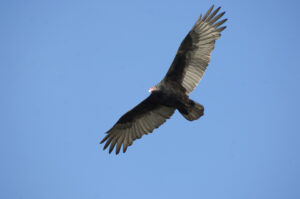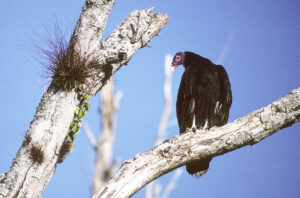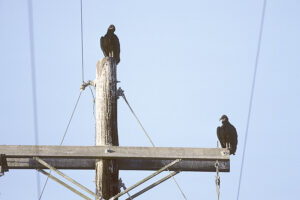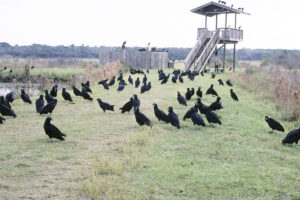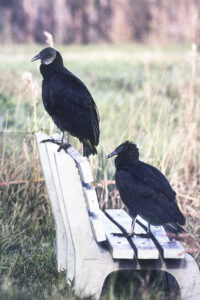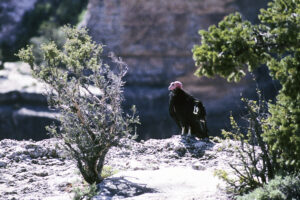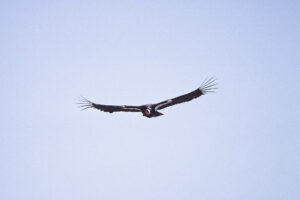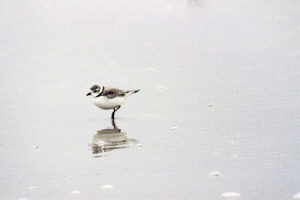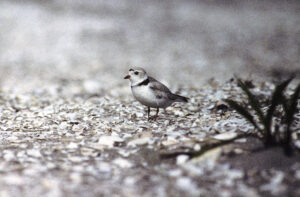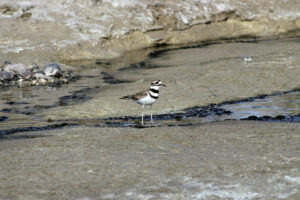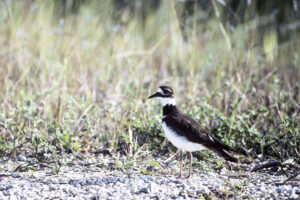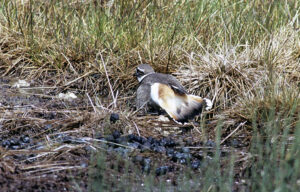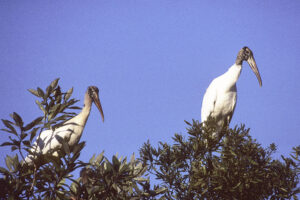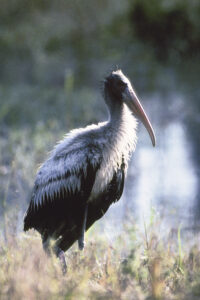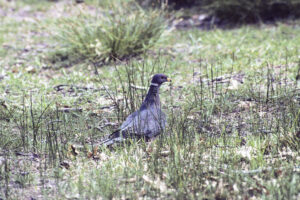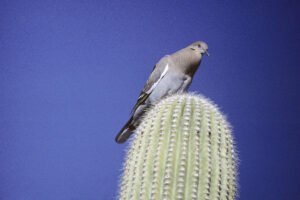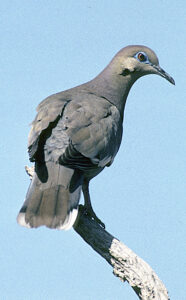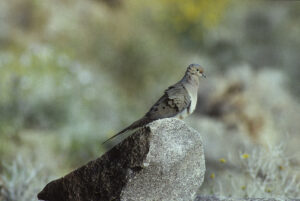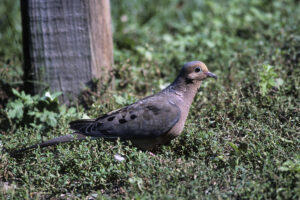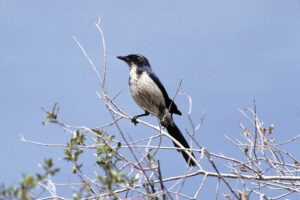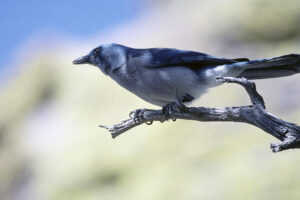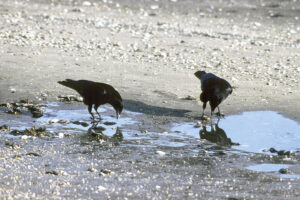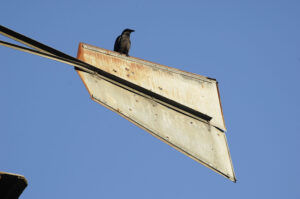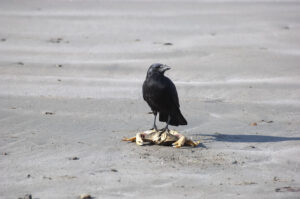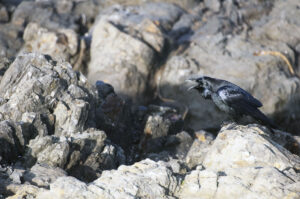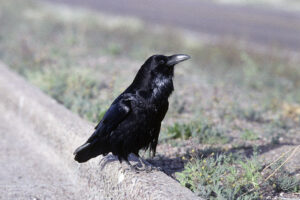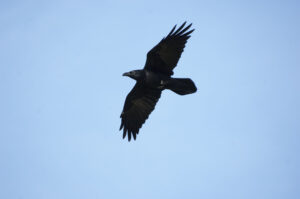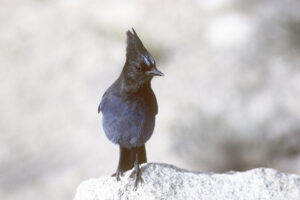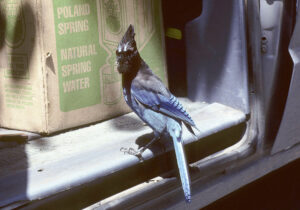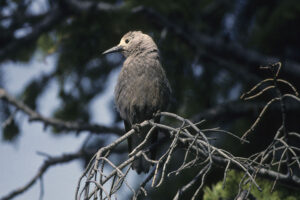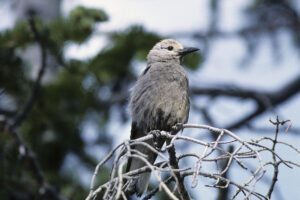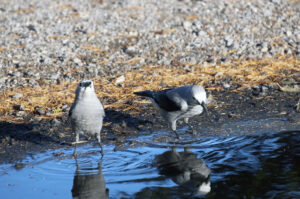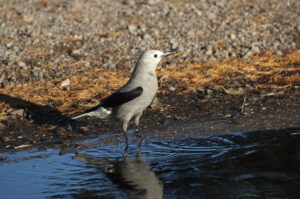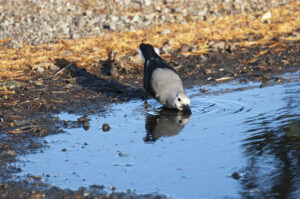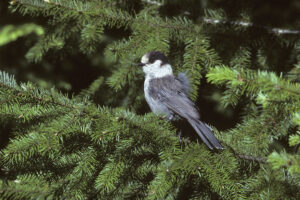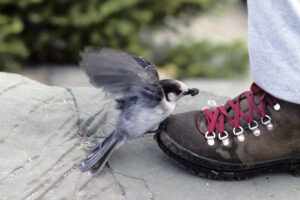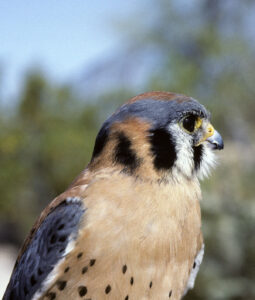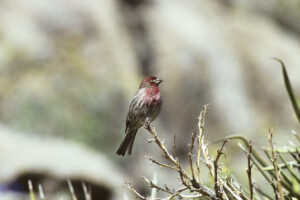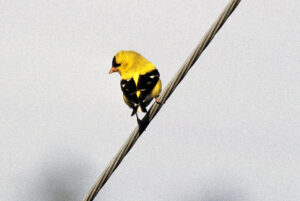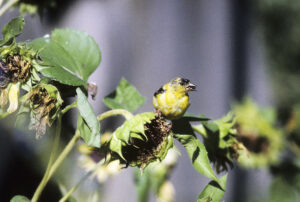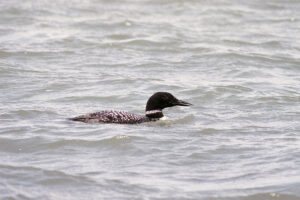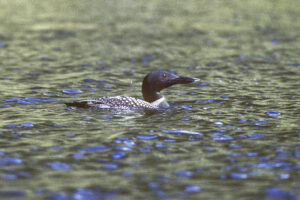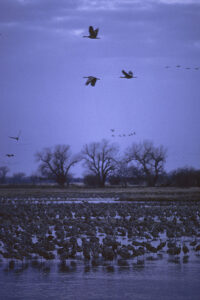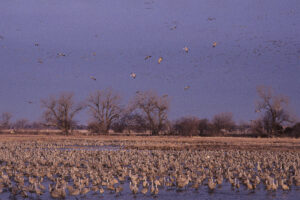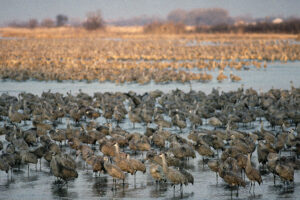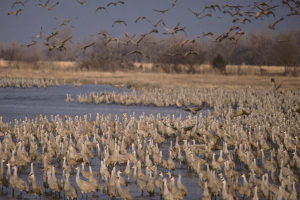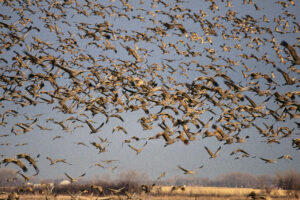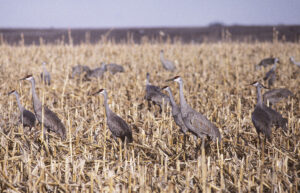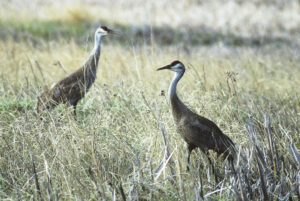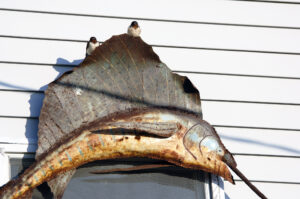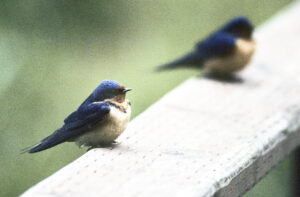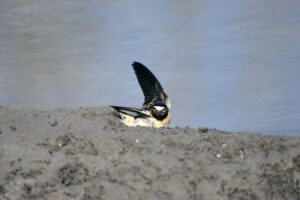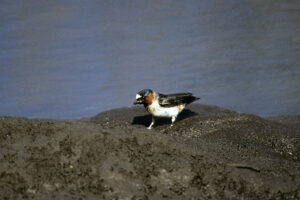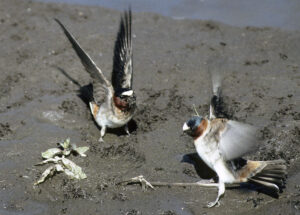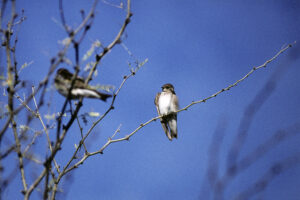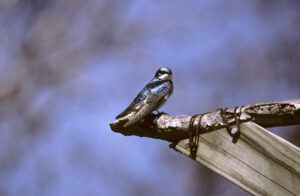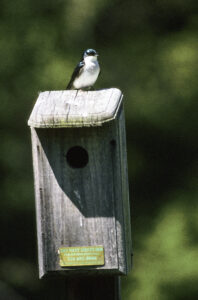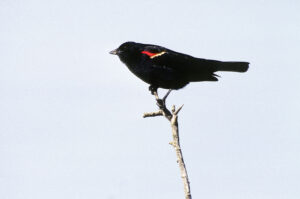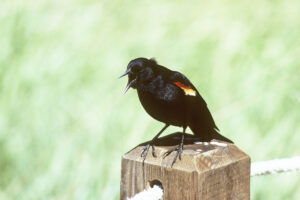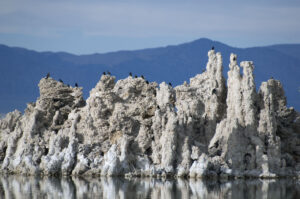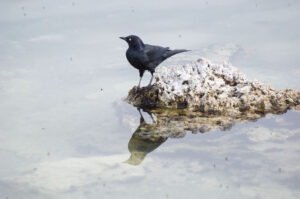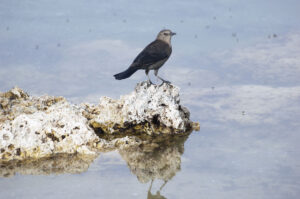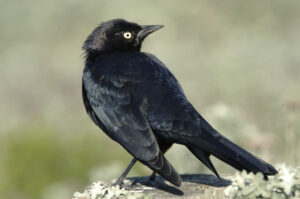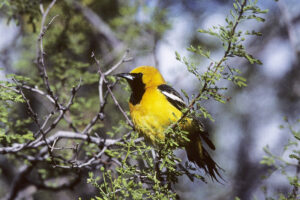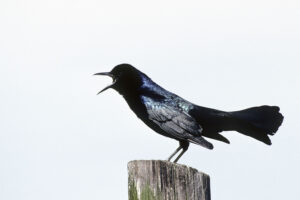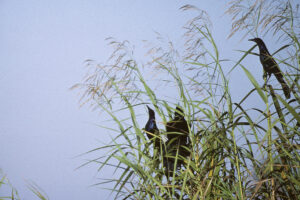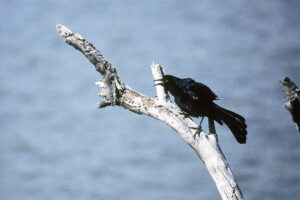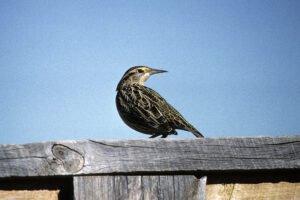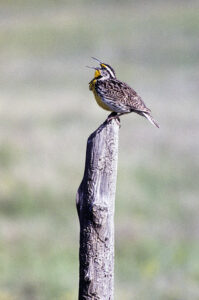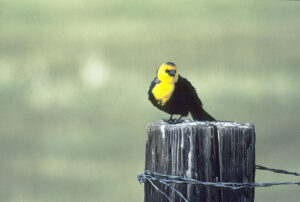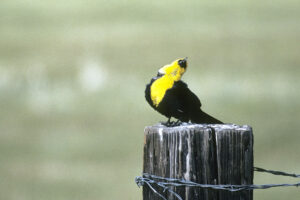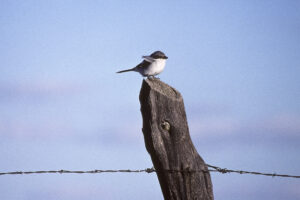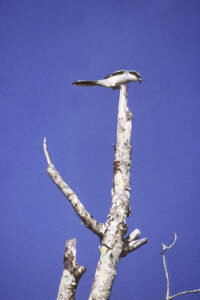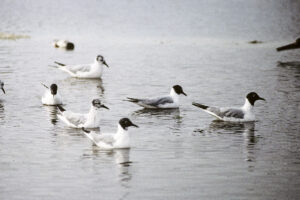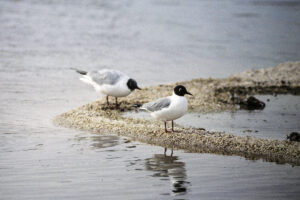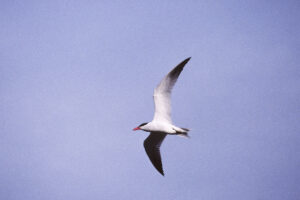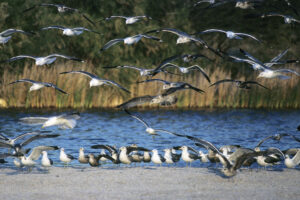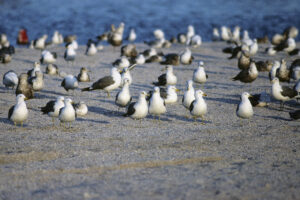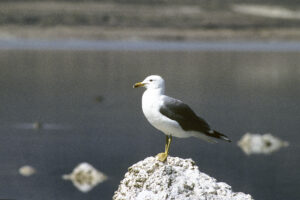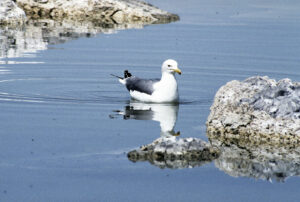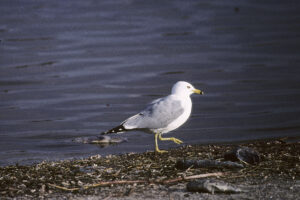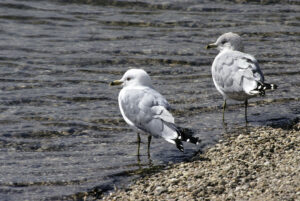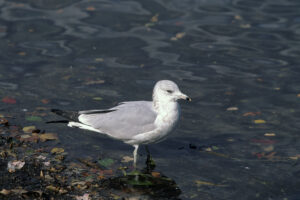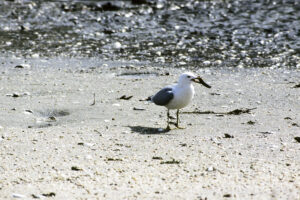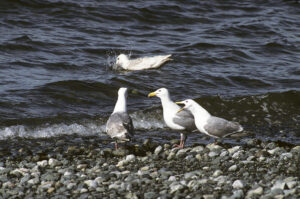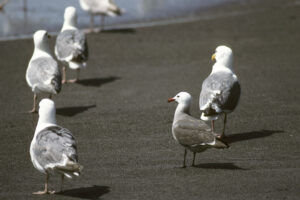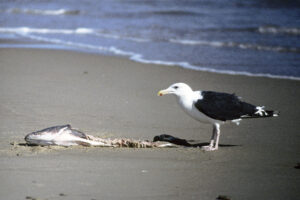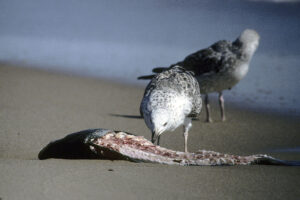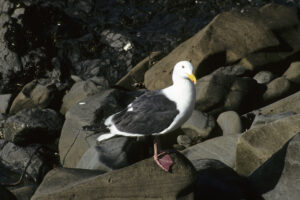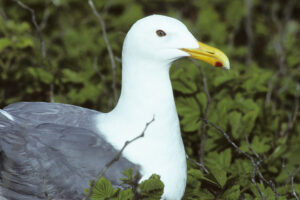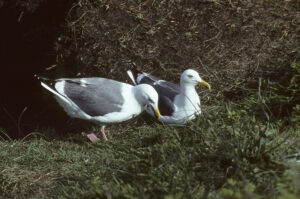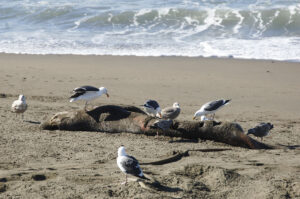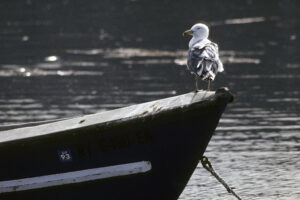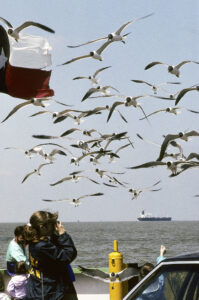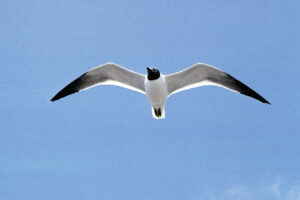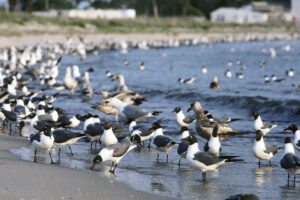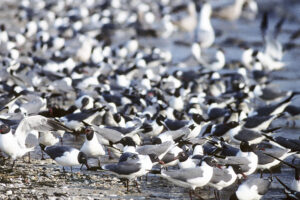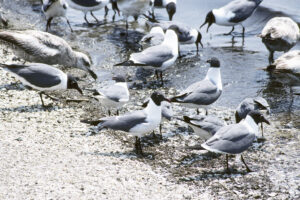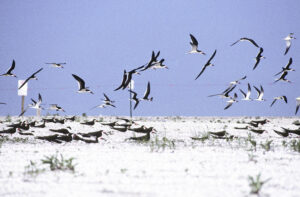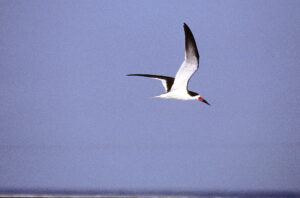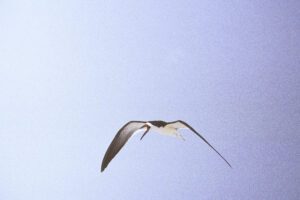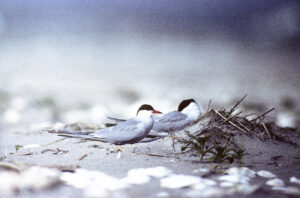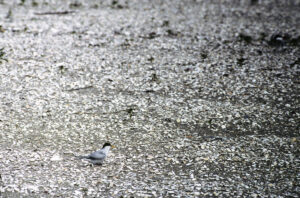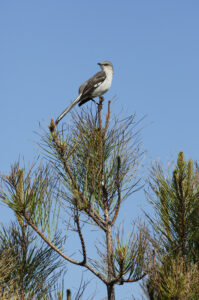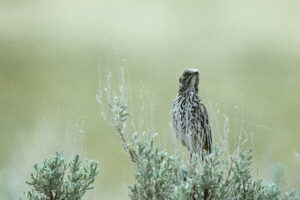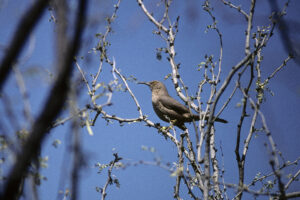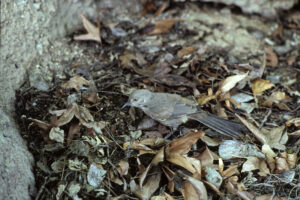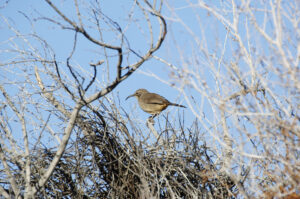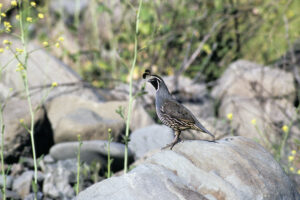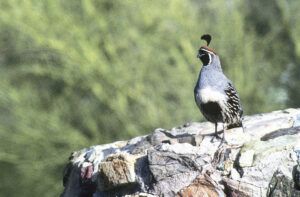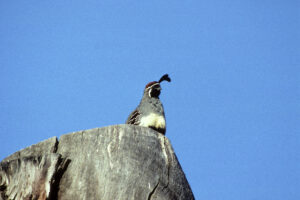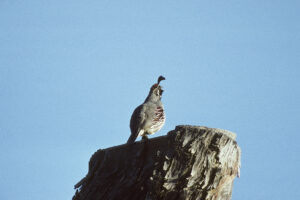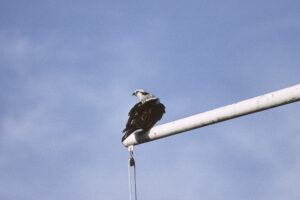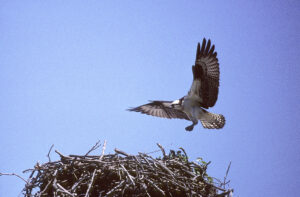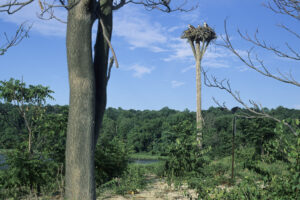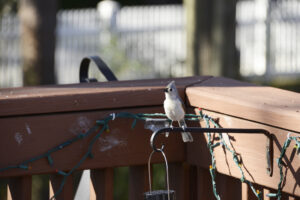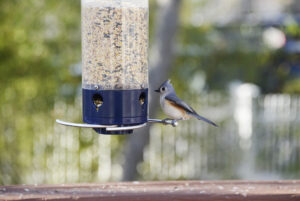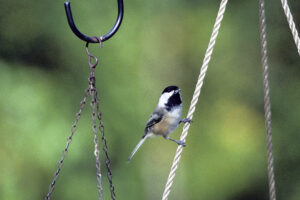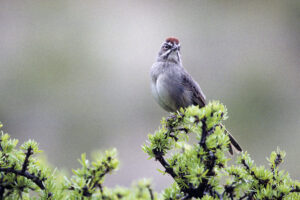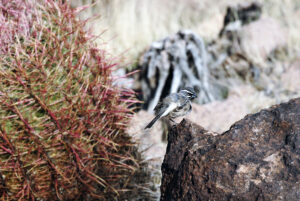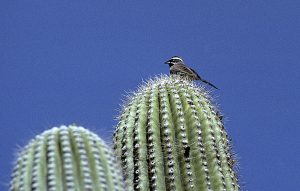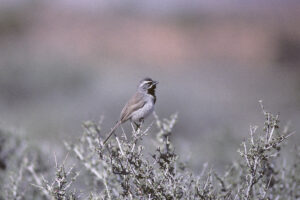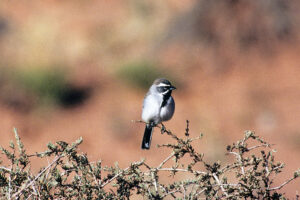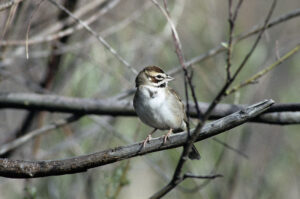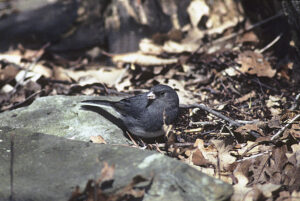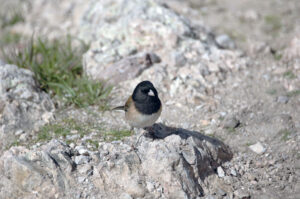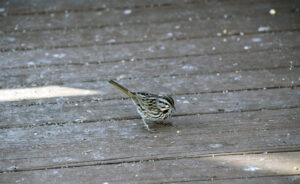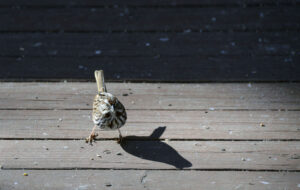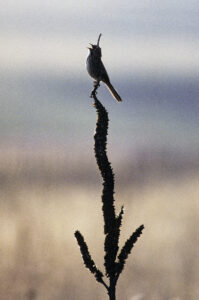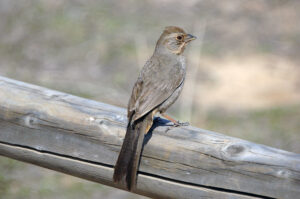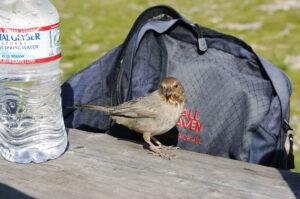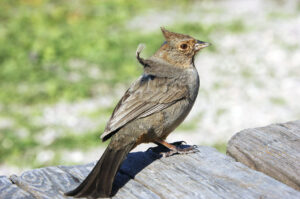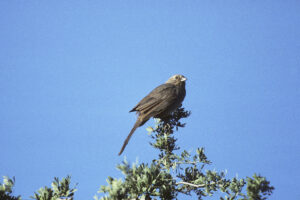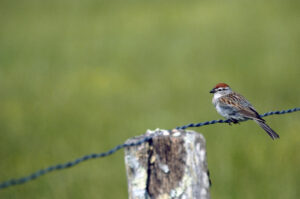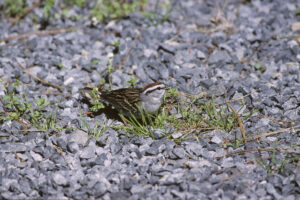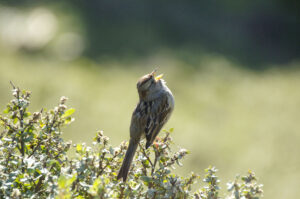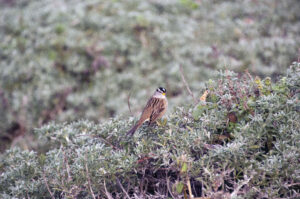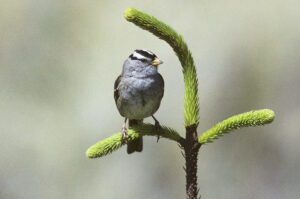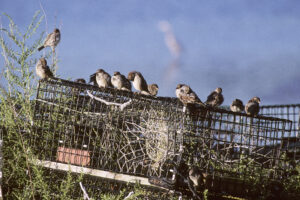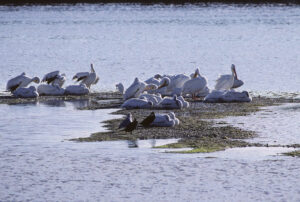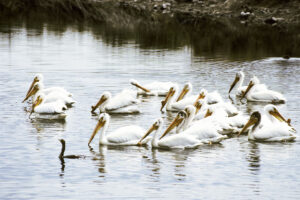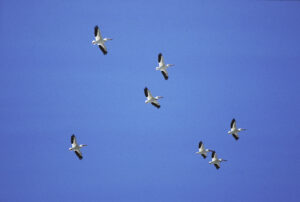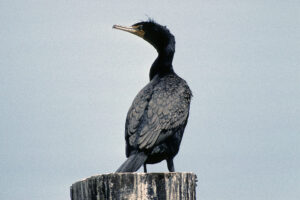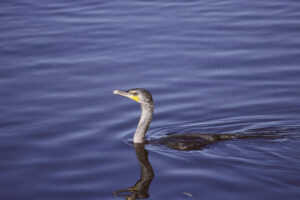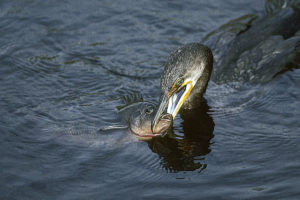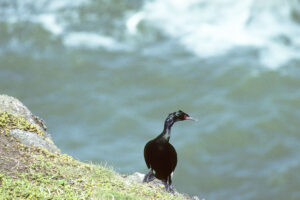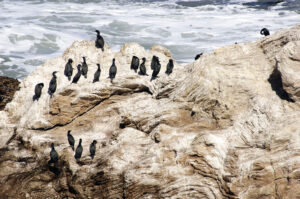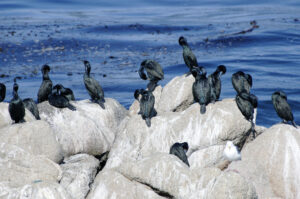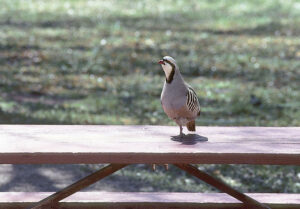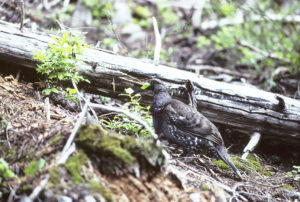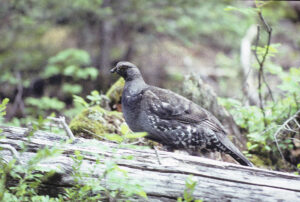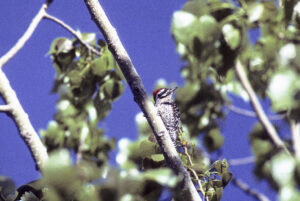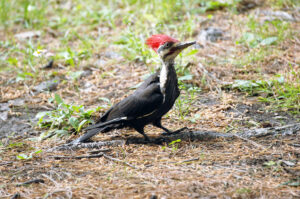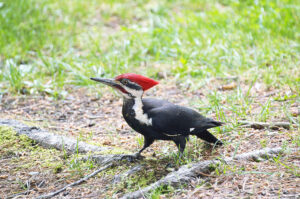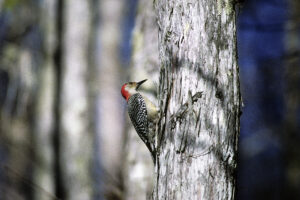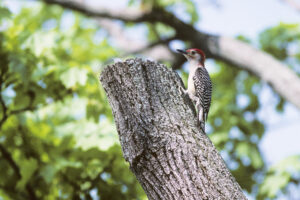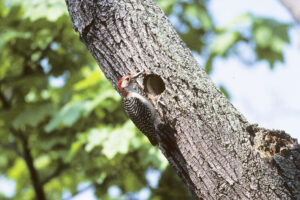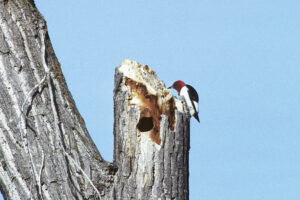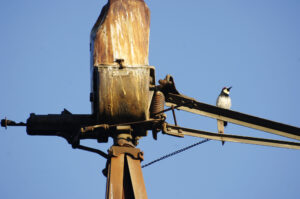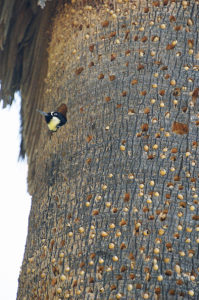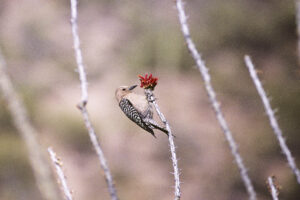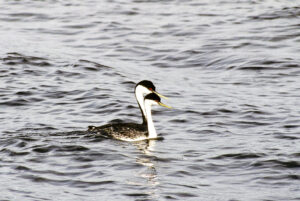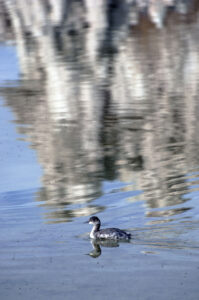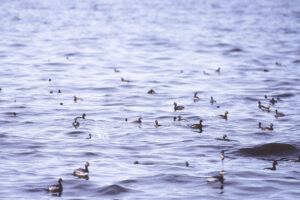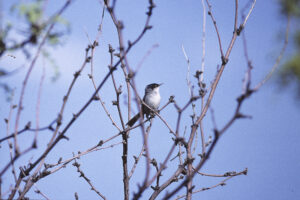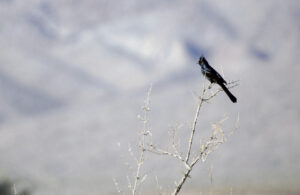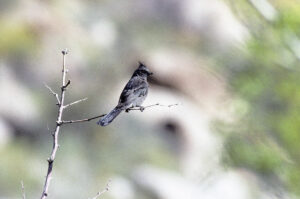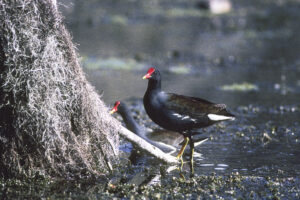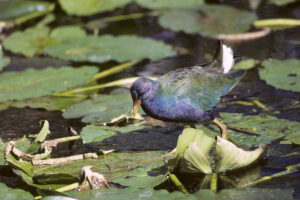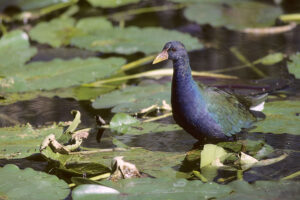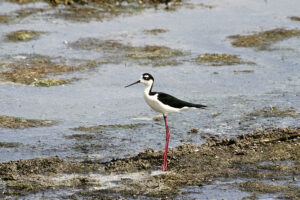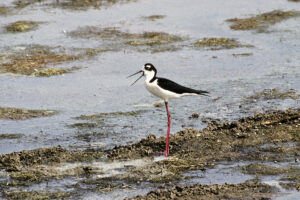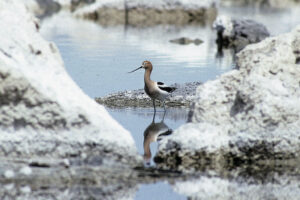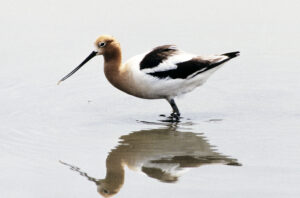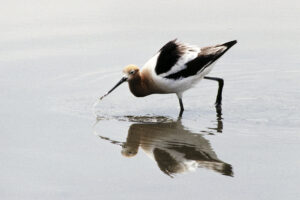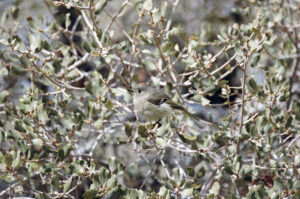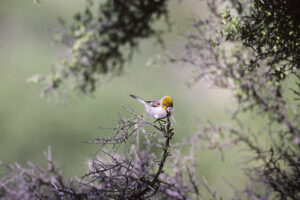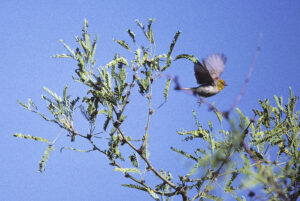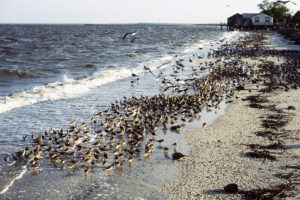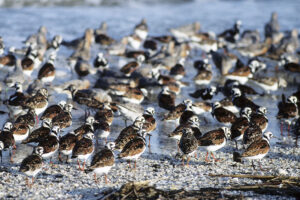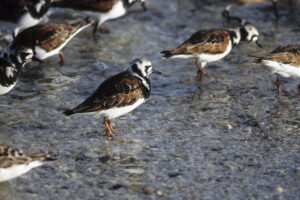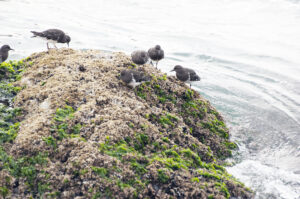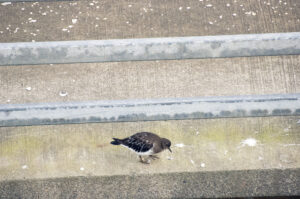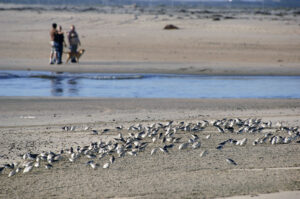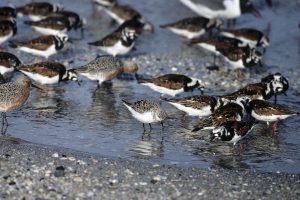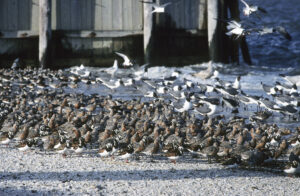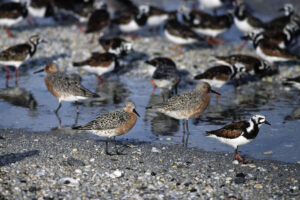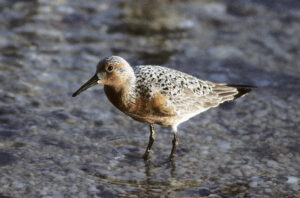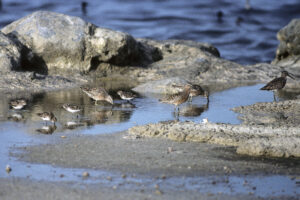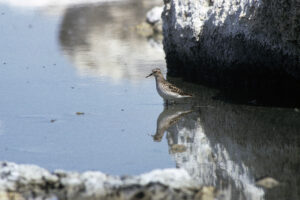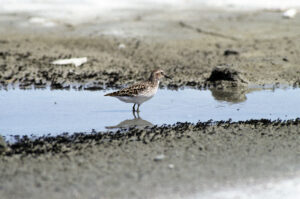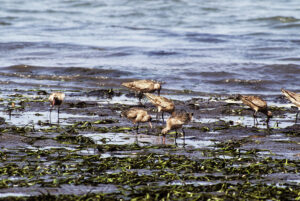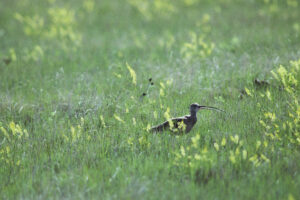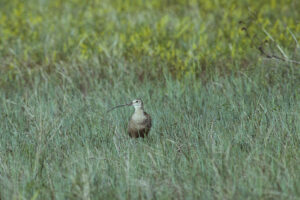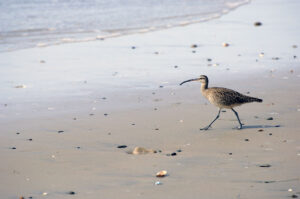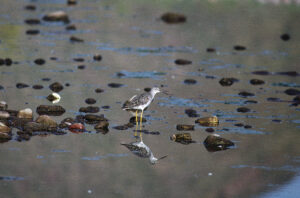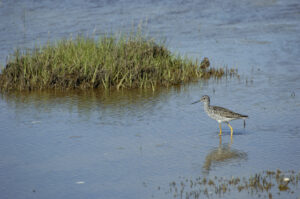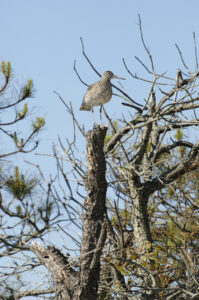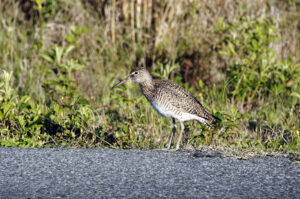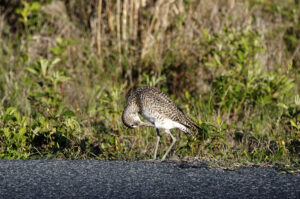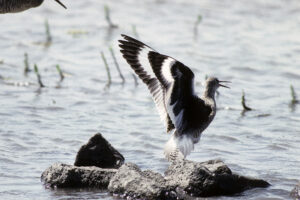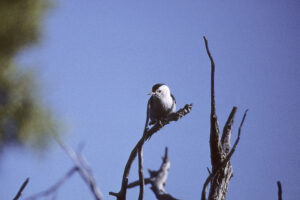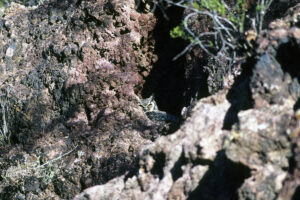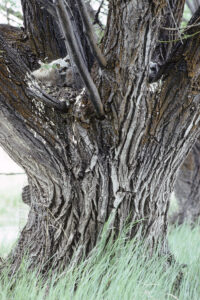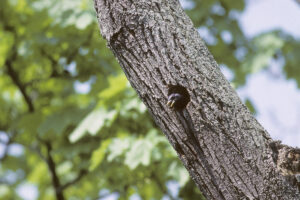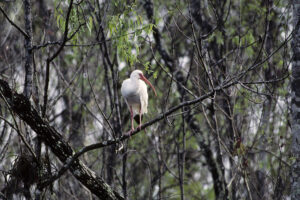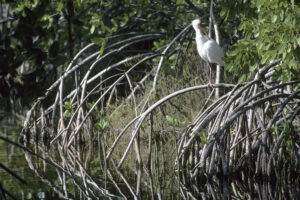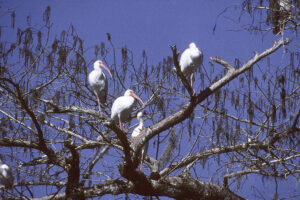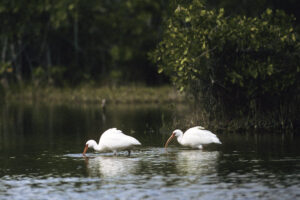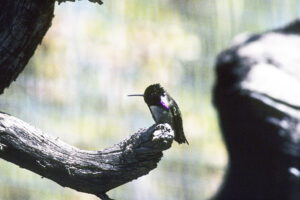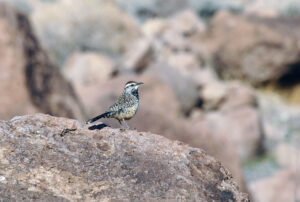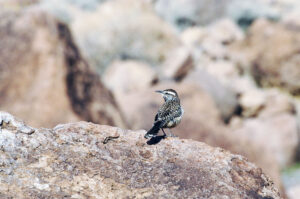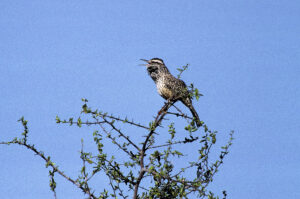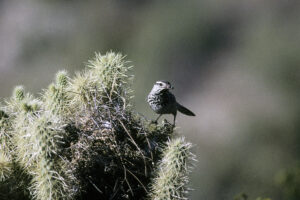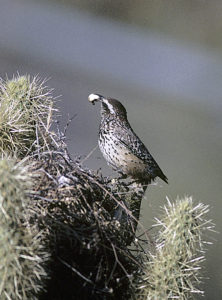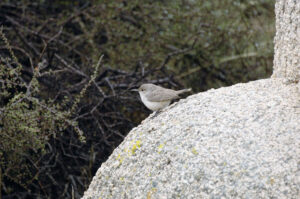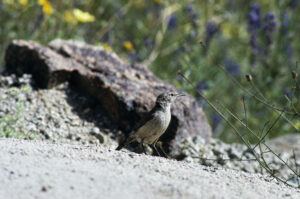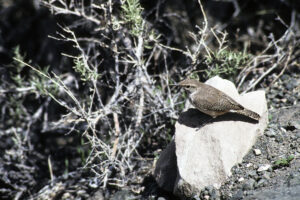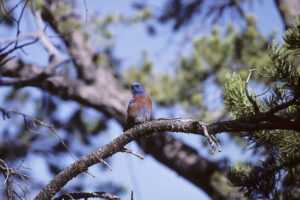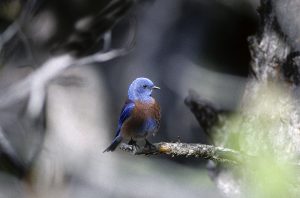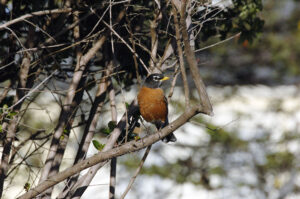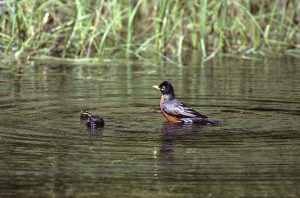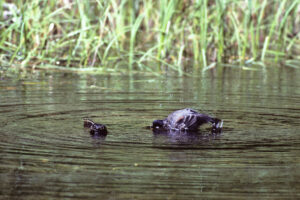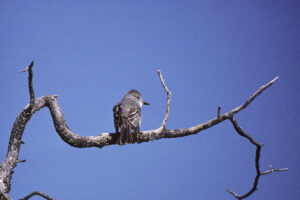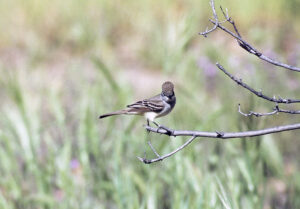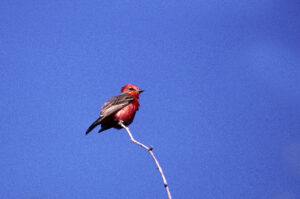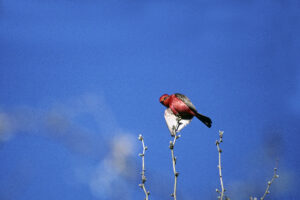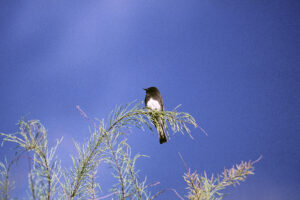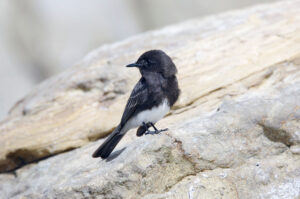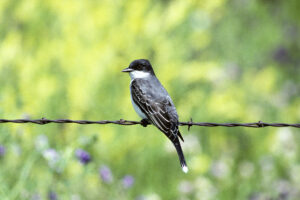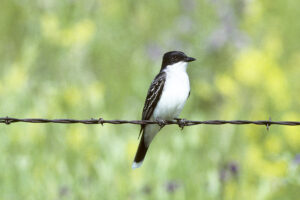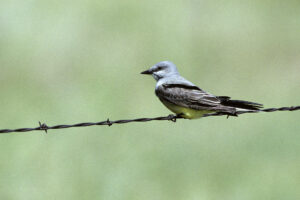Birds in the United States and Canada
A male yellow-headed blackbird (Xanthocephalus xanthocephalus) marks his territory by singing from a fence post, near Bridgeport, eastern California. (Photo copyright © by Kaj Halberg)
American white ibises (Eudocimus albus), taking off, Wakulla Springs, Florida. (Photo copyright © by Kaj Halberg)
Male American robin (Turdus migratorius) in morning light, Shenandoah National Park, Virginia. (Photo copyright © by Kaj Halberg)
American white pelicans (Pelecanus erythrorhynchos), Klamath National Wildlife Refuge, California. One bird shows its enormous gular pouch, which swells tremendously, when the bird is fishing – like some kind of basket. The bird with greyish head is an immature. (Photo copyright © by Kaj Halberg)
Grey jay (Perisoreus canadensis), Garibaldi Provincial Park, British Columbia. (Photo copyright © by Kaj Halberg)
“Off in the river stood a great blue heron. It was a tall bird to begin with, but something about the angle, from which they viewed it, and the cast of the low sun, made it seem even taller. It looked high as a man in the slant light with its long shadow blown out across the water. Its legs and the tips of its wings were black as the river. The beak of it was black on top and yellow underneath, and the light shone off it with muted sheen as from satin or chipped flint. The heron stared down into the water with fierce concentration. At wide intervals it took delicate slow steps, lifting a foot from out the water and pausing, as if waiting for it to quit dripping, and then placing it back on the river bottom in a new spot apparently chosen only after deep reflection.”
American author Charles Frazier (born 1950), in his excellent novel Cold Mountain, 1997.
This page shows pictures of the various bird species that I have managed to photograph in the United States and Canada.
Families, genera, and species are presented in alphabetical order. Nomenclature largely follows the IOC World Bird List (worldbirdnames.org). Information about etymology is often based on J.A. Jobling, 2010. The Helm Dictionary of Scientific Bird Names, Christopher Helm, London.
In case you encounter any errors on this page, I would be grateful to hear about it. You can use the address at the bottom of the page.
Accipitridae Hawks, eagles, and allies
A huge family, comprising about 66 genera and c. 250 species of small to large raptors, distributed worldwide, with the exception of Antarctica.
Buteo Buzzards
Members of this genus, counting about 28 species, are distributed on all continents, except Australia and Antarctica. In the Old World, these birds are known as buzzards, whereas the word hawk is often used in North America.
The generic name is the classical Latin name of the common buzzard (Buteo buteo).
Buteo lineatus Red-shouldered hawk
There are 5 subspecies of this raptor, varying in the amount of reddish-brown on the chest. It lives in open forest, breeding from south-eastern Canada southwards east of the Great Plains to Florida and Texas, and also in Oregon, California, and Baja California. The northernmost populations are migratory, wintering as far south as central Mexico. Outside the breeding season, some individuals of the resident populations stray quite far from the breeding area, and the species may be seen in almost any of the lower American states.
The specific name is Latin, meaning ‘lined’, alluding to the white horizontal stripes on the rufous breast.
Red-shouldered hawk of the Florida subspecies, extimus, the smallest and palest of the 5 subspecies, photographed in Loxahatchee National Wildlife Refuge (top), Everglades National Park (centre), and J. N. Darling National Wildlife Refuge. (Photos copyright © by Kaj Halberg)
Red-shouldered hawk of the westernmost subspecies, elegans, which is reddish-brown on the chest, but paler than the nominate subspecies. – Point Lobos State Reserve, California. (Photo copyright © by Kaj Halberg)
Buteo regalis Ferruginous hawk
This bird is the largest of the Buteo species in America, only slightly smaller than the upland buzzard (B. hemilasius) of Asia. It breeds in interior open grasslands and shrublands, from southern British Columbia, Alberta, and Saskatchewan southwards to Arixona, New Mexico, and extreme north-western Texas. Northern populations are migratory, wintering in southern U.S. and Mexico. Its diet includes a vast number of various mammals and birds, and also snakes and larger insects. It is often encountered in prarie dog (Cynomys) colonies.
The specific name is Latin, meaning ‘royal’, derived from regis, genitive of rex (‘king’). The common name means ‘rust-coloured’, borrowed from Latin ferrugineus, which is derived from ferrugo (‘rust’).
Ferruginous hawk, Badlands National Park, South Dakota. In the bottom picture, it sends out a cascade of excreta. (Photos copyright © by Kaj Halberg)
Buteo swainsoni Swainson’s hawk
This species breeds in a huge area in western United States, and also in eastern Alaska, southern Canada, and northern Mexico. Almost all birds are migratory, wintering in southern Brazil, Argentina, and Uruguay. A few birds may be seen in winter in Texas, Florida, and western Mexico.
The specific name honours English naturalist and artist William Swainson (1789-1855), who brought back to England a huge collection from Brazil and other places, including over 20,000 insects, 1,200 species of plants, drawings of 120 species of fish, and about 760 bird skins.
While he was generally regarded as having some expertise in zoology, his botanical career turned out to be disastrous. William Jackson Hooker (1785-1865), the first director of the famous Kew Botanical Gardens, wrote about him: “In my life I think I never read such a series of trash and nonsense. There is a man who left this country with the character of a first rate naturalist (though with many eccentricities), and of a very first-rate natural history artist, and he goes to Australia and takes up the subject of botany, of which he is as ignorant as a goose.”
Swainson’s hawk, Alamogordo, New Mexico. A gust of wind ruffles its plumage. (Photo copyright © by Kaj Halberg)
Alaudidae Larks
This family contains 21 genera with about 100 species, distributed in Africa and Eurasia, with a single species reaching the Americas, and Australia, respectively.
Eremophila Horned larks, shore larks
This genus contains only 2 species.
The generic name is derived from Ancient Greek eremos (‘desert’) and phileo (‘to love’), alluding to the preferred habitat of Temminck’s lark (E. bilopha), which was described in 1823 by Dutch zoologist and museum director Coenraad Jacob Temminck (1778-1858). Initially, it was placed in the genus Alauda, but both horned larks were moved to Eremophila in 1828 by German zoologist and lawyer Friedrich Boie (1789-1870).
Eremophila alpestris Horned lark, shore lark
As opposed to most other larks, this species has a striking appearance, with a black stripe from the base of the bill to the eye and further down the cheek, a black breast-band, and a narrow, black, semicircular ‘crown’. In the breeding plumage, the ‘crown’ of the male is extended into two small tufts, which gave rise to the popular name.
No less than about 42 subspecies of this bird have been described, distributed across most of the Northern Hemisphere, along the Arctic coasts from Scandinavia eastwards to Alaska and north-eastern Canada, southwards to Mexico, with an isolated population in Columbia. It is also found in the major part of Central Asia, southwards to the Himalaya, westwards to Ukraine, the Middle East, and the Balkans, with an isolated population in the Atlas Mountains of north-western Africa. Arctic populations are migratory.
Horned lark, Badlands National Park, South Dakota. (Photo copyright © by Kaj Halberg)
Horned lark, feeding on a gravel plain, Petrified Forest National Park, Arizona. (Photo copyright © by Kaj Halberg)
Anatidae Ducks, geese, and swans
At present, this large worldwide family contains 43 genera with about 146 species.
Anas
Many former members of this genus have been moved to other genera, and today Anas contains about 31 species.
The generic name is the classical Latin word for duck.
Anas acuta Northern pintail
Avoiding the harshest areas of the Arctic, this duck, which was named due to its long, pointed tail, breeds across the Northern Hemisphere, from Iceland, Norway, and Denmark eastwards to the Pacific, and also from Alaska and Canada southwards to central United States. It is a scarce breeding bird in central and eastern Europe, and in Turkey.
The winter months are spent in the southern half of North America, in Central America and the Caribbean, in the major part of Europe and the Middle East, in northern and eastern Africa, and in the Indian Subcontinent, Indochina, southern China, Taiwan, and the northern Philippines.
The specific name is Latin, meaning ‘sharp-pointed’, alluding to the pointed tail.
Pair of northern pintail, and a preening American coot (Fulica americana), Sacramento National Wildlife Refuge, California. (Photo copyright © by Kaj Halberg)
Anas rubripes American black duck
This species is found in eastern North America, from eastern Manitoba eastwards to Newfoundland, southwards to the Great Lakes and New Jersey, and thence along the coast to North Carolina. Northern populations are migratory, wintering from the Great Lakes and south-eastern Canada southwards to Mississippi and northern Florida.
It is a close relative of the widespread mallard (A. platyrhynchos), and the two species often interbreed, which can make identification of pure black ducks difficult.
The specific name is derived from the Latin ruber (‘ruddy’) and pes (‘foot’).
American black ducks, Mill Neck Creek, Long Island, New York State. (Photos copyright © by Kaj Halberg)
Anser Geese
This genus contains about 11 species, restricted to the Northern Hemisphere.
The generic name is the classical Latin word for geese.
Anser albifrons White-fronted goose
This bird is divided into 5 subspecies, breeding along the entire northern Siberian coastal areas, in Alaska and northern Canada, and western Greenland. The wintering areas include northern Ireland, northern Scotland, Holland, northern Germany, Hungary, the northern Black Sea coast, Iraq, the southern coast of the Caspian Sea, Japan, Korea, south-eastern China, southern United States, and northern Mexico.
The specific name is derived from the Latin albus (‘white’) and frons (‘forehead’), like the common name referring to the white feathers at the base of its bill. The salt-and-pepper markings on the breast of adult birds are distinctive of this species as well. These markings have given rise to a popular American name, specklebelly.
White-fronted geese, Sacramento National Wildlife Refuge, California. The black birds in the lower picture are American coot (Fulica americana). (Photos copyright © by Kaj Halberg)
Anser caerulescens Snow goose
This species comes in two colour morphs, a snow-white phase, which has given the bird its common name, and a bluish-grey phase, referred to as ‘blue goose’, which has given it the specific name, which means ‘bluish’.
The snow goose is mainly a bird of the New World, breeding in northern Canada and Alaska, with small populations in Greenland and north-eastern Siberia. It spends the winter along the Pacific coast, from southern British Columbia southwards, and also in southern United States and Mexico.
Snow goose, white phase, Sacramento National Wildlife Refuge, California. (Photo copyright © by Kaj Halberg)
Snow goose, blue phase, Funk National Wildlife Refuge, Nebraska. (Photo copyright © by Kaj Halberg)
Anser rossii Ross’s goose
This species looks like a miniature snow goose, with a small bill and a relatively short neck. It breeds in the Canadian High Arctic, wintering in California, south-central United States, and northern Mexico. Previously, this goose was quite rare due to hunting, but numbers have increased dramatically as a result of conservation measures.
It was named in honour of Bernard R. Ross (1827-1874), who worked for the Hudson Bay Company in Canada’s Northwest Territories.
Ross’s goose, Klamath National Wildlife Refuge, California. (Photo copyright © by Kaj Halberg)
Aythya
This genus, comprising 12 species, is chiefly distributed in the Northern Hemisphere, with one species occurring in New Guinea, Australia, New Zealand, and on some Pacific islands, another one in New Zealand, and one in Madagascar. Two species are critically endangered, the East Asian Baer’s pochard (A. baeri) and Madagascar pochard (A. innotata).
The generic name is derived from Ancient Greek aithyia, an unidentified seabird, mentioned by Greek grammarian Hesychius of Alexandria (5th or 6th Century A.D.), and also by Greek philosopher and scientist Aristotle (384-322 B.C.).
Aythya collaris Ring-necked duck
This common duck lives in freshwater ponds and lakes. As a breeding bird, it is distributed from eastern Alaska and north-central Canada southwards to north-western and north-eastern United States. Most populations are migratory, spending the winter in western and southern United States, Mexico, Central America, and the Caribbean.
The specific name is Latin, meaning ‘necked’, derived from collum (‘neck’), in this case referring to a narrow cinnamon-coloured ring around the neck of the male, although this is often very hard to see.
Gathering of mixed waterfowl: Ring-necked duck (one beating its wings), Canada goose (Branta canadensis), American wigeon (Mareca americana), canvasback (Aythya valisineria), and ruddy duck (Oxyura jamaicensis), Stump Pond, Blydenburgh County Park, Long Island, New York State. (Photo copyright © by Kaj Halberg)
Branta Brent geese, brant geese
A small genus with 6 species, which breed in arctic, subarctic, and temperate regions of the Northern Hemisphere, with the exception of the Hawaiian goose (Branta sandvicensis), which was originally restricted to Hawaii, but has been introduced elsewhere.
The generic name is a Latinized form of brandgás (‘burnt goose’), the Old Norse name of the brent goose (Branta bernicla), referring to the mainly black plumage of this species. In English, ‘burnt’ became ‘brent’.
Branta canadensis Canada goose
Seven subspecies of this very common bird breed in North America, from Alaska and northern Canada southwards to the northern third of the United States. It has also been introduced to Britain, Sweden, New Zealand, Argentina, and other places. It is very bold and has been able to establish populations in urban areas, where it has no natural predators. In many areas, it has been declared a pest because of its noise, droppings, and aggressive behaviour.
A large congregation of Canada goose, American wigeon (Mareca americana), ring-necked duck (Aythya collaris), and surf scoter (Melanitta perspicillata), Coos Bay, Oregon. (Photo copyright © by Kaj Halberg)
Canada geese with goslings, Buttle Lake, Vancouver Island. Tree trunks are reflected in the lake. (Photo copyright © by Kaj Halberg)
Canada geese with goslings, Klamath National Wildlife Refuge, California. (Photo copyright © by Kaj Halberg)
Grazing Canada geese are often a nuisance on golf courses, in this case at Glen Cove, Long Island, New York State. (Photo copyright © by Kaj Halberg)
Bucephala
This genus contains only 3 species, the bufflehead (below), Barrow’s goldeneye (B. islandica), which lives in North America and Iceland, and common goldeneye (B. clangula), which is widely distributed in the Northern Hemisphere.
The generic name is derived from Ancient Greek bous (‘bull’) and kephale (‘head’), alluding to the odd head shape of these birds.
Bucephala albeola Bufflehead
The small bufflehead breeds in taiga forests of Alaska and Canada, eastwards to western Quebec, southwards almost to the border with the United States. There are disjunct resident populations in Oregon, northern California, Montana, and Wyoming. The entire northern population migrates south, spending the winter along the Alaskan and Canadian Pacific coast, in the entire United States, and in northern Mexico.
The specific name is a diminutive of the Latin albus (‘white’), thus ‘small white’ (duck). The common name refers to the head shape, a combination of ‘buffalo’ and ‘head’.
Male bufflehead, stretching its wings, Mill Neck Creek, Long Island, New York State. (Photo copyright © by Kaj Halberg)
Cygnus Swans
A genus of 6 long-necked birds, distributed on all continents except Antarctica. Genetic research indicates that the coscoroba swan (Coscoroba coscoroba) of South America is not a true swan, but more closely related to geese or shelducks.
The generic name is a Latinized form of the classical Greek term for swans, kyknos.
Cygnus columbianus Tundra swan
This smallish swan reaches a length of about 1.2 m, having a wingspan up to 2.1 m, and weighing up to 6.5 kg. Most authorities recognize two subspecies, the whistling swan (ssp. columbianus), which lives in North America, and Bewick’s swan (ssp. bewickii), which is found in Eurasia. Some authorities regard the two subspecies as separate species. They differ in bill colour, Bewick’s swan having a fairly large patch of yellow skin at the base of the bill, wheareas the whistling swan has dark skin with only a small yellow spot at the base.
If you regard these birds as a single species, it breeds in Arctic areas of Alaska and Canada, and in the northernmost parts of Siberia. The wintering areas of the whistling swan include several separate areas in western Canada, United States, and Mexico, and the central part of the Atlantic coast. Eastern populations of Bewick’s swan spend the winter in eastern China, Korea, and Japan, whereas western populations migrate to western Europe.
The total population of the whistling swan is around 200,000, and is slightly increasing. The population of Bewick’s swan is much smaller, less than 50,000, but is probably stable.
In 1803, American President Thomas Jefferson (1743-1826) ordered two army captains, Meriwether Lewis (1774-1809) and William Clark (1770-1838), to undertake an expedition across the western part of the North American continent, from the Mississippi River to the Pacific Ocean. During their 3-year long expedition, Lewis described countless plants and animals, many of which were new to science, including the tundra swan. The whistle-like call of the bird prompted Lewis to name it whistling swan.
The specific name refers to the Columbia River, the type locality of the whistling swan.
Bewick’s swan was named in 1830 by English naturalist William Yarrell (1784-1856) in honour of English engraver Thomas Bewick (1753-1828), who specialized in illustrations of birds and other animals. He is best known for the work A History of British Birds, which contains many fine wood engravings. He also illustrated several editions of Aesop’s Fables.
Tundra swan, Klamath National Wildlife Refuge, California. (Photo copyright © by Kaj Halberg)
Mareca Wigeons and allies
A small genus with 5 species, comprising 3 species of wigeon, the gadwall (see below), and the falcated teal (M. falcata). Previously, they were all included in the genus Anas.
The generic name is derived from Brazilian-Portuguese marréco, meaning ‘small duck’.
Mareca americana American wigeon
This common and widespread duck breeds in forest wetlands of Alaska, the major part of Canada, and in the north-western United States, from eastern Washington and Oregon through Idaho, Colorado, and the Dakotas to Minnesota. The winter is spent in south-western Canada, most of the U.S., Mexico, Central America, north-western South America, and the Caribbean.
Male and female American wigeon, Wakulla Springs, Florida. (Photo copyright © by Kaj Halberg)
Mareca strepera Gadwall
This duck is very widely distributed, breeding in southern Canada and northern and western United States, and from England and Spain eastwards across the taiga belt to the Pacific Ocean, and the Japanese island Hokkaido. It winters in most of the United States and Mexico, in western and southern Europe, northern and north-eastern Africa, the Middle East, the northern part of the Indian Subcontinent, and in southern China.
The specific name is Latin, meaning ‘noisy’ – a strange name for this bird, which is not very noisy.
Male gadwall, Cathlamet, near Columbia River, Washington State. (Photo copyright © by Kaj Halberg)
Gadwall, male and female, Cold Spring Harbor, Long Island, New York State. (Photo copyright © by Kaj Halberg)
Mergus Mergansers
Mergansers are 4 species of fish-eating ducks, of which two, the common merganser (below) and the red-breasted merganser (M. serrator), are widely distributed across the Northern Hemisphere, whereas the Brazilian merganser (M. octosetaceus) and the scaly-sided merganser (M. squamatus) of China are highly endangered.
The generic name is a Latin word, used by Roman naturalist Pliny the Elder (23-79 A.D.) as the name of an unspecified waterbird.
Previously, two other ducks were included in the genus, the hooded merganser, now called Lophodytes cucullatus, and the smew, today named Mergellus albellus. Research has shown that they are not closely related to mergansers.
Mergus merganser Common merganser, goosander
The common merganser, in Europe called goosander, nests in holes in trees. It is found in rivers and lakes in forested areas of Europe, northern and central Asia, and North America, as far south as the central Rocky Mountains, Pennsylvania, the Alps, the southern part of the Tibetan Plateau, and north-eastern China. Northern populations are migratory, spending the winter as far south as northern Mexico, Turkey, the Himalaya, and southern China.
The specific name is a concoction of the generic name and the Latin anser (‘goose’).
Male common merganser, Montezuma Well, Arizona. (Photo copyright © by Kaj Halberg)
Oxyura Stiff-tailed ducks
These ducks, comprising 6 species, are very distinctive, often raising their tail upwards. They are found across large parts of the globe, with 3 species in the Americas, one in Africa, one in southern Europe, the Middle East, and Central Asia, and one in Australia.
Breeding males are a rich chestnut brown, females and non-breeding males brownish.
The generic name is derived from Ancient Greek oxys (‘sharp’) and oura (‘tail’).
Oxyura jamaicensis Ruddy duck
A common species, breeding in western Canada, United States, and Mexico, around the Great Lakes, on the central part of the Atlantic coast, and in the Caribbean. Outside the breeding season, it is found in the western and southern United States, Mexico, and the Caribbean.
It has been introduced to several places in Europe, where it is regarded as an invasive species that competes with local ducks. In southern Europe, it interbreeds with the rare white-headed duck (O. leucocephala), polluting the gene pool. Efforts have been made to eradicate the ruddy duck from Europe.
Pair of ruddy duck, Klamath National Wildlife Refuge, California. (Photo copyright © by Kaj Halberg)
Spatula Shovelers and allies
The ducks of this genus, comprising 10 species of shovelers and teals, were formerly placed in the genus Anas. The genus Spatula had originally been proposed in 1822 by German zoologist and lawyer Friedrich Boie (1789-1870), who described many new species and several new genera of birds. He and his brother Heinrich also described about 50 new species of reptiles.
The generic name is the Latin word for ‘spoon’ or ‘spatula’, alluding to the spatulate bill of shovelers.
Spatula clypeata Northern shoveler
As a breeding bird, this species is widely distributed across the northern hemisphere, avoiding the harshest areas of the Arctic. It is found from Iceland, the British Isles, Spain, and Morocco eastwards across the taiga belt to the Pacific, and also in Alaska and western North America, southwards almost to the Mexican border.
The winter months are spent in the southern half of North America, in Central America and the Caribbean, in the major part of Europe and the Middle East, in northern and eastern Africa, and in the Indian Subcontinent, Southeast Asia, southern China, Korea, Japan, Taiwan, and the northern Philippines.
The specific name is Latin, meaning ‘shield-bearing’, alluding to the broad and flat bill.
Feeding pair of northern shoveler, Sacramento National Wildlife Refuge, California. (Photo copyright © by Kaj Halberg)
Anhingidae Darters
Darters, also called snakebirds due to their long, thin, flexible neck, are large water birds, comprising two or four species in the genus Anhinga, the sole genus of the family. The American darter (below), often called anhinga, lives in the New World.
One or three species are found in the Old World. If only one species is acknowledged, it is called A. melanogaster. Most authorities, however, recognize three full species: Oriental (A. melanogaster), African (A. rufa), and Australasian (A. novaehollandiae).
The generic name means ‘little head’ in the Tupi language of Brazil, referring to an evil spirit of the forests, the devil bird. (Source: G. Marcgrave 1648. Historiae rerum naturalium Brasiliae. Liber V)
Anhinga anhinga American darter
This bird lives in swamps in warmer areas, found in a coastal belt from southern South Carolina southwards to Texas, on Cuba and surrounding islands, along both coasts of Mexico and Central America, and in South America east of the Andes, southwards to northern Argentina and Uruguay. Some birds stray far from the breeding area. In the U.S., the species has been observed as far north as Pennsylvania and Wisconsin.
American darter, drying its wings, sitting in a bald cypress (Taxodium distichum), Big Cypress National Preserve, Florida. (Photo copyright © by Kaj Halberg)
American darter, Everglades National Park, Florida. The white flowers in the background are swamp lilies (Crinum americanum). (Photo copyright © by Kaj Halberg)
American darter, resting in a bald cypress (Taxodium distichum), Big Cypress National Preserve. (Photo copyright © by Kaj Halberg)
Seen against the light, this American darter is drying its wings, Big Cypress National Preserve. (Photo copyright © by Kaj Halberg)
Aramidae
Aramus guarauna Limpkin
This large bird, the only member of the family, is related to rails and cranes. It lives in wetlands in warmer regions, in the United States in the Okefenokee Swamp in southern Georgia and in Florida, in the Caribbean, in southern Mexico and Central America, and in South America east of the Andes, southwards to northern Argentina and Uruguay.
Its diet consists of molluscs, mainly apple snails (Pomacea).
The generic name is a Latinized version of Ancient Greek aramos, a type of heron mentioned by Greek grammarian Hesychius of Alexandria (5th or 6th Century A.D.). The specific name is the name of some marshbird in the exrinct Tupi language of Brazil. The common name stems from the gait of the bird, looking as if it limps.
Preening limpkin, standing in a large growth of water cabbage (Pistia stratiotes), Corkscrew Swamp Sanctuary, Florida. (Photos copyright © by Kaj Halberg)
This limpkin has caught a Florida apple snail (Pomacea paludosa), Lake Woodruff, Florida. (Photo copyright © by Kaj Halberg)
Ardeidae Herons, egrets, and bitterns
Herons, comprising 18 genera with about 64 species, are long-legged and long-beaked, fish-eating water birds, distributed worldwide with the exception of the polar regions. Some species are called egrets, mainly birds with ornate plumes during the breeding season, whereas birds of the genera Botaurus, Ixobrychus, and Zebrilus are called bitterns.
Many members of the family are presented on the pages Fishing, and Animals – Birds: Birds in Taiwan.
Ardea
A genus with about 13 species of mainly large herons, distributed almost worldwide.
The generic name is the classical Latin word for herons.
Ardea alba Great white egret
A large heron with an almost global distribution, found in Europe, Africa, most of Asia, Australia, and the Americas. Traditionally, it was placed in the genus Egretta (below), mainly due to its white plumage. Some authorities have also placed it in a separate genus, Casmerodius. However, it shows many affinities to large herons in the genus Ardea.
The specific name is Latin, meaning ‘white’.
Breeding colony of great white egret, Avery Island, Louisiana. In the breeding season, large plumes grow out from its back. (Photos copyright © by Kaj Halberg)
Feeding great white egret, Avery Island. (Photo copyright © by Kaj Halberg)
Great white egrets, Mill Neck Creek, Long Island, New York State. (Photos copyright © by Kaj Halberg)
Ardea herodias Great blue heron
This is the largest heron in America – in fact the world’s third-largest heron, only surpassed by goliath heron (A. goliath) and white-bellied heron (A. insignis). It is a common bird, breeding from central Canada southwards to Central America and the Caribbean, with a separate population in the Galápagos Islands. The northernmost populations are migratory, spending the winter as far south as northern South America. Some birds in southern Florida and the Caribbean are pure white, and it is still discussed whether they form a separate species.
The specific name is derived from Ancient Greek erodios, the classical name of herons.
Great blue heron, feeding on a grassy plain in Ronald W. Caspers Wilderness Park, Santa Ana Mountains, California. (Photos copyright © by Kaj Halberg)
Great blue heron, taking off, Roosevelt Lake, Arizona. (Photo copyright © by Kaj Halberg)
Feeding great blue heron, Loxahatchee National Wildlife Refuge, Florida. (Photo copyright © by Kaj Halberg)
Great blue heron, depicted on pavement tiles in Taiwan, with a Chinese text. They must have been delivered by an American company, as the species has never been observed in Asia. (Photo copyright © by Kaj Halberg)
Butorides
Most authorities recognize 3 small herons of this genus as separate species, the green heron (below), the widespread striated heron (B. striata), and the lava heron (B. sundevalli), which is endemic to the Galapagos Islands. Others regard them as being conspecific.
The generic name is derived from Middle English botor (‘bittern’), and Ancient Greek oides (‘resembling’).
Butorides virescens Green heron
This small heron is breeding in the eastern half of the United States and extreme southern Canada, and also along the Pacific coast, from British Columbia southwards. In Mexico and Central America, it is found along both coasts, eastwards to Panama. It is also a resident in the entire Caribbean. Northern populations are migratory, wintering in southern U.S., Mexico, and Central America.
The specific name is Latin, meaning ‘greenish’.
Green herons, Everglades National Park, Florida. (Photos copyright © by Kaj Halberg)
A patch of sunshine illuminates this green heron, sitting on a mangrove aerial root, J. N. Darling National Wildlife Refuge, Florida. (Photo copyright © by Kaj Halberg)
Egretta Egrets
The major part of the 12 small to medium-sized herons in this genus breed in warmer areas around the globe. Most members have black legs with bright yellow toes, and many develop ornate plumes during the breeding season.
The generic name is derived from Provençal French aigrette, a diminutive of aigron (‘heron’).
Egretta caerulea Little blue heron
This small heron is widely distributed in coastal areas in the southern part of North America and along the east coast to Maine, in Central America, and in South America southwards to Peru and southern Brazil. It lives in freshwater as well as brackish water. Northern populations are migratory, wintering in the Caribbean and Central America. After the breeding season, birds may stray northwards to southern Canada, southwards to Uruguay.
The specific name is Latin, meaning ‘blue’.
Little blue heron, feeding among aerial roots of red mangrove (Rhizophora mangle), J. N. Darling National Wildlife Refuge, Florida. (Photo copyright © by Kaj Halberg)
Little blue heron, resting on aerial roots of red mangrove (Rhizophora mangle), J. N. Darling National Wildlife Refuge. (Photo copyright © by Kaj Halberg)
Little blue heron, Everglades National Park, Florida. (Photo copyright © by Kaj Halberg)
Egretta rufescens Reddish egret
This smallish heron breeds in coastal marshes, distributed in Mexico, Central America, the Caribbean, and the Gulf States of the United States.
The specific name is Latin, meaning ‘reddish’, derived from rufus (‘red’).
In these pictures from J. N. Darling National Wildlife Refuge, Florida, a reddish egret is squabbling with a young double-crested cormorant (Nannopterum auritum). (Photos copyright © by Kaj Halberg)
Egretta thula Snowy egret
This small heron, which was named after its snow-white plumage, breeds along both coasts, from Oregon and Massachusetts southwards to Central America, in the Caribbean, and in South America, southwards to central Chile and Argentina. It is also found in many scattered locations in the interior United States, where populations are migratory, wintering mainly in Mexico and Central America.
It is very similar to the Old World little egret (E. garzetta), which is described on several pages on this website, including Animals – Birds: Birds in Taiwan.
In 1782, the specific name was mistakenly applied to this bird by Chilean Jesuit priest and naturalist Juan Ignacio Molina (1740-1829), who didn’t realize that in fact thula was the local Mapuduncun name for the black-necked swan (Cygnus melancoryphus).
Snowy egret, walking on a floating carpet of bull kelp (Nereocystis luetkeana), Point Lobos State Park, California. (Photo copyright © by Kaj Halberg)
Snowy egret, J. N. Darling National Wildlife Refuge, Florida. (Photo copyright © by Kaj Halberg)
Egretta tricolor Tricolored heron
Also known as Louisiana heron, this species breeds in coastal marshes around the Gulf of Mexico, in Central America and the Caribbean, southwards to Peru and central Brazil.
A bird, which was banded in Virginia in 1958, was shot in the Bahamas in 1976, thus reaching the ripe age of almost 18 years.
The specific name is Latin, meaning ‘having three colours’.
Tricolored heron, perched on a dead tree, Everglades National Park, Florida. (Photo copyright © by Kaj Halberg)
Tricoloured heron, J. N. Darling National Wildlife Refuge, Florida. (Photo copyright © by Kaj Halberg)
Feeding tricolored heron, Everglades National Park. (Photo copyright © by Kaj Halberg)
Bombycillidae
Previously, this family contained a number of genera, but following genetic research, all but Bombycilla have been transferred to other families, including the silky-flycatchers, which are now placed in the family Ptilogonatidae (below).
Bombycilla Waxwings
This small genus contains only 3 species: cedar waxwing (below), Bohemian waxwing (B. garrulus), and Japanese waxwing (B. japonica). These birds move nomadically outside the breeding season, the distance depending on available fruit, which is their main diet. They only migrate far distances in severe winter weather, or when fruits are scarce in their normal wintering areas.
The generic name is in fact a misnomer. French ornithologist Louis Pierre Vieillot (1748-1830) attempted to name the bird ‘silktail’ in Latin, translating the German name Seidenschwanz. He analyzed motacilla, the Latin name of the white wagtail (M. alba), as mota (‘move’) and cilla, which he thought meant ‘tail’. The word is actually derived from motare (‘to move’ or ‘to shake’), and the diminutive suffix illa, thus ‘the little shaker’, alluding to the tail of the white wagtail always bobbing up and down. However, some time during the Middle Ages the belief arose that cilla meant ‘tail’. Vieillot then combined cilla with Ancient Greek bombyx (‘silk’).
The common name alludes to the bright red tips of the secondary feathers on the wings of the Bohemian waxwing, which look like drops of sealing wax.
Bombycilla cedrorum Cedar waxwing
This bird breeds in a very large area, across southern Canada, and thence southwards to northern California, western Nevada, and northern Utah in the west, and to northern Georgia and South Carolina in the east. In winter, it spreads over a huge area, from extreme southern Canada southwards through the entire United States, the western Caribbean, and Mexico, sometimes as far south as Central America and extreme north-western South America.
The specific name is Latin, meaning ‘of cedars’.
Cedar waxwing, eating rose hips, Piedmont National Wildlife Refuge, Georgia. (Photo copyright © by Kaj Halberg)
Cardinalidae
Members of this family, comprising 14 genera, were previously placed in the family Fringillidae (finches).
Cardinalis Cardinals
These colourful birds, comprising 3 species, are distributed from the extreme south-eastern Canada southwards to north-western South America.
The generic and common names allude to the brilliant red plumage of the northern cardinal (below), which resembles the red robes of cardinals. Originally, cardinalis is Latin, meaning ‘principal’ or ‘chief’, short for cardinalis ecclesiae Romanae, that is ‘presbyters of the cardinal (chief) churches of Rome’.
Cardinalis cardinalis Northern cardinal
This familiar bird, divided into 19 subspecies, is resident in a vast area, from extreme south-eastern Canada southwards to Florida, and thence westwards to the Dakotas, Wyoming, and Arizona, southwards through most of Mexico to northern Guatemala and Belize. It has also been introduced to southern California and Hawaii.
Male northern cardinal, Colossal Cave, Arizona. (Photo copyright © by Kaj Halberg)
Male and female northern cardinal on a bird feeder, Mount Sinai, Long Island, New York State. (Photos copyright © by Kaj Halberg)
Young males of northern cardinal are orange-red. – Maudslay State Park, Massachusetts. (Photo copyright © by Kaj Halberg)
Cathartidae New World vultures
This family contains 5 genera with 5 species of vultures and 2 species of condors, distributed from southern Canada southwards to southern South America.
Cathartes
A genus with 3 species.
The generic name is a Latinized form of Ancient Greek kathartes (‘purifier’), referring to these birds getting rid of decomposing carcasses in nature.
Cathartes aura Turkey vulture
This bird is widespread and common, found from southern Canada southwards to the southernmost tip of South America. It lives in a variety of habitats, including forests, shrublands, agricultural areas, and deserts. The northernmost populations migrate south in the winter.
The specific name is Latin, meaning ‘golden’, presumably alluding to the sometimes yellowish head of the two other members of the genus. Once upon a time, they were probably all regarded as a single species. The head of the turkey vulture is always red, similar to the colour of the head of the male turkey.
Soaring turkey vultures, Big Pine Key, Florida. (Photo copyright © by Kaj Halberg)
Turkey vulture, Salt Point State Park, California. (Photo copyright © by Kaj Halberg)
Turkey vulture, Fakahatchee Strand State Park, Florida. (Photo copyright © by Kaj Halberg)
Coragyps atratus Black vulture
This species, the only member of the genus, is widely distributed in America, from southern United States southwards to central Chile and Uruguay. In eastern U.S., it may be observed as far north as New Jersey and Indiana.
The generic name is derived from Ancient Greek korax (‘raven’) and gyps (‘vulture’), the former alluding to the raven-black plumage of this bird. The specific name is Latin, meaning ‘clothed in mourning’, derived from ater (‘black’). Very black indeed!
Black vultures, Avery Island, Louisiana. (Photo copyright © by Kaj Halberg)
Large congregation of black vultures, Lake Woodruff, Florida. (Photo copyright © by Kaj Halberg)
Black vultures are not exactly beauties! – Lake Woodruff. (Photo copyright © by Kaj Halberg)
Gymnogyps californianus Californian condor
In 1982, only 22 Californian condors remained in the world, a mere six in the wild. These six wild ones were captured, and a breeding program was initiated, where the eggs of the females were removed and incubated artificially. The females soon laid new eggs, and in this way a large captive population was created.
Since 1992, immature birds have been released at various places in south-western United States, and it has also been re-introduced to Baja California in north-western Mexico. In the beginning, the re-introduction faced many problems. The birds were too accustomed to being near people, some even flying inside houses, and also inside the visitors’ centre at Grand Canyon. The largest problem, however, was lead poisoning. The carcasses that the condors were eating were often shot using lead pellets, and if the birds swallowed too many of these pellets they died from lead poisoning. Some birds also died due to collision with electric wires.
Therefore, the condors were being fed with carcasses without pellets, and the population slowly began to increase. Today, the species is thriving at several locations in California, Arizona, and Utah, and also in Baja California, where a small populations is found. In 2020, the total number of birds living in the wild was around 335, and about 200 lived in captivity.
The Californian condor is the only member of the genus. The generic name is derived from Ancient Greek gymnos (‘naked’) and gyps (‘vulture’), the first part alluding to its naked head. The common name is derived from kundur, the Quechua name of the Andes condor (Vultur gryphus).
Californian condors, Grand Canyon. Numbered signs have been attached to the upperside of the wings. (Photos copyright © by Kaj Halberg)
Charadriidae Plovers and lapwings
This family of small to medium-sized waders comprise about 10 genera with about 65 species. They are distributed almost worldwide, the vast majority near wetlands.
Charadrius Ringed plovers, dotterels
These birds, comprising about 32 species of mainly small waders, are found throughout the world, usually in wetlands.
The generic name is the classical Latin word for a yellowish bird, mentioned in Biblia Vulgata, a Latin translation of the Bible from the late 4th Century. The name was derived from the classical Greek term for a bird living in river valleys, kharadrios, derived from kharadra (‘ravine’).
Charadrius melodus Piping plover
This small plover was named for its piping call. It breeds on sandy beaches and sand flats in two separate populations, one along the Atlantic coast, from Newfoundland southwards to North Carolina, along shores of the Great Lakes, and in wetlands in the mid-west of Canada and the United States. It winters along shores in the south-eastern United States, around the Gulf of Mecico, on the Bahamas and Cuba, and also on shores of the Gulf of California.
It is threatened by development and increased traffic on the shores, and there are probably less than 10,000 individuals altogether.
The specific name is Latin, meaning ‘melodious’, alluding to its call.
Piping plovers, Long Island, New York State. The bird in the bottom picture was observed at its breeding place at Breezy Point. (Photos copyright © by Kaj Halberg)
Charadrius vociferus Killdeer
This bird, one of the largest members of the genus, breeds in most of North America, from subarctic areas of Alaska and Canada southwards to central Mexico and the Caribbean. It also breeds in a coastal belt from Ecuador southwards to southern Peru. Northern populations are migratory, spending the winter in southern United States, Central America, and northernmost South America.
The common name is an imitation of its call. The specific name also refers to the call, derived from the Latin vox (‘cry’) and ferre (‘to bear’).
Killdeer, Salt Creek, Death Valley National Park, California. (Photo copyright © by Kaj Halberg)
Killdeer, Big Cypress National Preserve, Florida. (Photo copyright © by Kaj Halberg)
This killdeer plays sick to lure me away from its nest, Yellowstone National Park, Wyoming. (Photo copyright © by Kaj Halberg)
Ciconiidae Storks
These large birds, comprising 6 genera with 19 species, are found in most parts of the world, being absent from the polar regions and the major parts of North America and Australia.
The word stork originates in Ancient Germanic sturkoz.
Mycteria Wood storks
A small genus with 4 species, distributed in most tropical areas of the world.
The generic name is derived from Ancient Greek mykterizo (‘to turn up the nose’), from mykter (‘snout’). Presumably, it refers to the large bill of these birds, causing them to raise their ‘nose’.
Mycteria americana Wood stork
This species is not very attractive, having a naked and wrinkled black head and upper neck, reflected in some of its local names, including ‘flinthead’, ‘stonehead’, and ‘ironhead’.
It is widely distributed in the Caribbean, and Central and South America, southwards to northern Argentina. There are also small populations in Florida, Georgia, and South Carolina. These northern populations are partly migratory, and in winter it may be encountered around the Gulf of Mexico, and also along the Mexican Pacific coasts.
This wood stork has caught a fish, J. N. Darling National Wildlife Refuge, Florida. (Photo copyright © by Kaj Halberg)
Wood storks, Fakahatchee Strand State Preserve, Florida. (Photo copyright © by Kaj Halberg)
Young wood stork, shaking its feathers, Everglades National Park, Florida. (Photo copyright © by Kaj Halberg)
Columbidae Pigeons and doves
A large family with about 50 genera and c. 345 species. The word pigeon generally denotes larger species, dove smaller species. These birds are found on all continents except Antarctica.
Columbina
This genus of small doves, comprising 9 species, ranges from southern United States southwards to the major part of South America.
The generic name is Latin, meaning ‘dove-like’, derived from columba (‘dove’).
Columbina inca Inca dove
A small, greyish bird, easily identified by its scaly pattern, rust-coloured primaries, and white outer tail feathers, often displayed in flight. It is widespread, found from southern California eastwards to south-western Louisiana, and thence southwards to Costa Rica.
The specific name is a misnomer, as this species does not occur in lands of the former Inca Empire. Presumably, French naturalist René Primevère Lesson (1794-1849), who named the bird in 1847, thought that the specimen originated in South America.
Inca dove, Granite Reef, Salt River, Arizona. (Photo copyright © by Kaj Halberg)
Patagioenas
This is a group of 17 pigeons, which were formerly placed in the genus Columba. They are distributed in the major part of the New World.
The generic name is derived from Ancient Greek patageo (‘to clatter’) and oinas (‘pigeon’). Presumably, the name alludes to the wing-clapping of several pigeons when taking off.
Patagioenas fasciata Band-tailed pigeon
A fairly large pigeon, to 40 cm long, breeding from southern British Columbia southwards through Washington, Oregon, California, Arizona, Mexico, and Central America to northern South America, and thence along the Andes to northern Argentina. The northernmost populations are migratory.
The specific name is Latin, meaning ‘banded’, like the common name alluding to a dark band across the centre of the tail, dividing it into a dark grey base and a pale grey outher half.
Band-tailed pigeon, Yosemite National Park, California. (Photo copyright © by Kaj Halberg)
Zenaida
There are seven species of smallish doves in this genus, distributed from southern Canada southwards to southern South America.
The generic name was introduced in 1838 by French ornithologist Charles Bonaparte (1803-1857), 2nd Prince of Canino and Musignano, in honour of his wife Zénaïde (1801-1854).
Zenaida asiatica White-winged dove
In flight, this striking bird displays crescent-shaped white wing-patches and black flight-feathers, and it also has a bright blue patch of naked skin around the eye.
Despite its specific name asiatica, meaning ‘from Asia’, this dove is a New World bird, distributed in south-western United States, Mexico, Central America, and the Caribbean. Presumably, Swedish naturalist Carl Linnaeus (1707-1778), who named this bird Columba asiatica in 1758, was told that the type specimen originated in Asia.
White-winged dove, photographed near Tucson, Arizona. The bird in the upper picture is cooing from atop a saguaro cactus (Carnegiea gigantea). (Photos copyright © by Kaj Halberg)
Zenaida macroura Mourning dove
This species is abundant in North America, breeding from southern Canada southwards to southern Mexico and the Caribbean. It may rear up to six clutches a year. The northernmost populations are migratory, spending the winter as far south as Panama.
The specific name is derived from Ancient Greek makros (‘long’) and oura (‘tail’), referring to the long tail of this bird. The common name refers to its call, which sounds rather mournful.
Mourning dove, Oasis of Mara, Joshua Tree National Park, California. (Photo copyright © by Kaj Halberg)
Mourning dove, Long Island, New York State. (Photo copyright © by Kaj Halberg)
Corvidae Crows and allies
This almost cosmopolitan family contains 24 genera with more than 120 species of ravens, crows, rooks, jackdaws, jays, magpies, treepies, choughs, nutcrackers, and others.
A large number of species are described on the page Animals – Birds: Corvids.
Aphelocoma Scrub jays
Previously, this genus contained only 3 species, but a number of splits have increased the number to 7. They are medium-sized birds with a mainly blue and grey plumage, living in western United States, Mexico, and western Central America, eastwards to western Nicaragua, with an isolated species in Florida.
The generic name is derived from Ancient Greek apheles (‘naïve’, but in this connection translated as ‘simple’) and kome (‘well-tended hair’), given in allusion to the lack of stripes or bands on these birds, compared to other jays.
Aphelocoma californica California scrub jay
This species is native to a broad coastal belt in western North America, from extreme southern British Columbia southwards through Washington, Oregon, California, and extreme western Nevada, to the southern tip of Baja California. It lives in low scrub, piñon-juniper forests, oak woods, and also in suburban gardens, where it often becomes confiding, feeding at bird feeders.
This bird was once lumped with 3 other species, collectively simply called the scrub jay. Then two populations were split to form separate species, the Florida scrub jay (A. coerulescens), which lives in Florida, and the island scrub jay (A. insularis), which is confined to Santa Cruz island off the Californian coast. The remaining populations were now called western scrub jay. Later, the inland populations were split to form a new species, Woodhouse’s scrub jay (A. woodhouseii), whereas the coastal populations were named California scrub jay.
California scrub jay, Joshua Tree National Park, California. (Photos copyright © by Kaj Halberg)
Aphelocoma wollweberi Mexican jay
This bird, with blue upperparts and grey underparts, was formerly known as grey-breasted jay (A. ultramarina), but in 2011 it was split into two species, the northern populations now called Mexican jay, with the Latin name A. wollweberi, whereas the central Mexican population, now called Transvolcanic jay, retained the name A. ultramarina.
The Mexican jay is distributed from eastern Arizona and western New Mexico southwards along the Sierra Madre Occidental, almost to Mexico City, and thence northwards along the Sierra Madre Oriental to the Chisos Mountains in southern Texas.
The specific name honours a German traveller, named Wollweber, who collected birds in Mexico in the 1840s for the Darmstadt Museum in Germany. Apart from that we know nothing about him, as the archives of the Darmstadt Museum were destroyed during World War II.
Mexican jay, Chiricahua National Monument, Arizona. (Photo copyright © by Kaj Halberg)
Corvus Ravens, crows, rooks
This genus with about 45 members occurs in virtually all temperate areas of the globe, with the exception of South America. The name raven applies to the largest species, crow and rook to slightly smaller species. Members of this genus are among the most intelligent birds.
The generic name is the classical Latin name of the common raven (C. corax).
Corvus brachyrhynchos American crow
This bird is distributed in the major part of North America, from southern Canada southwards to Florida and northern Mexico. It is quite similar to the common raven (below), but is smaller, with a slender and short bill, reflected in the specific name, from Ancient Greek brachys (‘short’) and rhynchos (‘bill’).
American crows, Mill Neck Creek, Long Island, New York State. (Photo copyright © by Kaj Halberg)
American crow, perched in a dead Torrey pine (Pinus torreyana), Torrey Pines State Beach, California. (Photo copyright © by Kaj Halberg)
This American crow is sitting on an old-fashioned windmill, which was once used to pump up drinking water for cattle, Ronald W. Caspers Wilderness Park, Santa Ana Mountains, California. (Photo copyright © by Kaj Halberg)
American crow, Sunset Point State Park, Oregon. (Photo copyright © by Kaj Halberg)
American crow, feeding on a dead crab, Sunset Point State Park. (Photos copyright © by Kaj Halberg)
Corvus corax Common raven
Divided into at least 8 subspecies, the common raven is the most widespread member of the family, occurring in almost all arctic and temperate areas of the Northern Hemisphere. With a length of up to 63 cm, and weighing up to 1.2 kg, it is the second-largest of passerines, only slightly smaller than the thick-billed raven (C. crassirostris) of Ethiopia. Ravens have been known to live more than 23 years in the wild.
The specific name is a Latinized form of the classical Greek word korax, meaning ‘raven’ or ‘crow’. The English name derives from Old Norse hrafn, ultimately from Proto-Germanic khrabanas.
Due to its intelligent behaviour, the raven appears in numerous mythologies. In Norse mythology, the ravens Hugin (‘thought’) and Munin (‘memory’) were the servants of the supreme god Odin, bringing news to him from all over the world. The raven figured on banners of Norse kings like Cnut the Great and Harald Hardrada.
The raven was also an important bird to the Celts. According to Irish mythology, the goddess Morrígan alighted on the hero Cú Chulainn’s shoulder in the form of a raven after his death. In Welsh mythology, the name of the god Bran Fendigaid (in English called ‘Bran the Blessed’) means ‘raven’, and the bird was his symbol.
Among a number of peoples in Siberia, north-eastern Asia, and North America, the raven was regarded as a creator god. To the Tlingit and Haida peoples of Pacific North America, it was also a trickster.
Genesis 8: 6-7 says, “So it came to pass, at the end of forty days, that Noah opened the window of the ark, which he had made. Then he sent out a raven, which kept going to and fro, until the waters had dried up from the earth.”
Calling raven, Laguna Point, Mackerricher State Park, California. (Photo copyright © by Kaj Halberg)
Presumably, this raven, perched atop an eroded bluff in Red Rock Canyon State Park, Mohave Desert, California, has found something interesting. (Photo copyright © by Kaj Halberg)
This raven is sitting on a sign in Death Valley National Park, California. (Photo copyright © by Kaj Halberg)
Raven, Petrified Forest National Park, Arizona. (Photo copyright © by Kaj Halberg)
Raven, Salt Point State Park, California. (Photo copyright © by Kaj Halberg)
Cyanocitta
A small genus with only 2 species, the blue jay (Cyanocitta cristata), which lives in southern Canada and the eastern and central United States, and Steller’s jay (below).
The generic name is derived from Ancient Greek kyanos (‘dark blue’) and kitta (‘jay’), alluding to their predominant colour.
Cyanocitta stelleri Steller’s jay
This striking bird is found along the Pacific coast, from southern Alaska southwards to California, and also inland along the Rocky Mountains, the Mexican Sierra Madre Occidental, and various montane areas southeast to Nicaragua.
The specific and common names commemorate German naturalist and explorer Georg Wilhelm Steller (1709-1746), born Stöhler, who participated in the Russian Great Northern Expedition (1733-1743), also known as the Second Kamchatka Expedition, led by Danish explorer Vitus Jonassen Bering (1681-1741). Steller is considered a pioneer of Alaskan natural history.
Steller’s jay, Bridgeport, California. (Photo copyright © by Kaj Halberg)
This Steller’s jay is investigating my car in search of food, Redwood National Park, California. (Photo copyright © by Kaj Halberg)
Nucifraga Nutcrackers
Formerly, it was believed that this genus contained only 2 species, Clark’s nutcracker (below), found in western North America, and the Eurasian spotted nutcracker (N. caryocatactes). Following genetic and other research, the spotted nutcracker has been divided into 3 species, the northern nutcracker (N. caryocatactes), found in Europe and northern Asia, the southern nutcracker (N. hemispila), which lives in the Himalaya, western and northern China, and Taiwan, and the Kashmir nutcracker (N. multipunctata), which is restricted to Kashmir.
The most important food item for these birds are seeds of various pines (Pinus), which they break open with their powerful bill. This fact is reflected by the generic name, which is derived from the Latin nuci (‘nut’) and frango (‘to break’).
When pine nuts are abundant, they make caches of surplus seeds, storing as many as 30,000 in a single season. They are able to remember the location of as many as about 70% of their stash, even when buried in snow. They often store the nuts far away from where they were collected, and are thus important in re-establishing forests in logged or burned areas. (Source: D.F. Tomback 2016, in Why birds matter: avian ecological function and ecosystem services, edited by Sekercioglu, Wenny & Whelan, University of Chicago Press)
In regions without pine trees, seeds of spruce (Picea) and hazelnuts (Corylus) form an important part of the diet.
Nucifraga columbiana Clark’s nutcracker
A pale grey, black, and white nutcracker, native to the mountains of western North America, from British Columbia and western Alberta southwards to southern California and New Mexico, living mainly in coniferous forests at altitudes between 900 and 3,900 m. There is a small isolated population on the mountain Cerro Potosí in Nuevo León, north-eastern Mexico.
This bird was described by Captain Meriwether Lewis (1774-1809) during the Lewis and Clark expedition 1803-1806. The first observation was done by Captain William Clark (1770-1838) in 1805 along the banks of the Salmon River, a tributary of the Columbia River – hence the specific name.
Clark’s nutcracker, Bryce Canyon National Park, Utah. (Photos copyright © by Kaj Halberg)
Clark’s nutcrackers, drinking from a meltwater puddle on the crater rim, Crater Lake National Park, Oregon. (Photos copyright © by Kaj Halberg)
Perisoreus
A small genus with 3 species, distributed in coniferous forests of North America, Eurasia, and western China.
Perisoreus canadensis Canada jay, grey jay
This species is mainly white, with grey wings and tail, and a dark-brown crown. It ranges widely across northern North America, from subarctic Alaska and Canada eastwards to Newfoundland and Labrador, southwards along the Pacific Range to northern California, and along the Rocky Mountains southwards to Arizona and New Mexico. It also reaches the northern part of Minnesota, Wisconsin, Michigan, and New England, and the Adirondack Mountains in New York. In winter, it may be seen even further south.
This bird is known by several popular names, including whisky jack, which is a corruption of Wisakedjak, a benevolent trickster and cultural hero in Cree, Algonquin, and Menominee mythologies. Among the Tlingit people of north-western North America it is known as kooyéix or taatl’eeshdéi, meaning ‘camp robber’, alluding to its tameness.
Grey jay, Lake Schoen, Vancouver Island, British Columbia. (Photo copyright © by Kaj Halberg)
The grey jay is very confiding. This one in Garibaldi Provincial Park, British Columbia, takes food from a hiker’s boot. (Photo copyright © by Kaj Halberg)
This one is sitting on my sandal, Redwood National Park, California. (Photo copyright © by Kaj Halberg)
This one takes bread, which has been placed on a little girl’s head, Mount Rainier, Washington State. (Photo copyright © by Kaj Halberg)
Falconidae Falcons and caracaras
This family, counting about 60 species, is divided into 3 subfamilies, Herpetotherinae (laughing falcon and forest falcons), Polyborinae (caracaras and Spiziapteryx), and Falconinae (typical falcons and falconets).
Genetic research has shown that these birds are not closely related to raptors of the family Accipitridae. Their similar feeding habits are an example of convergent evolution.
Falco Typical falcons
The largest genus of the family, comprising about 40 species. It is widely distributed on all continents, except Antarctica.
The generic name is derived from the Latin falx, or falcis (‘sickle’), referring to the talons.
Falco sparverius American kestrel
This is the smallest falcon in America, growing to about 30 cm long. It is divided into about 17 subspecies, and is found in the entire Americas, with the exception of the Arctic, rainforest areas, and the very dry deserts in Chile. It lives in a wide variety of open habitats, including grasslands and farmland, and it has also adapted to urban areas.
The specific name is the Latin word for sparrowhawk. In 1731, the bird was named ‘little hawk’ by English naturalist Mark Catesby (1683-1749), who studied flora and fauna in the New World.
This male American kestrel, which had been damaged, was brought to a centre for damaged birds at Tucson Desert Zoo, Arizona. (Photo copyright © by Kaj Halberg)
Fringillidae Typical finches
A large family with c. 228 species, divided into about 50 genera. These birds are distributed worldwide, except for Australia and the polar regions. Most species have stout conical bills, adapted for eating seeds and nuts.
Haemorhous American red finches
Previously, the house finch (below), together with the purple finch (H. purpureus) and Cassin’s finch (H. cassinii), were lumped with the Old World rosefinches (Carpodacus). However, genetic research has shown that they are not closely related, despite their similar appearance. They have therefore been moved to a separate genus.
The generic name is derived from Ancient Greek haima (‘blood’) and orrhos (‘rump’).
Haemorhous mexicanus House finch
This bird was originally native to western North America, but has been introduced to the eastern half of the United States. Today it is common and widespread across the continent, from southern Canada southwards to southern Mexico.
Male house finch, Oasis of Mara, Joshua Tree National Park, California. (Photo copyright © by Kaj Halberg)
Spinus Siskins and New World goldfinches
A genus with 17 species, 15 of which live in the New World, while the Eurasian siskin (S. spinus) and the Tibetan siskin (S. thibetanus) are found in Eurasia. 16 species were formerly placed in the genus Carduelis, the Tibetan siskin in Serinus.
The generic name is Latin, meaning ‘thorn’. Originally, the word was applied by Swedish naturalist Carl Linnaeus (1707-1778), as Carduelis spinus, to the Eurasian siskin, presumably due to its very fine and pointed bill, an adaptation to eat the small seeds of alders (Alnus).
Spinus tristis American goldfinch
This gorgeous bird is widespread across the North American continent, breeding from southern Canada southwards to central United States. Northern populations are migratory, spending the winter in the southern U.S., from southern California eastwards to Florida, and also in eastern Mexico.
The specific name is Latin, meaning ‘sad’ or ‘gloomy’. It is strange, why this name was applied to this beautiful bird, but maybe it was described from the skin of a female, which is brown in the parts, in which the male is bright yellow.
Male American goldfinch, Cathlamet, Washington State. (Photo copyright © by Kaj Halberg)
Male American goldfinch, feeding on seeds of sunflower (Helianthus annuus), Old Westbury Garden, Long Island, New York State. (Photo copyright © by Kaj Halberg)
Gaviidae Loons, divers
This small family contains 5 species, all members of the genus Gavia, and all restricted to the Northern Hemisphere. In America they are called loons, in England divers.
The generic name is the Latin word for some unidentified seabird.
Gavia immer Common loon, great northern diver
This large bird is mainly a New World species, breeding in subarctic areas of Alaska and Canada, and also in far north-western United States and around the Great Lakes. It also breeds in southern Greenland and Iceland, and small numbers on Jan Mayen, Svalbard, and Bear Island in Norway.
In winter, American birds are found along the Atlantic and Pacific coasts, ranging as far south as central Mexico on the Pacific side, and Texas on the Atlantic side. North Atlantic birds spend the winter around Iceland and along coasts of northern and western Europe, as far south as Portugal.
The specific name is the Norwegian name for the common loon. It is perhaps originally a Norse word, as the Icelandic name of the bird is himbrimi (‘surf roarer’). Icelandic names are often much closer to the original Norse words than the Scandinavian names.
Common loon, Humboldt Wildlife Refuge, California (top), and Lake Schoen, Vancouver Island, British Columbia. (Photos copyright © by Kaj Halberg)
Gruidae Cranes
Cranes are medium-sized to large birds, comprising 15 species, divided into two subfamilies, Balearicinae with two species of crowned cranes in one genus, Balearica, and Gruinae with 13 species, which were once all placed in one genus, Grus, while the latest genetic studies divide them into three genera: Leucogeranus (1 species), Grus (8 species), and Antigone (4 species). The crowned cranes split out from true cranes at a very early stage, about 10 million years ago.
Antigone
Besides the sandhill crane (below), this genus contains the sarus crane (A. antigone) and the white-naped crane (A. vipio) in Asia, and the brolga crane (A. rubicunda) in Australia. They were formerly placed in the genus Grus.
In Greek mythology, Antigone was the daughter of Oedipus, who unwittingly killed his father Laius, king of Thebes, and married the widow, his mother Jocasta. When Jocasta learned the truth of their relationship, she hanged herself, and Oedipus, according to one version of the story, went into exile after blinding himself, accompanied by his daughters Antigone and Ismene.
Antigone canadensis Sandhill crane
The most numerous crane species in the world, numbering more than 1.2 million, and the population is still increasing, undoubtedly because the cranes have easy access to waste maize in the winter.
Today, five subspecies are recognized: canadensis, which breeds in eastern Siberia, Alaska, and northern Canada. It is the most abundant of the subspecies, comprising about 500,000 birds; tabida, which breeds in southern Canada, and northern and western U.S.; pratensis, which is found in Florida and the southernmost part of Georgia; pulla, which is restricted to the south-eastern corner of the state of Mississippi; and, finally, nesiotes, which is only found on Cuba. A sixth subspecies, rowani, is no longer accepted, and some authorities only acknowledge two subspecies, canadensis and tabida. The populations in Mississippi and on Cuba are very small and threatened with extinction.
Northern populations, including the Siberian breeding birds, spend the winter in south-western U.S. and Mexico, whereas the southern populations are resident.
The sandhill crane has spread considerably in Siberia in later years and is now a threat to many bird species by eating their eggs and young. This issue is described on the page Animals – Birds: Sandhill cranes – a threat to breeding birds.
Every spring, between mid-February and mid-April, up towards 1.2 million sandhill cranes visit the central part of the Platte River, Nebraska, resting and feeding in this area, before migrating to the breeding grounds further north. (Photos copyright © by Kaj Halberg)
Sandhill cranes, feeding on waste maize from the previous year, Grand Island, Nebraska. (Photo copyright © by Kaj Halberg)
Sandhill cranes, subspecies tabida, Malheur National Wildlife Refuge, Oregon. (Photo copyright © by Kaj Halberg)
Grus Typical cranes
Today, this genus contains 8 species, distributed in Asia, Europe, Africa, and North America.
Grus americana Whooping crane
Previously, the whooping crane was found in wetlands in the central parts of North America, from Alberta southwards to south of Lake Michigan. In winter, the birds migrated to the Mexican highlands, Texas, and the Atlantic coast. There was also a resident population in Louisiana and possibly elsewhere in the southern states.
It has been estimated that prior to the arrival of the Europeans, the population counted at least 10,000 individuals. It steadily declined, and in the late 1800s fewer than 1,500 remained. The species was still regarded as a pest, and the population declined drastically. By 1938, only about 20 individuals remained. After World War II, a conservation campaign was initiated to persuade hunters and farmers not to shoot the magnificent birds.
In 1954, the last remaining breeding place of the whooping crane was found in Wood Buffalo National Park in Canada, and an intensive research program began. An egg was taken from nests with two eggs. (This could be done without hesitation, as only one young survives from each nest.) The collected eggs were incubated artificially, and the young were kept for a breeding program. The only known wintering area, Aransas National Wildlife Refuge in Texas, was already protected. The population of cranes slowly increased, and in 1969 there were 68 birds.
Between 1975 and 1988, 380 whooping crane eggs were placed in nests of sandhill cranes in Idaho. But although 38 young made it to adulthood, they were behaving like sandhill cranes, and no young were produced in the flock. The experiment was stopped.
Since 1993, several hundred birds raised in captivity have been released in Florida, with the hope of creating a local population of resident birds. By 2003, 95 had survived, and since 2000 a few young have made it to adulthood. The problem is that bobcats (Lynx rufus) and other carnivores eat the young. In 2018, the wild population here was 14 individuals, while 163 were kept in captivity.
In 2001 and 2002, altogether 21 young whooping cranes, reared in Wisconsin, were trained to follow an ultralight plane, and in the autumn they followed the plane to Florida. This population, numbering 90 in 2007, now migrate on their own between Wisconsin and Florida. Since 2006, this flock has produced a few young, which migrate with the adults to Florida.
In 2011, a new population was established in south-western Louisiana from 10 young birds, reared in captivity. In 2018, this flock counted 54 birds.
Overall, the effort has been a succes. In 2008, the total population of whooping cranes was 270 birds, increasing to 849 in 2018.
This magnificent bird was saved in the nick of time, but it is still the rarest crane species in the world, threatened by inbreeding, draining programs, and collisions with high-voltage wires. In Aransas, the most important wintering area, a new road has stopped the inflow of water from the rivers. This has caused the population of the blue crab (Callinectes sapidus), which constitutes the most important food item for the cranes, to decline. Oil drilling is taking place in the vicinity, and a few times petro-chemical products from trucks have been seeping into the area, polluting it.
The most important wintering area for the whooping crane is Aransas National Wildlife Refuge in Texas, where this picture was taken by my late friend Uffe Gjøl Sørensen. This bird has caught a blue crab (Callinectes sapidus), the most important food item of the species in this area. One crane is able to consume 80 of these crabs a day! (Photo Uffe Gjøl Sørensen, copyright © by Kaj Halberg)
Whooping crane, depicted on pavement tiles in Taiwan, with a Chinese text. They must have been delivered by an American company, as the species has never been observed in Asia. (Photo copyright © by Kaj Halberg)
Hirundinidae Swallows and martins
A large family with 19 genera and about 90 species, distributed around the world on all continents, including Antarctica, where the barn swallow (below) is an occasional visitor. The greatest diversity is found in Africa.
Hirundo
This genus contains about 16 species, all except one restricted to the Old World. The barn swallow (below) also occurs in the Americas.
The generic name is the classical Latin term for swallow.
Hirundo rustica Barn swallow
Comprising 6 subspecies, this is the most widespread swallow in the world, breeding across the major part of the Northern Hemisphere, from the British Isles eastwards to Japan, and from northern Norway, central Siberia, and Kamchatka southwards to North Africa, Egypt, southern Iran, and southern China, and in most of North America, from northern Canada southwards to southern Mexico.
Four subspecies are migratory, spending the winter as far south as South Africa, northern Australia, and Argentina. The birds may be seen year-round in southern Mexico, southern Iberian Peninsula, Egypt, the Himalaya, southern China, and Taiwan.
The specific name is Latin, meaning ‘rural’, derived from ruris (‘countryside’). In his Historiæ animalium, Liber III, published in 1555, Swiss physician and naturalist Konrad Gessner (1516-1565) calls the bird Hirundo domestica, from the Latin domus (‘house’). The barn swallow mostly builds its nest on or inside buildings, very often in stables or barns – hence its common name.
Barn swallows, resting on a piece of handicraft, depicting an Atlantic sailfish (Istiophorus albicans), Reeds Beach, Cape May, New Jersey. (Photo copyright © by Kaj Halberg)
Barn swallows, Birch Bay, Washington State. (Photo copyright © by Kaj Halberg)
Petrochelidon Cliff swallows
Members of this genus, comprising about 10 species, are found on all continents, except Europe and Antarctica.
The generic name is derived from Ancient Greek petros (‘rock’) and khelidon (‘swallow’), alluding to a type of swallow building its nest on rocks.
Petrochelidon pyrrhonota American cliff swallow
A very widespread bird, breeding from southern Alaska and western and south-eastern Canada southwards to southern Mexico, spending the winter in central South America.
The specific name is derived from Ancient Greek pyrrhos (‘flame-coloured’) and notos (‘-backed’), but the bird was originally described as golondrina rabadilla acanelada (‘swallow with cinnamon-coloured rump’) by Félix de Azara (1746-1821), who was a member of a delegation that was sent to the Río de la Plata region in 1777 to negotiate the border dispute between the Portuguese and Spanish colonies. de Azara ended up spending about 20 years in the area, until 1801. He drew an accurate map of the region, and also began studying birds and mammals, of which he described many new species.
American cliff swallows, collecting mud for nest building, Malheur National Wildlife Refuge, Oregon. (Photos copyright © by Kaj Halberg)
Stelgidopteryx Rough-winged swallows
A small genus with only 2 species, widespread in the Americas.
Like the generic name, derived from Ancient Greek stelgis (‘scraper’) and pteryx (‘wing’), the common name refers to the serrated edge of the wing feathers of these birds.
Stelgidopteryx serripennis Northern rough-winged swallow
This bird breeds in a vast area, from southern Canada southwards to Costa Rica, and also in the Caribbean. In winter, northern populations migrate to the southern United States, Mexico, and Central America.
The specific name is derived from the Latin serra (‘saw’) and penna (‘feather’), thus roughly the same meaning as the generic name.
Northern rough-winged swallows, Coon Bluff, Salt River, Arizona. (Photo copyright © by Kaj Halberg)
Tachycineta Tree swallows
This genus, which contains 9 species, is found in the entire Americas, except in the Arctic.
The generic name is derived from Ancient Greek takhys (‘fast’) and kineto (‘movement’).
Tachycineta bicolor Tree swallow
Breeding in North America, this species ranges from central Alaska and the major part of Canada as far south as Tennessee, Kansas, New Mexico, and California, wintering from southern United States southwards through Mexico and Central America to the extreme north-western South America, and also in the Caribbean.
It nests in holes, and was formerly restricted to forested areas, but since the introduction of nest boxes it is also found in open habitats.
The specific name is Latin, meaning ‘with two colours’.
Tree swallow on a nesting box, Sands Point Preserve, Long Island, New York State. (Photos copyright © by Kaj Halberg)
Icteridae
A diverse group of about 105 species, including the New World blackbirds, New World orioles, the bobolink, meadowlarks, grackles, cowbirds, oropendolas, and caciques.
Despite the names blackbird and oriole, these birds are not closely related to the Old World blackbird (Turdus merula) or the Old World orioles (Oriolus). These two groups were named by early settlers due to their resemblance to the Old World birds.
Agelaius Blackbirds
These birds, counting about 5 species, are distributed in North and Central America, and the Caribbean.
The generic name is a Latinized version of Ancient Greek agelaios, meaning ‘gregarious’. Presumably, the common name was given by early settlers due to the resemblance of these birds to the European blackbird (Turdus merula).
Agelaius phoeniceus Red-winged blackbird
This species, divided into at least 20 subspecies, is found in most of North and Central America, breeding from eastern Alaska and western and southern Canada southwards to Guatemala, with scattered populations in El Salvador, Honduras, and Costa Rica. The northernmost populations are migratory.
The specific name is derived from Ancient Greek phoinikeos (‘crimson’), referring to the red tuft on the wing of the male.
The tricolored blackbird (A. tricolor), which is distributed from northern California southwards to northern Baja California, is very similar, but has a white, not yellow wingpatch.
Male red-winged blackbird, San Simeon, California. (Photo copyright © by Kaj Halberg)
Singing red-winged blackbird, Yosemite National Park, California. (Photo copyright © by Kaj Halberg)
Euphagus Blackbirds
A small genus with only two species, found from Canada southwards to Mexico.
The generic name is derived from Ancient Greek eu (‘good’) and phagos (‘eating’). What it refers to is not known.
Euphagus cyanocephalus Brewer’s blackbird
This bird breeds in southern Canada and northern and western United States, southwards to Baja California and northern New Mexico. It spends the winter in western and southern United States, southwards to southern Mexico.
The specific name is derived from Ancient Greek kyanos (‘dark-blue’) and kephale (‘head’). The male has a purplish-blue head. The common name honours American naturalist Thomas Mayo Brewer (1814-1880).
Brewer’s blackbirds, resting on spires of calcium carbonate, called tufas, Lake Mono, California. (Photo copyright © by Kaj Halberg)
Brewer’s blackbird, male (top) and female, feeding on alkali flies (Ephydra hians), Lake Mono. (Photos copyright © by Kaj Halberg)
Brewer’s blackbird, Kings Canyon National Park, Sierra Nevada, California. (Photo copyright © by Kaj Halberg)
Male Brewer’s blackbird, San Simeon, California. (Photo copyright © by Kaj Halberg)
Icterus New World orioles
A large genus with about 33 species, found in the major part of the Americas, except the polar region.
The generic name is derived from Ancient Greek ikteros (‘jaundice-yellow’), originally the name of a yellow bird, perhaps the golden oriole (Oriolus oriolus), the sight of which was said to cure jaundice.
Icterus cucullatus Hooded oriole
Divided into 5 subspecies, this striking bird breeds in two separate areas, from California and southern Arizona and New Mexico southwards to Baja California and the state of Sinaloa, and from southern Texas along the Gulf of Mexico to the Yucatan Peninsula and Belize. Northern populations are migratory, wintering in Mexico.
The specific name is derived from the Latin cucullus (‘hood’), presumably alluding to the yellow crown and nape.
Male hooded oriole, Tucson, Arizona. (Photo copyright © by Kaj Halberg)
Quiscalus Grackles
This genus, counting 7 species, is found from southern Canada southwards to northern South America.
The generic name was taken from the specific name of Gracula quiscula, applied in 1758 by Swedish naturalist Carl Linnaeus (1707-1778) to the common grackle, today called Quiscalus quiscula. It may be a Carib word, Quisqueya (‘the mother of all lands’), alluding to the island of Hispaniola, or it may stem from the Castilian quisquilla, which means ‘a trifling dispute’, referring to the noisy behaviour of these birds.
The common name stems from the old English word gracule, which can be traced back to 1772. It is an Anglizised form of the Latin word graculus, the name of an unidentified bird, which later authors identified as the jackdaw (Coloeus monedula). To me, grackles do not at all resemble the jackdaw!
Quiscalus major Boat-tailed grackle
Males of this bird are glossy black, with rounded crown and a very long tail, often held in a V-shape like the keel of boat, which gave rise to its common name. It breeds in coastal saltwater marshes, from New York State southwards to Florida, and thence westwards to Texas. In Florida, it also breeds at inland waters. In many places, it has adapted to a life in cities.
Singing boat-tailed grackle, Pecan Island, Louisiana. (Photo copyright © by Kaj Halberg)
Boat-tailed grackles in courtship display, Big Cypress National Preserve, Florida. (Photo copyright © by Kaj Halberg)
Quiscalus mexicanus Great-tailed grackle
Divided into 8 subspecies, this bird has a vast range, found from Peru and Venezuela northwards to the United States, where it has spread considerably during the last hundred years, today found as far north as Oregon and as far east as Minnesota and Louisiana. It resembles the previous species, but has a yellow, not dark iris, and the head is more flattened.
A picture, depicting the female, is shown on the page Animals – Birds: Birds in Costa Rica and Guatemala.
Singing great-tailed grackle, Granite Reef, Salt River, Arizona. (Photo copyright © by Kaj Halberg)
Sturnella Meadowlarks
These birds, altogether 3 species, are found in North and Central America, and northern South America. They live in grasslands, such as prairies, pastures, and abandoned fields.
The generic name is a diminutive of the Latin Sturnus (‘starling’), thus ‘little starling’. They do resemble starlings a bit, but are not closely related to them. The ‘lark’ part of their name alludes to their melodious song.
Previously, South American meadowlarks were included in this genus, but have since been moved to the genus Leistes.
Sturnella neglecta Western meadowlark
This species breeds in southern Canada, and in central and western United States, eastwards to the Great Lakes, and it is also found in the northern half of Mexico. Northern populations are migratory, moving a little south in the winter.
In south-eastern Canada and central United States, its range overlaps with that of the very similar eastern meadowlark (S. magna), but hybrids between them are rare.
The specific name is Latin, meaning ‘ignored’ or ‘neglected’. The famous painter John James Audubon (1785-1851) explained that although the Lewis and Clark Expedition of 1803-1806 mentioned yellow larks, they had never been formally described.
Western meadowlark, singing and carrying food, Badlands National Park, South Dakota. (Photos copyright © by Kaj Halberg)
Xanthocephalus xanthocephalus Yellow-headed blackbird
This species is the only member of the genus. The male is a striking bird, black with a bright yellow head and breast, whereas the female is brown with a yellowish breast. It breeds in cattail marshes (Typha), from south-western Canada southwards to California, Arizona, and New Mexico, eastwards to the Great Lakes and north-western Texas. Most populations are migratory, spending the winter in south-western United States and Mexico.
The generic and specific names are derived from Ancient Greek xanthos (’yellow’) and kephale (’head’).
This male yellow-headed blackbird marks his territory by singing from a fence post, near Bridgeport, eastern California. (Photos copyright © by Kaj Halberg)
Laniidae Shrikes
Shrikes are a group of striking passerines, which perch on trees, bushes, poles, or wires, scanning the surroundings for small prey, such as beetles, dragonflies, bees, lizards, and mice. They constitute a family with 33 species in 4 genera, mainly distributed in Eurasia and Africa, with one species in New Guinea, and 2 in North America.
Previously, the family was much larger, encompassing bushshrikes, puffbacks, tchagras, boubous, and helmetshrikes. However, genetic research has shown that these groups are not closely related to shrikes. As a consequence, bushshrikes, puffbacks, tchagras, and boubous have been moved to the family Malaconotidae, helmetshrikes to the family Vangidae.
Lanius Typical shrikes
The major part of the 30 species in this genus occur in Eurasia and Africa, with one species in New Guinea, and 2 in North America.
The generic name is derived from the Latin lanio (‘butcher’), derived from laniare (‘tearing to pieces’). Shrikes were formerly known as ‘butcher-birds’, referring to their habit of storing prey by impaling it on thorns and sharp twigs, thus resembling a butcher’s slaughterhouse. The name shrike stems from Old English scric, alluding to their call.
Lanius ludovicianus Loggerhead shrike
This bird is very widely distributed, found from south-central Canada southwards through the United States to southern Mexico. In north-eastern U.S., it has a patchy distribution. Northern populations are migratory, spending the winter in the southern half of the U.S., and in Mexico.
The specific name is derived from the Latin ludovicius (‘Louis’ or ‘Louisiana’) and the suffix ianus (‘pertaining to’, ‘of’). The type specimen came from the state of Louisiana. The common name alludes to the disproportionally large head of this bird.
Loggerhead shrike, Petrified Forest National Park, Arizona. A gust of wind ruffles its plumage. (Photo copyright © by Kaj Halberg)
Loggerhead shrike, Loxahatchee National Wildlife Refuge, Florida. (Photo copyright © by Kaj Halberg)
Laridae Gulls, terns and skimmers
This large family, comprising 22 genera with about 100 species, is distributed across the globe.
Chroicocephalus
This genus with 11 species of small to medium-sized gulls is found almost worldwide. Until recently, they were included in the genus Larus.
The generic name is derived from Ancient Greek khroizo (‘to colour’) and kephale (‘head’), alluding to the dark head of many of the species in the breeding season.
Chroicocephalus philadelphia Bonaparte’s gull
This small gull breeds in the major part of North America, from southern Alaska and central Canada southwards to the Mexican border and northern Georgia, wintering from southern Canada southwards to northern Mexico and Cuba.
The common name honours French ornithologist Charles Lucien Bonaparte (1803-1857), 2nd Prince of Canino and Musignano, who spent four years in the United States, updating Alexander Wilson’s Ornithology or History of the Birds of the United States.
Bonaparte’s gulls, Salton Sea, California. Most of the birds are in summer plumage, a few in transition plumage. (Photos copyright © by Kaj Halberg)
Hydroprogne caspia Caspian tern
This large tern is the sole member of the genus. Despite the specific name, which means ‘from the Caspian Sea’, it has an almost cosmopolitan distribution, breeding at scattered locations in Africa, Europe, Asia, Australia, New Zealand, and North America. It is nowhere abundant, and the total population is estimated at 50,000 pairs.
The generic name is Greek, meaning ‘water-swallow’, alluding to the graceful flight of most terns. However, I must say that the name is not very well chosen for the Caspian tern, which is probably the least swallow-like among terns!
Caspian tern, Salton Sea, California. (Photo copyright © by Kaj Halberg)
Larus
Formerly, most gulls were placed in this genus, but genetic research has lead to the resurrection of the genera Ichthyaetus, Chroicocephalus, Leucophaeus, and Hydrocoloeus. The systematics of the larger species is very complicated, and a number of former subspecies have recently been elevated to separate species. Today, the genus may contain about 30 species.
The generic name is a Latinized version of Ancient Greek laros, the classical name for a kind of seabird.
Larus californicus California gull
This medium-sized gull breeds in central Canada eastwards to Manitoba, southwards to the Dakotas and Colorado, and thence westwards to Washington, Oregon, northern California, and northern Nevada. It mainly winters along the Pacific coast, from Vancouver southwards to central Mexico.
Towards evening, California gulls (greenish legs), western gulls (Larus occidentalis) (a little larger, with flesh-coloured legs), and a few brent geese (Branta bernicla), are resting on a stony beach, Andrew Molera State Park, California. (Photo copyright © by Kaj Halberg)
California gulls in evening light, Salton Sea, California. (Photos copyright © by Kaj Halberg)
California gull, Lake Mono, California. (Photo copyright © by Kaj Halberg)
California gull, feeding on alkali flies (Ephydra hians), Lake Mono. (Photo copyright © by Kaj Halberg)
Larus delawarensis Ring-billed gull
This medium-sized gull was named after its bill, which is yellow with a black ring. It is very widely distributed in North America, breeding from central and eastern Canada southwards to northern United States, wintering in southern United States, Mexico, and the Caribbean, and also along the Pacific and Atlantic coasts, as far north as Vancouver and Massachusetts.
The specific name refers to the Delaware River. Presumably, the type specimen was collected there.
Ring-billed gull, Salton Sea, California. (Photo copyright © by Kaj Halberg)
Adult ring-billed gulls, the one to the left in breeding plumage, the one to the right in winter plumage, with streaks on the head, Mill Neck Creek, Long Island, New York State. (Photo copyright © by Kaj Halberg)
Adult ring-billed gull in winter plumage, Mill Neck Creek. (Photo copyright © by Kaj Halberg)
Ring-billed gull with an American razor clam (Ensis americanus), Mill Neck Creek. (Photo copyright © by Kaj Halberg)
Ring-billed gulls, resting on an ice-covered pond, St. John’s Church, Cold Spring Harbor, Long Island. (Photo copyright © by Kaj Halberg)
Larus glaucescens Glaucous-winged gull
This large gull breeds from Washington northwards along the coasts of Canada and Alaska westwards to Kamchatka. In Alaska, it is also found inland along rivers. It winters in the same area, and also further south, in Asia to Sakhalin, Ussuriland, and northern Japan, in America to Baja California.
The specific name is derived from Ancient Greek glaukos (‘blue-grey’), alluding to the wing colour.
Glaucous-winged gulls, adult and immature birds, Olympic National Park, Washington State. (Photo copyright © by Kaj Halberg)
In this picture, a man is catching surf smelt (Hypomesus pretiosus) in the surf, using a net, attached to a pole, Olympic National Park. In the foreground, glaucous-winged gulls are waiting, hoping to get tidbits. (Photo copyright © by Kaj Halberg)
Glaucous-winged gulls, adult and immature birds, Comox, Vancouver Island, British Columbia. (Photos copyright © by Kaj Halberg)
Glaucous-winged gull, nesting on pier poles, Everett, Washington State. (Photo copyright © by Kaj Halberg)
Larus heermanni Heermann’s gull
Almost the entire population of this ash-coloured gull breeds on Isla Rasa – small islands in the Gulf of California, Mexico. Non-breeding birds may be encountered along the coasts from south-western British Columbia southwards to central Mexico. It is rarely seen inland.
The specific name honours explorer and naturalist Adolphus Lewis Heermann (1821-1865), who travelled throughout the United States, collecting birds, fishes, reptiles, and plants.
Heermann’s gull among glaucous-winged gulls (Larus glaucescens, see above), Olympic National Park, Washington State. (Photo copyright © by Kaj Halberg)
Larus marinus Great black-backed gull
The largest gull in the world, to 79 cm long, and with a wingspan up to 1.7 m. This very aggressive hunter, pirate, and scavenger is breeding in extreme north-western Russia, coastal Scandinavia, along the Baltic Sea coasts, north-western France, the United Kingdom, Ireland, the North Atlantic, southern Greenland, and along the Atlantic coast of Canada and the United States, southwards to North Carolina.
The specific name is Latin, meaning ‘marine’, derived from mare (‘sea’).
Adult and immature great black-backed gulls, eating from a dead fish, Long Island, New York State. (Photos copyright © by Kaj Halberg)
Larus occidentalis Western gull
This species is common along the Pacific Coast, breeding from Washington southwards to central Baja California, Mexico. Outside the breeding season, it strays to British Columbia and southern Baja California. The largest colony is on the Farallon Islands, west of San Francisco. In the entire San Francisco Bay area, the population is estimated at 30,000 individuals.
It is a large bird, to 68 cm long and weighing up to 1.4 kg. It is divided into two subspecies. The northern nominate race, found from central California northwards, has paler wing colour and darker eye colour than the southern subspecies wymani. In central and northern California, you may encounter both subspecies.
The specific name is Latin, meaning ‘western’, derived from occidens (‘west’).
Western gulls, casting long shadows on a beach, Jughandle State Park, California. (Photo copyright © by Kaj Halberg)
Western gull of the dark-backed subspecies wymani, San Simeon, California. (Photo copyright © by Kaj Halberg)
Incubating western gull of the pale-backed subspecies occidentalis, Yaquina Head, Oregon. (Photo copyright © by Kaj Halberg)
This picture shows a mixed pair at Yaquina Head. The bird to the left is subspecies occidentalis, whereas the one to the right has a darker back, intermediate between the two subspecies. (Photo copyright © by Kaj Halberg)
Western gull, ssp. wymani, Point Lobos, California. (Photo copyright © by Kaj Halberg)
Western gulls, ssp. wymani, feeding on a dead northern elephant seal (Mirounga angustirostris), San Simeon, California. (Photo copyright © by Kaj Halberg)
Larus smithsonianus American herring gull
This large gull is very widely distributed, breeding in eastern Siberia, Mongolia, northern China, Alaska, northern and eastern Canada, the Great Lakes area, and along the Atlantic coast of the United States, from Massachusetts southwards to South Carolina. In winter, it is found in the eastern half of the United States, the Caribbean, Mexico, and along the entire North American Pacific coast, and in Asia along coasts, from Sakhalin southwards to Hainan and extreme northern Vietnam.
The specific name honours English chemist and mineralogist James Smithson (c. 1765-1829), who was born in France as the illegitimate child of Elizabeth Macie and Hugh Percy, the 1st Duke of Northumberland. He was named Jacques-Louis Macie, but his mother brought him to Britain, where his name was changed to James Louis Macie. Following his mother’s death in 1800, he adopted his father’s original surname of Smithson. As he had no children, he wrote in his will that his estate be used “to found in Washington, under the name of the Smithsonian Institution, an establishment for the increase and diffusion of knowledge among men.” Thus he became the patron of the Smithsonian Institution in Washington, D.C., although he had never visited the United States.
American herring gull, resting on a boat, Mill Neck Creek, Long Island, New York State. (Photo copyright © by Kaj Halberg)
This American herring gull is feeding on a dead fish, Mill Neck Creek. (Photo copyright © by Kaj Halberg)
American herring gull, Mount Island, Acadia National Park, Maine. (Photos copyright © by Kaj Halberg)
Leucophaeus
A small genus of 5 medium-sized gulls, found in the New World, from Canada southwards to southern South America. Until recently, they were placed in the genus Larus.
The generic name is derived from Ancient Greek leukos (‘white’) and phaios (‘dusky’), alluding to the dark plumage of most species, and to the white crescent above and below the eyes.
Leucophaeus atricilla Laughing gull
This medium-sized gull is quite common, breeding in the Great Lakes area, and from Maine along the coast southwards to the Mexican border, and also in the Caribbean. In winter, it is found in the south-eastern United States, the Caribbean, Mexico, Central America, and along the coasts of South America, eastwards to northern Brazil, southwards to southern Peru.
The specific name is derived from the Latin atra (‘black’) and cilla (‘tail’). This is puzzling, as the laughing gull has a white tail (see flight picture below). According to the Helm Dictionary of Scientific Bird Names, Swedish naturalist Carl Linnaeus (1707-1778), when naming the bird, may have intended to write atricapilla (‘black-haired’), alluding to its black head in the breeding plumage.
The common name refers to its call.
Laughing gulls, following a ferry, Galveston, Texas. (Photos copyright © by Kaj Halberg)
Child, feeding a laughing gull from a ferry, Galveston. (Photo copyright © by Kaj Halberg)
Laughing gulls, and a few American herring gulls (Larus smithsonianus, see above), feeding on eggs of Atlantic horseshoe crabs (Limulus polyphemus), Delaware Bay, New Jersey. This fascinating animal is described on the page Animals: Horseshoe crabs – living fossils in peril. (Photos copyright © by Kaj Halberg)
Rynchops Skimmers
These remarkable birds, comprising 3 species, are found in Tropical Asia, Africa, and the Americas, living along rivers and coasts. They were formerly known as scissorbills, alluding to their distinctive bill, where the lower mandible is longer than the upper one. They fly low over the water with open bill, their lower mandible skimming the water surface, snapping shut when a small fish touches the bill.
The three species are widely separated geographically, the black skimmer (below), which lives in the New World, the African skimmer (R. flavirostris), which is found in central and southern parts of Africa, and the Indian skimmer (R. albicollis), which is distributed in the northern part of the Indian Subcontinent and in Myanmar.
Incidentally, the correct spelling of the generic name is Rhynchops, derived from Ancient Greek rhynkhos (‘bill’) and ops (‘face’). However, when the Swedish naturalist Carl Linnaeus (1707-1778) described the black skimmer in 1755, he misspelt the name as Rynchops. According to the nomenclatoric rules, the first published name is the valid one.
Rynchops niger Black skimmer
This bird is widely distributed, breeding along the Atlantic coast from New England southwards to the Mexican border, and from Columbia southwards to central Argentina, and along the Pacific coast from Peru southwards to southern Chile. It is also widespread inland in South America, notably in the Amazon and Orinoco river basins. The northernmost populations migrate in winter to the Caribbean and Central America.
The specific name is Latin, meaning ‘black’.
Black skimmers at their breeding place, Breezy Point, Long Island, New York State. (Photos copyright © by Kaj Halberg)
Sterna Typical terns
This genus, comprising 11-13 species, occurs almost worldwide, mainly in coastal regions. Previously, 4 other terns were included in the genus, but they have been transferred to the genus Onychoprion.
The generic name is derived from Old English stearn, which appears in the poem The Seafarer, from the 10th Century. A similar word was used for these birds by the Frisians, whereas the Scandinavians used, and still use, the word terne (Danish and Norwegian) or tärna (Swedish).
Sterna hirundo Common tern
As a breeding bird, this tern is distributed in most temperate and subtropical areas of the Northern Hemisphere, and also in arctic areas of northern Norway and extreme north-western Russia. Since 1980, a small breeding colony has existed on a tiny coral island off the east coast of Sri Lanka.
In America, it breeds from central Canada and north-central United States and the Great Lakes area eastwards to Newfoundland, and thence along the coast southwards to Texas, the Bahamas, and Cuba.
It spends the winter along coasts from about 20o northern latitude southwards to southern South America, Africa, and Australia.
Nesting common terns, Breezy Point, Long Island, New York State. (Photo copyright © by Kaj Halberg)
Sternula
A genus with 7 species of small terns, widely distributed in temperate and subtropical waters around the planet.
The generic name is a diminutive of Sterna (see above), in which genus they were formerly included.
Sternula antillarum Least tern
This tiny tern breeds along both coastlines of North America, from Massachusetts southwards to Texas and northern Mexico, and from California southwards to the state of Sinaloa. It is also found along rivers in central United States, in the Caribbean, and on the Yucatan Peninsula.
Previously, it was considered conspecific with the little tern (S. albifrons) of the Old World.
The specific name refers to the Antilles, another name for the Caribbean islands.
This least tern is nesting on a sandy beach with numerous washed-up mussel shells, Breezy Point, Long Island, New York State. (Photo copyright © by Kaj Halberg)
Mimidae Mockingbirds etc.
A widespread New World family, comprising more than 30 species in about 10 genera, including mockingbirds, thrashers, tremblers, and catbirds.
Mimus Mockingbirds
This genus is widespread in the New World, containing 14 species, of which 4 are endemic to the Galapagos Islands.
The generic name is Latin, meaning ‘to mimic’, applied due to the ability of these birds to mimic a wide variety of bird calls and other sounds.
Mimus polyglottos Northern mockingbird
This well-known and beloved bird is found in a huge area, from the extreme south-eastern Canada and northern United States to southern Mexico, and also in the Caribbean. It is mainly a resident, but northern birds may move southwards during harsh weather.
The specific name is derived from Ancient Greek polys (‘many’) and glossa (‘tongue’), alluding to its great ability to mimic sounds.
Northern mockingbird, sitting in a loblolly pine (Pinus taeda), Assateague Island, Maryland. (Photo copyright © by Kaj Halberg)
Northern mockingbird, Bayville, Long Island, New York State. (Photo copyright © by Kaj Halberg)
Oreoscoptes montanus Sage thrasher
As its common name implies, this bird, the only member of the genus, is partial to sage brush, although it may occasionally breed in other shrubby areas. As a breeding bird, it is found from extreme southern British Columbia, Alberta, and Saskatchewan southwards to eastern California, eastwards to Montana, Wyoming, Colorado, and New Mexico. It winters further south, from south-western United States and Texas southwards to southern Baja California and central Mexico.
The generic name is derived from Ancient Greek oros (‘mountain’) and skoptes (‘one who mocks’). The common name is explained below.
Sage thrasher, Hart Mountains, Oregon. (Photo copyright © by Kaj Halberg)
Toxostoma Thrashers
Most members of this genus, counting 10 species, are found in south-western United States and Mexico, with a single species, the brown thrasher (T. rufum), breeding in the eastern half of the continent, northwards to southern Canada.
The generic name is derived from Ancient Greek toxon (‘arch’) and stoma (‘mouth’), alluding to the curved bill of these birds.
The common name alludes to the feeding behaviour of these birds, which use their long bill to ‘thrash’ through dirt or dead leaves.
Toxostoma curvirostre Curve-billed thrasher
Divided into 7 subspecies, this bird is found in dry areas, from Arizona, Colorado, New Mexico, and western Texas southwards to southern Mexico.
It has a varied and distinctive song, which has given it the Mexican folk name cuicacoche (‘songbird’).
The specific name is derived from the Latin curvus (‘curved’) and rostrum (‘bill’).
Curve-billed thrasher, Salt River, Arizona. (Photo copyright © by Kaj Halberg)
Immature curve-billed thrasher, Tucson Mountain Park, Arizona. (Photo copyright © by Kaj Halberg)
Toxostoma redivivum California thrasher
This species is restricted to California and northern Baja California. It lives from the lowlands up to elevations around 1,600 m in the northern part of its range, and as high as 2,000 m in the southern part. It is resident on both slopes of the Coast Ranges and on the western slope of the Sierra Nevada, but is only rarely found in the Central Valley between them. It inhabits coastal shrubland, sagebrush, and various woodlands, and may also be found in suburban parks with a dense cover.
The specific name is Latin, meaning ‘reinstated’ or ‘renovated’. What it refers to is not clear.
California thrasher, Joshua Tree National Park, California. (Photo copyright © by Kaj Halberg)
Odontophoridae New World quails
A family of small game birds, comprising 10 genera with about 34 species, all found in the Americas, with the exception of two African species in the genus Ptilopachus, which have tentatively been transferred to this family.
Callipepla Crested quails
A small genus with 4 species, found in the western half of the United States and in Mexico.
The generic name is derived from Ancient Greek kallos (‘beauty’) and peplos (‘robe’), alluding to the ornate plumage of these birds.
Callipepla californica California quail
This species lives along the Pacific coast, from Oregon southwards to southern Baja California. It has a forward-curving plume, consisting of six feathers, black in males and brown in females.
Male California quail, Eel River, California. (Photo copyright © by Kaj Halberg)
Callipepla gambelii Gambel’s quail
Like its close relative, the California quail (above), this bird has a forward-curving plume, but it lacks the white spots on the breast and belly.
It is found in dry areas, from eastern California, southern Nevada, Utah, and Colorado southwards to the western tip of Texas and northern Mexico, as far south as the state of Sinaloa.
The specific name was given in honour of American naturalist William Gambel, born Gamble (1823-1849), from Philadelphia. As a young man, he worked closely together with the renowned naturalist Thomas Nuttall (1786-1859). At the age of 18, he traveled overland to California, becoming the first botanist to collect specimens in several areas in the Southwest. However, he soon ran out of money, and for three years he worked as a clerk on several navy ships, visiting Mexico, Hawaii, Tahiti, the Marquesas Islands, Peru, and Chile. He returned to Philadelphia in 1845, where he received a medical degree in 1848. However, he had difficulty in establishing a medical practice in Philadelphia, so he decided to go to California. He joined an ox-train, working as a doctor on the way. In December 1849, while treating miners with typhoid at the Yuba River, he contracted the disease himself and died.
Male Gambel’s quail, Tucson Mountain Park, Arizona. (Photo copyright © by Kaj Halberg)
Male Gambel’s quail, calling, Apache Junction, Arizona. (Photos copyright © by Kaj Halberg)
Pandionidae
Pandion haliaetus Osprey
This striking raptor, the only member of the family, is found on almost the entire planet, avoiding the polar regions and most desert areas.
The generic name refers to Pandion, a mythical king of Athens. However, there were two kings with that name in Athens. They were frequently confused by later authors, but neither was ever metamorphosed into a bird of prey. Pandion II had four children, one of whom, Nisus of Megara, was transformed into a hawk. This metamorphosis, which is related in detail under Micronisus gabar (on the page Birds in Africa), was probably what French naturalist Marie Jules César Lelorgne de Savigny (1777-1851) had in mind, when he moved the osprey to a separate genus in 1809.
The specific name is derived from Ancient Greek hals (‘sea’) and aetos (‘eagle’).
The name osprey was first recorded around 1460, a corruption of the Latin avis praedae (‘bird of prey’).
Osprey, Everglades National Park, Florida. (Photo copyright © by Kaj Halberg)
Osprey, J. N. Darling National Wildlife Refuge, Florida. (Photo copyright © by Kaj Halberg)
Osprey, landing on its nest, Welwyn Preserve, Long Island, New York State. (Photo copyright © by Kaj Halberg)
Nest of osprey with three young, Cold Spring Harbor, Long Island. (Photo copyright © by Kaj Halberg)
Paridae Tits, titmice, chickadees
This family contains about 64 species, which, following genetic studies, have been divided into 14 genera. However, the mutual relationship of these birds is far from being clarified, and future studies may again revise the nomenclature.
The name titmouse can be traced back to the 14th Century, composed of the words tit, which denotes something small, and the Old English name for these birds, mase, from Proto-Germanic maison, which is also the source of the German name Meise, the Danish and Norwegian mejse, and the Swedish mes.
The word chickadee refers to the alarm call of the black-capped chickadee (below), a distinctive chick-a-dee-dee-dee.
Baeolophus
These resident birds, comprising 5 species, are found in the United States and Mexico.
The generic name is derived from Ancient Greek baios (‘small’) and lophοs (‘crest’), thus ‘with a small crest’.
Baeolophus bicolor Tufted titmouse
This species, which is distributed in the eastern half of the United States and in south-eastern Canada, lives in various types of woodlands, and also in shrubland, parks, and gardens. Originally, it was found in a much smaller area in central United States, but since the introduction of bird feeders it has spread considerably.
The specific name is Latin, meaning ‘with two colours’.
Tufted titmouse at a bird feeder, Oyster Bay, Long Island, New York State. (Photos copyright © by Kaj Halberg)
Poecile
This genus contains 15 species, found in Eurasia and North America. They were previously included in the genus Parus.
The generic name is derived from poikilis, the Ancient Greek name of an unknown small bird.
Poecile atricapillus Black-capped chickadee
The natural habitat of this species is forests, but it has adapted to a life in parks and gardens, often encountered at bird feeders. It is distributed from eastern Alaka eastwards to Newfoundland and thence southwards to the northern half of the United States.
The specific name is derived from the Latin ater (‘black’) and capillus (‘hair of the head’), like the common name referring to the black cap of this bird.
Black-capped chickadee on a bird feeder, Mount Sinai, Long Island, New York State. (Photo copyright © by Kaj Halberg)
Parulidae New World warblers, wood warblers
This large family, comprising 18 genera with about 117 species, is widespread in the Americas.
The family name stems from the original name of the northern parula, Parus americanus, applied in 1758 by Swedish naturalist Carl Linnaeus (1707-1778), as he regarded it as a kind of tit (genus Parus). Later, the genus name was changed to Parulus, and then to Parula, from which the family name was taken.
Setophaga
Almost all members of this genus, comprising about 37 species, were previously placed in the genus Dendroica, but genetic research has shown that they are closely related to the American redstart (S. ruticilla), which was originally the only member of the genus.
The generic name is derived from Ancient Greek ses (‘moth’) and phagein (‘to eat’).
Setophaga nigrescens Black-throated grey warbler
This species breeds in various types of forest, found from southern British Columbia southwards to northern Baja California, eastwards to southern Montana, Colorado, and New Mexico. It is migratory, spending the winter in western and southern Mexico.
The specific name is Latin, meaning ‘blackish’, derived from nigrescere (‘to become black’), originally from niger (‘black’).
Singing black-throated grey warbler, Canyonlands National Park, Utah. (Photos copyright © by Kaj Halberg)
Setophaga palmarum Palm warbler
The common name of this bird is misleading, as it breeds in swampy areas in coniferous forests, almost exclusively in Canada, just entering the United States around the Great Lakes and in northern Maine.
It has two subspecies, which are quite different and may be two distinct species. In breeding plumage, the eastern subspecies hypochrysea, known as yellow palm warbler, has yellow underparts with rufous streaking, and brownish-olive upperparts, whereas the nominate subspecies, called brown palm warbler or western palm warbler, is much less yellow below, with less streaking, and greyish-brown upperparts. They are both less colourful in winter plumage.
The major part of the population are migratory, spending the winter in southeastern United States, the Caribbean, the Yucatan Peninsula, and Central America, but a few may winter along the Atlantic coast, as far north as southern Nova Scotia, and some birds are also seen along the Pacific coast, from Washington southwards to California.
Palm warbler, western subspecies, immature or adult in winter plumage, Everglades National Park, Florida. (Photo copyright © by Kaj Halberg)
Passerellidae New World sparrows
When the European settlers arrived in America, a large group of small birds reminded them of the sparrows back home, so they named them ‘sparrows’. However, these birds are not closely related to Old World sparrows, family Passeridae.
For many years, they were placed with the Old World buntings in the family Emberizidae, but genetic research has shown that they form a monophyletic group of uncertain relationship with the buntings, and the family Passerellidae has been erected, originally established in 1851 as a subfamily, Passerellinae, by German ornithologist Jean Louis Cabanis (1816-1906).
New World sparrows are seed-eating birds with conical bills, comprising about 138 species in 30 genera, including some genera, which were formerly placed in the tanager family (Thraupidae).
Aimophila
A small genus with 3 species, distributed from south-western United States southwards to Nicaragua. Some species, which were previously included in the genus, have been moved to the genus Peucaea.
The generic name is derived from Ancient Greek aimos (‘thicket’) and philos (‘fond of’).
Aimophila ruficeps Rufous-crowned sparrow
Divided into 12 subspecies, this striking bird has a scattered distribution in south-western United States, from California eastwards to Kansas, and thence southwards to southern Mexico.
The specific name is derived from the Latin rufus (‘reddish-brown’) and ceps, originally cipes, from Proto-Italic kaputis (‘-headed’), originally from Proto-Indo-European kaput (‘head’).
Rufous-crowned sparrow, Big Bend National Park, Texas. (Photo copyright © by Kaj Halberg)
Amphispiza bilineata Black-throated sparrow
This hardy species, the only member of the genus, is living in even very dry areas. It is able to extract moisture more efficiently from seeds than most other birds, and supplements the dry food by eating insects and green plants. Furthermore, it is able to drink rather salty water, and its faeces contain very little water.
It is distributed from southern Washington and souther Idaho southwards to Baja California and central Mexico. Most populations in the United States are migratory.
The generic name is derived from Ancient Greek amphi (‘around’) and spiza (‘finch’), alluding to its similarity to finches. The specific name is Latin, meaning ‘double-striped’, referring to the two white stripes on the side of the head.
Black-throated sparrow, Mohave National Preserve, California. A red barrel cactus (Ferocactus cylindraceus) is seen in the upper picture. (Photos copyright © by Kaj Halberg)
Black-throated sparrow, sitting on a saguaro cactus (Carnegiea gigantea), Saguaro East National Park, Arizona. (Photo copyright © by Kaj Halberg)
Black-throated sparrow, Arches National Park, Utah. (Photo copyright © by Kaj Halberg)
Black-throated sparrow, Monument Valley, Arizona. (Photo copyright © by Kaj Halberg)
Chondestes grammacus Lark sparrow
This bird, the only member of the genus, breeds in southern Canada, much of the United States, and northern Mexico. The eastern populations in the United States are declining. The major part of the populations are migratory, spending the winter in the southern United States and Mexico, and further eastwards to Guatemala.
The generic name is derived from Ancient Greek khondros (‘coarse grain’) and edo (‘to eat’). The specific name, which should be spelled grammicus, is Latin, meaning ‘lined’, referring to the many stripes on this bird, either in the head or on the back.
Lark sparrow, Malheur National Wildlife Refuge, Oregon. (Photo copyright © by Kaj Halberg)
Junco Juncos
A group of 5 birds, distributed from Alaska and Canada southwards to Costa Rica.
The generic name is Spanish, derived from the Latin iuncus, meaning ‘reed’ or ‘rush’. Originally, junco was the name of the reed bunting (Emberiza schoeniclus). Why it was applied to these birds is not clear.
Junco hyemalis Dark-eyed junco
About 14 subspecies of this bird are recognized. They vary considerably, from slate-coloured birds to birds with black head and upper breast, brown back, and white or pale brown belly. It breeds in subarctic and temperate areas of Alaska and Canada, and in western and north-eastern United States. Northern populations are migratory, spending the winter as far south as northern Mexico and northern Florida.
The specific name is a form of the Latin hiemalis (‘of the winter’). Originally, in 1731, English naturalist Mark Catesby (1683-1749), who studied flora and fauna in the New World, called this species ‘snow-bird’, naming it Passer nivalis (‘snow-sparrow’).
Dark-eyed junco, subspecies hyemalis, also known as slate-colored junco, Shenandoah National Park, Virginia. (Photo copyright © by Kaj Halberg)
Dark-eyed junco, subspecies pinosus, Pinnacles National Park, California. (Photo copyright © by Kaj Halberg)
Melospiza
These birds, counting 3 species, are distributed from Alaska and Canada southwards to central Mexico.
The generic name is derived from Ancient Greek melos (‘song’) and spiza (‘finch’).
Melospiza melodia Song sparrow
This very widespread species, counting about 25 subspecies, breeds in subarctic and temperate areas of Alaska and Canada, in the north-eastern United States as far south as northern Georgia, and in the western part, southwards to Baja California and northern New Mexico. There is also a resident population in central Mexico. Northern populations are migratory, spending the winter as far south as northern Mexico and Florida.
It lives in a variety of habitats, but tends to favour marshes.
The specific name is Greek, meaning ‘singing’. All its names refer to its varied and melodious song.
Song sparrow, Oyster Bay, Long Island, New York State. (Photos copyright © by Kaj Halberg)
Song sparrow, singing from the top of a great mullein (Verbascum thapsus), Malheur National Wildlife Refuge, Oregon. (Photo copyright © by Kaj Halberg)
Melozone Brown towhees and ground sparrows
This genus contains 8 species of mostly brownish birds, distributed from Oregon and Utah southwards to Costa Rica. The four North American species were previously included in the genus Pipilo (below).
The generic name is derived from Ancient Greek melas (‘black’) and zone (‘belt’). It may refer to the black stripe on the cheek of Prevost’s ground sparrow (M. biarcuata).
Melozone crissalis California towhee
This common bird is found from south-western Oregon southwards through California to southern Baja California.
The specific name is derived from the Latin crissum (‘vent’), alluding to the reddish-brown vent of this otherwise brown bird.
California towhee, Torrey Pines State Beach, California. (Photos copyright © by Kaj Halberg)
A confiding California towhee pays a visit to a table in a campground, Montaña de Oro State Park, California. A gust of wind ruffles its plumage. (Photos copyright © by Kaj Halberg)
Melozone fusca Canyon towhee
This bird, previously known as Pipilo fuscus, is distributed from southern Colorado, Arizona, New Mexico, and western Texas southwards throgh interior Mexico to north-western Oaxaca. Its natural habitat is shrubland.
The specific name is Latin, meaning ‘brown’ or ‘dusky’.
Canyon towhee, Tucson Mountain Park, Arizona. (Photo copyright © by Kaj Halberg)
Pipilo Towhees
Members of this genus with 4 species occur from southern Canada southwards to southern Mexico.
The generic name is Latin, meaning ‘to chirp’. The common name is an imitation of the call of the eastern towhee (P. erythrophthalmus).
Pipilo chlorurus Green-tailed towhee
This handsome species is found from south-western and south-central Canada southwards to southern California, Arizona, and New Mexico. Most populations are migratory, spending the winter from southern United States southwards to southern Mexico.
The specific name is derived from Ancient Greek khloros (‘green’) and oura (‘tail’).
Singing green-tailed towhee, Lake Convict, California. (Photo copyright © by Kaj Halberg)
Pipilo maculatus Spotted towhee
This bird lives in shrubby areas and various types of open forest, avoiding desert areas. It breeds from south-western and south-central Canada southwards to northern Baja California, eastwards as far as the Dakotas and New Mexico, and also at scattered locations throughout Mexico. North-eastern populations are migratory, spending the winter in western and southern United States, occurring as far east as Nebraska and Oklahoma.
The specific name is Latin, meaning ‘spotted’, alluding to the white spots on the back.
Singing spotted towhee, Sheridan, Wyoming. (Photo copyright © by Kaj Halberg)
Spizella
This genus contains 6 species, distributed across North America and Mexico.
The generic name is a diminutive of Ancient Greek spiza (‘finch’).
Spizella passerina Chipping sparrow
As a breeding bird, this species is very widely distributed, found from eastern Alaska and warmer parts of Canada southwards through most of the United States and parts of Mexico to Honduras. Most of the northern populations are migratory, spending the winter in southern United States and Mexico.
The specific name is Latin, meaning ‘sparrow-like’.
Chipping sparrow, Great Smoky Mountains National Park, Tennessee (upper two), and Planting Fields Arboretum, Long Island, New York State. (Photos copyright © by Kaj Halberg)
Singing chipping sparrow, Golden Gate Bridge, San Francisco, California. (Photo copyright © by Kaj Halberg)
Zonotrichia
A small genus with 5 species, 4 of which are North American, whereas the fifth, the rufous-collared sparrow (Z. capensis), is distributed from south-eastern Mexico southwards through most of South America to Tierra del Fuego, and also on the Caribbean island Hispaniola.
The generic name is derived from Ancient Greek zone (‘band’) and thrix (‘hair’), alluding to the boldly streaked crown of most of the species.
Zonotrichia leucophrys White-crowned sparrow
This bird breeds in Alaska and northern and western Canada, and thence southwards along the Pacific coast to California, and inland as far east as Montana, Wyoming, Colorado, and northern New Mexico. Alaskan and Canadian populations are migratory, spending the winter along the Canadian Pacific coast, in the major part of the United States, and in Mexico.
The specific name is derived from Ancient Greek leukos (‘white’) and ophrys (‘eyebrow’).
White-crowned sparrow, Point Reyes National Seashore, California. (Photo copyright © by Kaj Halberg)
Male white-crowned sparrow, Umpqua Dunes, Oregon. (Photo copyright © by Kaj Halberg)
Passeridae Old World sparrows, snowfinches
As the family name implies, these birds, comprising about 43 species in 8 genera, are restricted to the Old World. They are not closely related to the New World sparrows, which belong to the family Passerellidae (above).
Passer Typical sparrows
A genus with about 28 species, widely distributed in Africa and Eurasia.
The generic name is the classical Latin word for sparrows.
Passer domesticus House sparrow
This bird was originally native to Europe, northern and north-eastern Africa, and most temperate and subtropical areas of Asia, but has been introduced to almost the entire planet.
In the United States, house sparrows were introduced several times between 1851 and 1875, as it was thought that they would be able to control populations of harmful insects in cereal crops. However, they only catch insects when feeding their young, whereas the rest of the year they eat the very crops they were supposed to protect. It spread rapidly and is today considered a serious crop raider in large parts of North America. It also competes with local species at bird feeders etc.
Other pictures, depicting this bird, may be seen on the pages Animals: Urban animal life, and Nature: Invasive species.
House sparrows, resting on a lobster trap, Mill Neck Creek, Long Island, New York State. (Photo copyright © by Kaj Halberg)
Pelecanidae Pelicans
These huge water birds have an enormous bill and a very large gular pouch, which swells tremendously, when the bird is fishing – like some kind of basket. The tongue, however, is quite small, allowing the bird to swallow large fish.
Formerly, it was presumed that the gular sac was a means to store food for several days, but this is not the case. This belief was the cause of a funny limerick, written in 1910 by American poet Dixon Lanier Merritt (1879-1972):
Oh, a wondrous bird is the pelican!
His beak holds more than his belican.
He takes in his beak
Food enough for a week.
But I’ll be darned if I know how the helican.
There are 8 species in a single genus, Pelecanus. Formerly, they were divided into two groups, one with 4 species, having a mainly white adult plumage, the great white pelican (P. onocrotalus), the Dalmatian (P. crispus), the American white (below), and the Australian (P. conspicillatus), and another, containing the remaining 4 species, having a mainly grey or brown adult plumage, the pink-backed (P. rufescens), the spot-billed (P. philippensis), the brown (below), and the Peruvian (P. thagus).
However, recent DNA research has revealed that the 5 Old World species (great white, Dalmatian, pink-backed, spot-billed, and Australian) form one lineage, whereas the American white, the brown, and the Peruvian form another. The great white was the first to diverge from the common ancestor, which suggests that pelicans evolved in the Old World and later spread into the Americas.
Traditionally, pelicans were thought to be related to cormorants, darters, gannets, frigatebirds, and tropicbirds, but genetic research has shown that they form an order, Pelecaniformes, together with herons, the hamerkop (Scopus umbretta), and the shoebill (Balaeniceps rex).
Pelecanus erythrorhynchos American white pelican
This bird is widely distributed, breeding at scattered locations in south-western and central Canada, and in western and central United States. It winters in the southern United States, Mexico, and Central America, as far east as Costa Rica.
The specific name is derived from Ancient Greek erythros (‘red’) and rhynkhos (‘bill’). The bill of most birds is yellow, but may occasionally have a reddish tinge, as seen in some individuals in the pictures below.
American white pelicans, resting together with two double-crested cormorants (Nannopterum auritum), a snowy egret (Egretta thula), and an American herring gull (Larus smithsonianus), J. N. Darling National Wildlife Refuge, Florida. (Photo copyright © by Kaj Halberg)
American white pelicans, Klamath National Wildlife Refuge, California. The projection on the bill is only present during the breeding season. Immature birds have greyish head. (Photos copyright © by Kaj Halberg)
Soaring American white pelicans, Buffalo Bill Reservation, Wyoming. (Photo copyright © by Kaj Halberg)
American white pelican, depicted on pavement tiles in Taiwan, with a Chinese text. They must have been delivered by an American company, as the species has never been observed in Asia. (Photo copyright © by Kaj Halberg)
Pelecanus occidentalis Brown pelican
A widespread species in the Americas, distributed along both coastlines, from Nova Scotia, Canada, southwards to the mouth of the Amazon River, and from British Columbia, Canada, southwards to northern Chile and the Galapagos Islands.
The specific name is Latin, meaning ‘western’, derived from occidens (‘west’).
Other pictures, depicting this bird, are shown on the page Animals – Birds: Birds in Costa Rica and Guatemala.
Brown pelicans, resting in a growth of red mangrove (Rhizophora mangle), Everglades National Park, Florida. (Photo copyright © by Kaj Halberg)
Phalacrocoracidae Cormorants
Cormorants and shags are a cosmopolitan family of about 41 species of small to medium-sized, fish-eating birds. Recent genetic studies have concluded that these birds should be placed in 7 genera: Phalacrocorax (12 species), Leucocarbo (16 species), Microcarbo (5 species), Urile (3 species), Nannopterum (3 species), Gulosus (European shag), and Poikilocarbo (red-legged cormorant).
Numerous cormorant species are presented on the pages Fishing, and Silhouettes.
Nannopterum American cormorants
A small genus with 3 species, restricted to the Americas.
The generic name is derived from Ancient Greek nannos (‘dwarf’) and pteron (‘wing’), referring to the flightless cormorant (N. harrisi) of the Galapagos Islands, which has tiny wings. Genetic research has shown that the neotropical cormorant (N. brasilianum) and the double-crested cormorant (below) are close relatives of the flightless cormorant, and they have been moved to this genus, although their flight capability is normal.
Nannopterum auritum Double-crested cormorant
This bird, divided into five subspecies, is very common in the major part of North America, from the Aleutian Islands in the Bering Sea across the continent to eastern Canada, southwards through the entire United States to northern Mexico and the Bahamas.
The specific name means ‘eared’ in Latin, which, like the common name double-crested, refers to its twin crests during the breeding season, one on each side of the head.
Double-crested cormorant, Galveston, Texas. (Photo copyright © by Kaj Halberg)
Young double-crested cormorant, J. N. Darling National Wildlife Refuge, Florida. (Photo copyright © by Kaj Halberg)
This double-crested cormorant in Everglades National Park, Florida, has just caught a fish, grabbing it with its strong beak, which is equipped with a hook. (Photo copyright © by Kaj Halberg)
Urile
Members of this genus, counting 3 species, are found in the northern Pacific, southwards to Mexico and Japan. A fourth species, the spectacled cormorant (U. perspicillatus), became extinct around 1850.
These birds were previously included in the genus Phalacrocorax.
The generic name is adapted from the Russian common name for the red-faced cormorant (Urile urile).
Urile pelagicus Pelagic cormorant
This smallish species breeds along coasts of the northern Pacific, from the Aleutian Islands southwards to northern Baja California, and from the Chukotka Peninsula southwards to northern Japan.
Pelagic cormorant, Yaquina Head, Oregon. (Photo copyright © by Kaj Halberg)
Urile penicillatus Brandt’s cormorant
This marine species is distributed along the entire North American Pacific Coast, from Alaska southwards to Baja California and the coast of Sinaloa, Mexico.
The specific name is Latin, meaning ‘with brush-like tufts’. In the breeding plumage, this bird has white ear-tufts.
The common name commemorates Prussian zoologist Johann Friedrich von Brandt (1802-1879), who worked in the Russian service, and also explored Siberia. He described this cormorant in 1838, based on a skin in the collection of the Zoological Museum at St. Petersburg.
Brandt’s cormorants, resting on coastal rocks, Montaña de Oro State Park, California. (Photo copyright © by Kaj Halberg)
Preening Brandt’s cormorants, Point Lobos State Reserve, California. The gull is a western gull (Larus occidentalis). (Photo copyright © by Kaj Halberg)
Phasianidae Pheasants and allies
This family, containing about 190 species, includes pheasants, partridges, junglefowl, Old World quails, peafowl, grouse, and many others. These birds are found worldwide, except in Antarctica.
Alectoris Rock partridges
These small game birds, comprising about 7 species, are distributed in southern Europe, northern Africa, the Arabian Peninsula, and from the Middle East eastwards to north-eastern China.
The generic name is derived from the Ancient Greek alektoris (‘chicken’).
Alectoris chukar Chukar
This bird is distributed from Greece, Bulgaria, and Egypt eastwards across the Middle East to Central Asia and north-eastern China. It has also been introduced as a hunting object to many other areas and has formed feral populations in several countries, including the United States and New Zealand.
The specific and popular names refer to the bird’s call, a far-reaching chuck-chuck-chukar-chukar.
This confiding chukar pays a visit to a camp ground in Capitol Reef National Park, Utah. (Photo copyright © by Kaj Halberg)
Canachites canadensis Spruce grouse
This game bird, formerly known as Falcipennis canadensis, is the only member of the genus, as Franklin’s grouse (previously C. franklinii) has been reduced to a subspecies of spruce grouse. It is a resident of coniferous forests across subarctic and temperate areas of Alaska and Canada, and also in the United States in Washington, eastern Oregon, Idaho, and western Montana, around the Great Lakes, and in north-eastern New England.
The generic name is a combination of the original genus name for grouse, Canace, introduced in 1852 by German botanist and ornithologist Heinrich Gottlieb Ludwig Reichenbach (1793-1879), derived from Ancient Greek kanacheo (‘to make noise’), and –ites, an adjective-forming suffix, thus ‘of grouse’ or ‘resembling a grouse’.
Spruce grouse, eating a leaf, Garibaldi Provincial Park, British Columbia. (Photos copyright © by Kaj Halberg)
Meleagris Turkeys
A small genus with two species, the wild turkey (below), and the ocellated turkey (M. ocellata) of the Mexican Yucatan Peninsula. Pictures of the latter are shown on the page Travel episodes – Guatemala 1998: Country of the Mayans.
The generic name is the classical Greek word for the helmeted guineafowl (Numida meleagris). In his book The Helm Dictionary of Scientific Bird Names (2010), James Jobling writes: “The names Turkeycock and Turkeyhen were used for guineafowl in the 16th and early 17th Centuries, because they were brought from Africa to Europe through the Ottoman or Turkish dominions, and by this confusion Linnaeus used the generic term Meleagris for the American turkey (M. gallopavo), which was unknown to the ancients. When the guineafowl and turkey were subsequently distinguished as separate species, turkey was erroneously retained for the American bird.”
Meleagris gallopavo Wild turkey
When Europeans arrived in the New World, this striking bird was found in the millions in the major part of the continent, from southern Canada southwards to Mexico. However, habitat destruction and uncontrolled hunting took their toll, and it has been estimated that the entire population in the United States was as low as 30,000 by the late 1930s, and by the 1940s it was almost totally extirpated from Canada and had dwindled to small local populations in the United States. In the north-eastern states it was limited to the Appalachians.
Since reintroduction programs were initiated, the species has bounced back, and a loose estimate puts its present number at 7 million individuals. Today, it even occurs in areas of Canada, where it was not found previously.
The specific name is derived from the Latin gallus (‘domestic hen’) and pavo (‘peacock’), applied in 1555 by Swiss physician, naturalist, and philologist Conrad Gessner (1516-1565), because the overall appearance of the turkey is that of a fowl, but in its size and bright tail it resembles a peacock.
Wild turkeys, Badlands National Park, South Dakota. (Photos copyright © by Kaj Halberg)
Picidae Woodpeckers
Members of this family, comprising about 240 species in 35 genera, are found worldwide, except for Australia, New Guinea, New Zealand, Madagascar, and polar regions. Most species are known for their characteristic way of foraging, pecking on tree trunks and branches. Many species communicate by drumming with their beak on a tree trunk.
Dryobates
A genus with 5 small woodpeckers, which were previously placed in the genus Dendrocopos. They are found in North and Central America, and in Eurasia.
The generic name is derived from Ancient Greek drys (‘tree’), and bates (‘walker’), from baino (‘to tread’).
Dryobates scalaris Ladder-backed woodpecker
This is a fairly common species, found in woodlands and shrublands, from southern California and Nevada eastwards to south-eastern Colorado and Texas, and thence southwards through the major part of Mexico to northern Nicaragua.
The specific name is Latin, meaning ‘ladder’. Like the common name it refers to the scaly pattern on the upperside of this bird.
Male ladder-backed woodpecker, Carlsbad, New Mexico. (Photo copyright © by Kaj Halberg)
Dryocopus
These large woodpeckers, comprising 6 species, are distributed in the Americas and Eurasia.
The generic name is derived from Ancient Greek drys (‘tree’) and kopos (‘beating’), thus ‘the one that beats trees’.
Dryocopus pileatus Pileated woodpecker
This large woodpecker is found from Texas across the south-eastern and eastern states northwards to south-eastern Canada, across the Great Lakes area and south-central Canada to British Columbia, and thence southwards to northern California.
The specific name refers to the prominent red crest of this bird, from the Latin pilleus (‘cap’) and atus (‘resembling’), thus ‘with a cap-like (crest)’.
Male pileated woodpecker, feeding on the ground, Great Smoky Mountains National Park, Tennessee. The female resembles the male, but has a black moustachial stripe. (Photos copyright © by Kaj Halberg)
Melanerpes
A large genus with 24 species, found from southern Canada southwards throughout the United States, Mexico, Central America, the Caribbean, and South America, southwards to Argentina.
The generic name was introduced in 1832 by English ornithologist William John Swainson (1789-1855) for the red-headed woodpecker (below). It is derived from Ancient Greek melas (‘black’) and herpo (‘to creep’).
Melanerpes carolinus Red-bellied woodpecker
A resident species, found in the eastern half of the United States and extreme south-eastern Canada.
The specific name refers to the Carolinas. Presumably, English naturalist Mark Catesby (1683-1749), who described the bird in 1731, collected the type specimen there.
Red-bellied woodpecker, feeding on the trunk of a bald cypress (Taxodium distichum), Corkscrew Swamp Sanctuary, Florida. (Photo copyright © by Kaj Halberg)
Red-bellied woodpecker at its nesting hole, Everglades National Park, Florida. (Photo copyright © by Kaj Halberg)
Red-bellied woodpecker, feeding on a dead trunk, Oyster Bay, Long Island, New York State. (Photo copyright © by Kaj Halberg)
Red-bellied woodpecker at its nesting hole, Oyster Bay. (Photo copyright © by Kaj Halberg)
Melanerpes erythrocephalus Red-headed woodpecker
This bird breeds in a vast area, from south-central Canada southwards to New Mexico and Texas, eastwards to the Atlantic coast. The north-western populations are migratory, moving a little south in the winter.
The specific name is derived from Ancient Greek erythros (‘red’) and kephale (‘head’).
Red-headed woodpecker at its nesting hole, Devil’s Tower National Monument, Wyoming. (Photo copyright © by Kaj Halberg)
Melanerpes formicivorus Acorn woodpecker
As its name implies, the most important food item of this bird is acorns. It has an interesting habit of storing acorns as a winter supply in small holes, which the bird chisels into the bark of living or dead trees. It is common from California, Arizona, and New Mexico southwards through Mexico and Central America to northern Columbia.
Despite its preference for acorns, the specific name of this bird means ‘ant-eater’ in the Latin.
Acorn woodpecker, sitting on a dilapidated windmill, used for pumping up drinking water for cattle, Ronald W. Caspers Wilderness Park, Santa Ana Mountains, California. (Photos copyright © by Kaj Halberg)
This acorn woodpecker has chiseled its nesting hole in the trunk of a palm tree in Santa Rosa Plateau Ecological Reserve, California, and around the nesting hole, it has made numerous small holes for storage of acorns. (Photo copyright © by Kaj Halberg)
Melanerpes uropygialis Gila woodpecker
This bird breeds in south-western United States, from south-eastern California eastwards across Arizona to the extreme western New Mexico, and thence southwards to the southern tip of Baja California and the Mexican state of Jalisco. It is partial to desert areas, but has adapted to a life in villages. In the Sonoran Desert, it often chisels a nesting hole in the trunk of a saguaro cactus (Carnegiea gigantea).
The specific name is a Latinized version of Ancient Greek ouropygion (‘tail feathers’). It is not clear what it refers to. The common name alludes to the Gila River Basin in Arizona and New Mexico.
Gila woodpecker, feeding in flowers of ocotillo (Fouquieria splendens), Arizona. (Photo copyright © by Kaj Halberg)
Gila woodpecker, sitting near its nesting hole in a saguaro cactus (Carnegiea gigantea), Tucson Desert Zoo, Arizona. (Photos copyright © by Kaj Halberg)
Podicipedidae Grebes
Grebes are aquatic birds with webbed feet, encompassing 22 species in 6 genera, found almost worldwide.
Aechmophorus
This genus contains two very similar species, distributed in western Canada and the United States, and in central Mexico. The western grebe (below) has a straight, yellowish-green bill, whereas Clark’s grebe (A. clarkii), which lives in California, Nevada, Arizona, and Mexico, has a slightly upturned, orange-yellow bill.
The generic name is derived from Ancient Greek aikhme (‘spear’) and phero (‘to carry’), alluding to the long, sharp bill of these birds.
Aechmophorus occidentalis Western grebe
This large grebe breeds in two separate areas, from south-western and south-central Canada southwards to western and central United States, and in central Mexico. The northern population winters along the Pacific shores, whereas Mexican birds are resident.
The specific name is Latin, meaning ‘western’, derived from occidens (‘west’).
A pair of western grebes, Agency Lake, Oregon. (Photos copyright © by Kaj Halberg)
Podiceps
A genus with 8 species, found on all continents, except Antarctica.
The generic name is derived from the Latin podicis (‘vent’) and pes (‘foot’), referring to the legs being placed at the rear end of the body of these birds.
Podiceps nigricollis Black-necked grebe, eared grebe
This small grebe is very widely distributed, breeding in south-western Canada, western United States, Mexico, Europe, south-western Siberia, the Middle East, Mongolia, north-eastern China, and eastern and southern Africa. It winters in western and southern United States, Mexico, the Mediterranean, the Middle East, southern China, and around Japan.
The specific name is derived from the Latin niger (‘black’) and collum (‘neck’).
Morning at Lake Mono, California, with spires of calcium carbonate, called tufas. The small dots in the lake are black-necked grebes. Lake Mono is the most important stop-over in America for this species when migrating from the breeding grounds to the wintering areas. (Photo copyright © by Kaj Halberg)
Black-necked grebes, Lake Mono. (Photos copyright © by Kaj Halberg)
Salton Sea, southern California, is an important wintering area for the black-necked grebe. (Photos copyright © by Kaj Halberg)
Podilymbus podiceps Pied-billed grebe
This small grebe breeds in a vast area, from central and south-eastern Canada southwards through the entire United States and Mexico, in the Caribbean and some places in Central America, in a belt along the northern coasts of South America, and from eastern Brazil southwards to central Chile and Argentina. Northern populations are migratory, wintering in the U.S., Mexico, and Central America.
Since the Atitlan grebe (P. gigas) became extinct around 1990, it is the sole member of the genus.
The generic name is a contraction of the Latin podiceps, from podicis (‘vent’) and pes (‘foot’), referring to the legs being placed at the rear end of the body of this bird, and Ancient Greek kolymbos (‘diver’).
Pied-billed grebe, adult (left) and immature, Wakulla Springs, Florida. (Photo copyright © by Kaj Halberg)
Polioptilidae
This family contains 3 genera with around 21 species, distributed from the United States and extreme south-eastern Canada southwards to Argentina. They are closely related to wrens (Troglodytidae, see below).
Polioptila Gnatcatchers
A genus with about 17 species of small birds, found from the United States and extreme south-eastern Canada southwards to Argentina. As the common name implies, these birds are insectivorous.
The generic name is derived from Ancient Greek polios (‘grey’) and ptilon (‘plumage’), alluding to the dominant colour of the type species, the blue-grey gnatcatcher (P. caerulea).
Polioptila melanura Black-tailed gnatcatcher
This species is partial to deserts, found from south-eastern California, southern Nevada, and south-western Utah through southern Arizona and New Mexico to central Mexico.
The specific name is derived from Ancient Greek melas (‘black’) and oura (‘tail’).
Black-tailed gnatcatcher, Mazatzal Mountains, Arizona. (Photo copyright © by Kaj Halberg)
Ptilogonatidae Silky-flycatchers
A small family with 4 members in 3 genera, distributed from northern California and Utah southwards to Panama.
Phainopepla nitens Phainopepla, black silky-flycatcher
This striking bird, the only member of the genus, lives in shrublands, from northern California and south-western Utah southwards to southern Mexico, including the entire Baja California. The male is shining black, whereas the female is brown or slate-coloured.
The generic name is derived from Ancient Greek phaeinos (‘brilliant’, ‘shining’) and peplos (‘cloak’), alluding to the plumage of the male. The specific name is Latin, meaning ‘shining’.
Male black silky-flycatcher, Anza-Borrego Desert State Park, California. (Photo copyright © by Kaj Halberg)
Female black silky-flycatcher, Oasis of Mara, Joshua Tree National Park, California. (Photo copyright © by Kaj Halberg)
Rallidae Rails and allies
An almost worldwide family, divided into 41 genera with altogether c. 156 species, including gallinules, waterhens, coots, crakes, and rails.
Fulica Coots
Coots, counting about 10 species, are distributed worldwide with the exception of the polar regions.
The generic name is the classical Latin word for coot.
Fulica americana American coot
As a breeding bird, this species has a very wide distribution, from central and southern Canada southwards through the entire United States (except the south-east), Mexico, and Central America eastwards to Nicaragua, and also the Caribbean and a few places in Columbia and Venezuela. Northern populations are migratory.
Morning fog and American coots, Cleone Lake, Mackerricher State Park, California. (Photo copyright © by Kaj Halberg)
American coot, Granite Reef, Salt River, Arizona. (Photo copyright © by Kaj Halberg)
Gallinula Moorhens, gallinules
This genus contains 7 species, of which 3 are widespread, one is restricted to Gough Island in the Atlantic Ocean, 2 are extinct, and one is critically endangered, or maybe already extinct.
The generic name is Latin for ‘little hen’.
Gallinula galeata Common gallinule
The common gallinule, comprising 7 subspecies, is very widespread in the Americas, found from eastern and south-western United States through Mexico, Central America, and the Caribbean to large parts of South America. It lives in various types of swampy wetlands, but avoids rainforest.
It is extremely similar to the Old World moorhen (G. chloropus), and it is a bit of a mystery to me, why it has been split from that species.
The specific name is derived from the Latin galea (‘helmet’), alluding to the shield on the forehead.
Common gallinule, Wakulla Springs, Florida. (Photo copyright © by Kaj Halberg)
Porphyrio Swamphens, gallinules
A genus of 10 species, found on all continents except Antarctica.
The generic name is the Ancient Greek word for the European swamphen (P. porphyrio).
Porphyrio martinicus Purple gallinule
This bird breeds in wetlands from the south-eastern United States southwards through Mexico and the Caribbean to northern Argentina and Uruguay. Outside the breeding season, it often strays far away. It has been observed in Canada, California, the Galápagos Islands, Iceland, western Europe, South Africa, and many other places.
The specific name alludes to the Caribbean island Martinique. Presumably, the type specimen was collected there.
Purple gallinule, walking on leaves of spatterdock (Nuphar advena), Everglades National Park, Florida. (Photos copyright © by Kaj Halberg)
Recurvirostridae Avocets and stilts
Avocets and stilts are wading birds, characterized by their very long and thin legs. They are widely distributed around the world.
Himantopus Stilts
Stilts are found on all continents, except Antarctica. According to the latest genetic research, 6 species are recognized, all belonging to this genus with the exception of the banded stilt (Cladorhynchus leucocephalus), a strange nomadic bird, which is restricted to Australia, where it only breeds after ample rain, when large salt lakes are created at various places in the desert.
The first part of the generic name is derived from the Latin amentum, a leather strap, which was attached to a javelin, used in ancient Greek athletics, hunting, and warfare. This strap helped to increase the range and stability of the javelin in flight. (Source: E. Gardiner 1907. Throwing the Javelin. The Journal of Hellenic Studies, 27: 249-273)
The second part of the name is derived from Ancient Greek pous (‘foot’). Thus, Himantopus may be translated as ‘strap-leg’, which of course refers to the very long, thin legs of these birds.
Himantopus mexicanus Black-necked stilt
A widely distributed species, breeding from north-western and eastern United States southwards through Mexico and the Caribbean to the major part of South America, except rainforest and desert areas. Most populations are resident, the northernmost migratory.
Calling black-necked stilt, Tule Lake, California. (Photos copyright © by Kaj Halberg)
Recurvirostra Avocets
There are 4 species of avocets, all belonging to this genus, which is found worldwide, except in polar regions.
The generic name is derived from the Latin recurvus (‘curved backwards’) and rostrum (‘bill’), referring to the up-curved bill of these birds, an adaptation to ‘skim’ the surface of the water in search of tiny animals. The common name probably derives from an old Italian word, avosetta, which, allegedly, was the name of the pied avocet (R. avosetta).
Recurvirostra americana American avocet
Previously, this bird was breeding in most of the United States, but was extirpated from the eastern parts. Today, it breeds in south-central Canada, in the western United States, and in central Mexico. Most populations are migratory, spending the winter along coasts of Mexico, Cuba, and the south-eastern United States.
American avocet, feeding among deposited calcium carbonate, Lake Mono, California. (Photo copyright © by Kaj Halberg)
American avocet, skimming the surface for food, Klamath National Wildlife Refuge, California. (Photos copyright © by Kaj Halberg)
Regulidae Kinglets, goldcrests
This small family contains 6 species, of which 5 belong to the genus Regulus, one to the genus Corthylio (below). They are found in Eurasia and North America.
Corthylio calendula Ruby-crowned kinglet
One of the smallest songbirds in North America. This species was formerly placed in the genus Regulus, but genetic research has shown that it is not closely related to other kinglets, and has therefore been moved to a separate genus.
It breeds in coniferous forests of Alaska and Canada and in montane areas of north-western United States, spending the winter in south-western Canada, the United States, and Mexico.
The generic name is derived from Ancient Greek korthilos, a small, wren-like bird mentioned by Greek grammarian Hesychius of Alexandria (5th or 6th Century A.D.). The specific name may be derived from the verb caleo (‘I am warm’, or ‘glowing’), alluding to the fiery colour on the head.
This ruby-crowned kinglet is very well camouflaged in a bush, Joshua Tree National Park, California. (Photo copyright © by Kaj Halberg)
Remizidae Penduline tits
This family, comprising 3 genera with about 11 species, is found in Eurasia, Africa, and south-western North America.
All but the verdin (below) build elaborate bag nests, hanging from trees, usually over water. This gave rise to the common name, as penduline means ‘hanging’.
It is a mystery to me, why the verdin is placed in this family of Old World birds, especially as its nest is quite different from the nests of the other members, namely a domed structure, consisting of spiny twigs.
Auriparus flaviceps Verdin
This small bird, the only member of the genus, is found in south-western North America, from Nevada eastwards to Kansas, southwards to the southern tip of Baja California, and inland to central Mexico.
The generic name is derived from the Latin aurum (‘gold’) and the genus name Parus (tits). The specific name is also Latin, derived from flavis (‘yellow’) and ceps, originally cipes, from Proto-Italic kaputis (‘-headed’), originally from Proto-Indo-European kaput (‘head’), thus ‘yellow-headed’.
Verdin with nesting material (top), and in flight, Colossal Cave Mountain Park, Arizona. (Photos copyright © by Kaj Halberg)
Scolopacidae Sandpipers and allies
This large family, comprising about 15 genera and c. 95 species, is found across the globe, except in Antarctica.
Arenaria Turnstones
This genus contains only 2 species, the ruddy turnstone and the black turnstone, both presented below.
The generic name is derived from the Latin arena (‘sand’), thus ‘the one living in sand’. The English name refers to a feeding habit of these birds, flipping over sea shells and pebbles to search for small invertebrates.
Arenaria interpres Ruddy turnstone
This smallish wader is a common breeding bird in almost the entire High Arctic, and also on shores around the Baltic Sea, spending the winter on temperate, subtropical, and tropical shores around the world.
The specific name is Latin, meaning ‘interpreter’. It is in fact a misnomer. When Swedish naturalist Carl Linnaeus (1707-1778) visited the island of Gotland in 1741, he learned that the local population used the word tolk for certain species of waders. In Swedish, tolk means ‘interpreter’, so he applied the name Tringa interpres to the turnstone. However, in the local dialect the word tolk means ‘legs’, alluding to the long red legs of the redshank (Tringa totanus).
Ruddy turnstones and red knots (Calidris canutus), roosting on a beach during high tide, Delaware Bay, New Jersey. (Photos copyright © by Kaj Halberg)
Ruddy turnstones, feeding on eggs of horseshoe crabs (Limulus polyphemus), Delaware Bay. (Photo copyright © by Kaj Halberg)
Arenaria melanocephala Black turnstone
This bird, counting about 100,000 individuals, breeds in coastal areas of Alaska, spending the winter on rocky shores along the Pacific, from southern Alaska southwards to southern Baja California and the Mexican state of Sonora.
The specific name is derived from Ancient Greek melas (‘black’) and kephale (‘head’).
Black turnstones, feeding on rocks at high tide, Coquille River Lighthouse, Oregon. (Photo copyright © by Kaj Halberg)
Black turnstone, feeding on oyster remains, left by gulls, Charlton, Coos Bay, Oregon. (Photo copyright © by Kaj Halberg)
Calidris
The major part of these smallish to very small waders, comprising about 24 species, breed in the High Arctic, spending the winter on shores around the world.
The generic name is derived from Ancient Greek kalidris, a term used by Greek philosopher Aristotle (384-322 B.C.) for some grey-coloured water bird.
Calidris alba Sanderling
This small bird is a circumpolar breeder, encountered in High Arctic wetlands in Greenland, Svalbard, northern Taymyr Peninsula, Severnaya Zemlya, the Lena Delta, New Siberian Islands, northern Alaska (rare), and the Canadian Arctic islands, from Banks to Ellesmere and southwards to Southampton.
It spends the winter along shores in temperate, subtropical, and tropical areas, as far south as southern South America, South Africa, and Australia.
The specific name is Latin, meaning ‘white’, referring to its white winter plumage. The popular name is derived from Old English sand-yrðling (‘sand-ploughman’), referring to its feeding habit, running along sandy shores while constantly sinking its bill into the sand in search of food.
Sanderlings, feeding on a beach, Border State Park, south of San Diego, California. (Photo copyright © by Kaj Halberg)
A single sanderling, feeding on eggs of horseshoe crabs (Limulus polyphemus), together with red knots (Calidris canutus) and ruddy turnstones (Arenaria interpres), Delaware Bay, New Jersey. (Photo copyright © by Kaj Halberg)
Calidris canutus Red knot
Following a battle in England in 1016 between troops, led by the English prince Edmund, and Vikings, led by the Danish prince Knud (995-1035), son of King Svend Forkbeard, Knud was crowned as King of England. In 1018, he also became King of Denmark, and in 1028 King of Norway.
According to legend, Cnut the Great, or Canute, as he was called in England, regarded a certain species of wader, suitably fattened with white bread and milk, as a delicacy. This bird was since known as knot, named after the king. Obviously, Swedish naturalist Carl Linnaeus (1707-1778) knew this legend, because when he described the bird in 1758, he named it Tringa canutus. Today, it is called red knot to distinguish it from the great knot (C. tenuirostris).
Divided into 6 subspecies, the red knot breeds in the far northern tundra in Alaska, north-eastern Canada, Greenland, and central and eastern Siberia. In autumn, it migrates to western Europe, Africa, Florida, Central America, southern South America, Australia, and New Zealand. A few spend the winter in the Mediterranean and in southern India.
When the birds arrive on their breeding grounds in the tundra, very little food is available, so they literally starve. They must depend on fattening up before arriving. On its north-bound migration, birds of the subspecies rufa, which breed on the Arctic Canadian islands, make a stopover in Delaware Bay, New Jersey, to feed on the nutritious eggs of the Atlantic horseshoe crab (Limulus polyphemus), thousands of which gather here in May to lay eggs. This coincides with the arrival of up to one million waders, primarily red knots, turnstones (Arenaria interpres), semi-palmated sandpipers (Calidris pusilla), and sanderlings (Calidris alba).
It has been estimated that each spring birds and fish consume about 320 tonnes of horseshoe crab eggs on American shores. More about this fascinating animal is presented on the page Animals – Reptiles, amphibians, and invertebrates: Horseshoe crabs – living fossils in peril.
Red knots and ruddy turnstones (Arenaria interpres), roosting on a beach during high tide, Delaware Bay, New Jersey. In the background laughing gulls (Leucophaeus atricilla) and American herring gulls (Larus smithsonianus). (Photo copyright © by Kaj Halberg)
Red knots and ruddy turnstones, feeding on eggs of horseshoe crabs (Limulus polyphemus), Delaware Bay. (Photos copyright © by Kaj Halberg)
Calidris minutilla Least sandpiper
This tiny bird, the smallest of all shorebirds, breeds in Arctic tundra and taiga in Alaska and Canada, from Yukon to northern British Columbia eastwards to Labrador and Nova Scotia, and also on the eastern Aleutian Islands.
It spends the winter from southern United States southwards through Mexico and the Caribbean to Peru and northern Brazil.
The specific name is derived from the Latin minutus (‘very small’), and the suffix illa, which denotes something small, thus the name may be translated as ‘very small indeed’.
Least sandpipers, feeding together with short-billed dowitchers (Limnodromus griseus), Salton Sea, California. (Photo copyright © by Kaj Halberg)
Least sandpipers, feeding on alkali flies (Ephydra hians), Lake Mono, California. (Photos copyright © by Kaj Halberg)
Limnodromus Dowitchers
A genus of medium-sized waders with 3 species, 2 in America and one in Asia.
The generic name is derived from Ancient Greek limne (‘marsh’) and dromos (‘runner’). The common name is a corruption of an Iroquois word, recorded in the 1830s.
Limnodromus griseus Short-billed dowitcher
This species breeds in subarctic areas of Alaska and Canada, spending the winter on shores of both oceans, from Oregon southwards to Peru, and from New Jersey southwards via the Mexican Gulf and the Caribbean to northern Brazil.
The specific name means ‘grey’ in Latin. The specimen described must have been in winter plumage.
Short-billed dowitchers, feeding together with least sandpipers (Calidris minutilla), Salton Sea, California. (Photo copyright © by Kaj Halberg)
Limosa Godwits
A small genus with 4 species, two living in America, the other two in Eurasia.
The generic name is Latin, meaning ‘muddy’.
Limosa fedoa Marbled godwit
This bird breeds in 3 separate areas, the major part in south-central Canada and north-central United States, and two smaller populations in Hudson Bay and Alaska. It winters along the shores of both oceans, from Washington southwards to El Salvador, and from New Jersey southwards to the Mexican Gulf and the Caribbean.
The specific name is alledgedly an Old English name for the godwit.
Feeding marbled godwits, Humboldt Wildlife Refuge, California. (Photo copyright © by Kaj Halberg)
Numenius Curlews and whimbrels
These birds, counting 9 species, are characterized by their long, slender, downcurved bill. They breed in the Northern Hemisphere, migrating to warmer areas in the winter. Two of the species, the slender-billed curlew (N. tenuirostris) and eskimo curlew (N. borealis) are probably extinct.
The generic name is a Latinized form of the classical Greek name of these birds, noumenios. Both common English names are imitative, whimbrel imitating the trilling call of both whimbrels, curlew the call of the Eurasian curlew (N. arquata). The latter was first recorded by William Langland (1332-1386) in Piers Plowman, from the 1370s: “Fissch to lyue in þe flode..Þe corlue by kynde of þe eyre.”
Numenius americanus Long-billed curlew
Today, this species breeds in the western half of North America, from southern British Columbia, Alberta, and Saskatchewan southwards to eastern California, Nevada, New Mexico, and north-western Texas. Formerly, it was breeding much further east. It winters along the shores of both oceans, from British Columbia southwards to El Salvador, and from North Carolina southwards along the Mexican Gulf to Honduras.
Long-billed curlew, feeding along a tidal channel, Tijuana River National Estuarine Reserve, California. (Photo copyright © by Kaj Halberg)
Long-billed curlew on its breeding ground, Badlands National Park, South Dakota. (Photos copyright © by Kaj Halberg)
Numenius hudsonicus Hudsonian whimbrel
A widespread and common bird, breeding in subarctic areas of Alaska and northern Canada, wintering along temperate, subtropical, and tropical shores of the Americas, southwards to Tierra del Fuego. Until recently, it was regarded as a subspecies of the Eurasian whimbrel (N. phaeopus).
Hudsonian whimbrel on a sandy beach, Torrey Pines State Beach, California. (Photo copyright © by Kaj Halberg)
Tringa
This genus, comprising 13 species, is distributed almost worldwide.
The generic name was applied to the green sandpiper (T. ochropus) by Italian naturalist Ulisse Aldrovandi (1522-1599), who was the founder of the botanical garden of Bologna – one of the first of its kind. The name is derived from trungas, the term for a thrush-sized, tail-bobbing wading bird, mentioned by Greek scientist and philosopher Aristotle (384-322 B.C.).
Tringa melanoleuca Greater yellowlegs
A common breeding bird in subarctic areas of Alaska and Canada, wintering in southern United States, Central America, and all of South America. It is a rare visitor to Europe.
Apart from the leg colour, it is very similar to the Old World greenshank (T. nebularia), which, however, has greenish legs.
Greater yellowlegs, feeding in Salt River, near Phoenix, Arizona. (Photo copyright © by Kaj Halberg)
Greater yellowlegs, Assateague Island, Maryland. (Photo copyright © by Kaj Halberg)
Tringa semipalmata Willet
This bird, the largest member of the genus, was previously placed in the genus Catoptrophorus. It breeds in south-central Canada and north-western and north-eastern United States, wintering on shores of both oceans, from Washington southwards to northern Chile, and from New Jersey southwards via the Mexican Gulf and the Caribbean to Cayenne.
The specific name is derived from the Latin semi (‘half’) and palmatus (‘like a hand’), referring to its partly webbed feet. The common name is onomatopoeic, alluding to its territorial song, a loud, piercing pill-will-willet.
Willet, feeding along the shoreline, Border State Park, south of San Diego, California. (Photo copyright © by Kaj Halberg)
Willet, Assateague Island, Maryland. (Photos copyright © by Kaj Halberg)
This female willet is spreding its wings, signalling to its mate (glimpsed in upper left corner) that it is willing to mate, Malheur National Wildlife Refuge, Oregon. (Photo copyright © by Kaj Halberg)
Sittidae Nuthatches
Nuthatches are a family of c. 29 species of small passerines, all placed in the genus Sitta. These birds are characterized by their feeding behaviour, creeping up and down tree trunks in search of larvae, which they extract from the wood, using their powerful bill.
The generic name is derived from Ancient Greek sitte, a bird like a woodpecker, mentioned by Greek grammarian Hesychius of Alexandria (5th or 6th Century A.D.), and also by Greek philosopher and scientist Aristotle (384-322 B.C.).
Sitta carolinensis White-breasted nuthatch
This bird, divided into 9 subspecies, breeds in a vast area, from southern Canada southwards across the entire United States to southern Mexico. It was originally found in forested areas, but has adapted to a life in city parks and gardens.
The specific name refers to the Carolinas. Presumably, the type specimen was collected there.
White-breasted nuthatch, Oyster Bay, Long Island, New York State. (Photo copyright © by Kaj Halberg)
White-breasted nuthatch, Grand Canyon National Park, Arizona. (Photo copyright © by Kaj Halberg)
Strigidae Typical owls
A large cosmopolitan family, comprising 25 genera with about 220 species. These birds are found on all continents, except Antarctica.
Bubo Eagle owls
This genus contains about 20 species of large owls, distributed on all continents, except Australia and Antarctica. In America, they are known as horned owls.
The generic name is the classical Latin name of the Eurasian eagle-owl (Bubo bubo).
Bubo virginianus American great horned owl
Altogether 15 subspecies of this huge owl are currently accepted. It is a resident across the entire North American continent (except High Arctic regions), and also in parts of Central America, and in northern and south-eastern South America.
American great horned owl, nesting in a hollow rock, Coon Bluff, Salt River, Arizona. (Photo copyright © by Kaj Halberg)
Young in the nest of American great horned owl in an old willow, Malheur National Wildlife Refuge, Oregon. One of the adults is roosting in a tree nearby. (Photos copyright © by Kaj Halberg)
Sturnidae Starlings and mynas
Starlings and mynas constitute a family of about 118 species of medium-sized passerines, divided into c. 30 genera. Their natural area of distribution includes Europe, Africa, Asia, northern Australia, and some Pacific islands.
Many species have been introduced elsewhere, including North America, Hawaii, and New Zealand. They often compete with native birds, and many are regarded as invasive species, in North America especially the European starling (below).
Sturnus
Previously, this genus contained many members, but the majority have been moved to other genera, and today it counts only two species, found in Eurasia and northern Africa.
The generic name is the classical Latin word for starling.
Sturnus vulgaris European starling
This Eurasian bird was first introduced to Cincinnati, Quebec, and New York in the 1870s, and again in New York and Portland, Oregon, around 1890. It quickly spread across the continent, and a recent estimate puts is present number at about 150 million, living from southern Canada southwards to Central America.
In North America, it is regarded as an agricultural pest, and its presence may also have contributed to the decline of native cavity-nesting birds by usurping their nesting sites.
As opposed to the situation in North America, the starling is declining in large parts of Europe, mainly because of persecution in its wintering areas.
This starling is peeping out from a nesting hole, stolen from a red-bellied woodpecker (Melanerpes carolinus), Oyster Bay, Long Island, New York State. (Photo copyright © by Kaj Halberg)
Threskiornithidae Ibises and spoonbills
A worldwide family with 14 genera of long-legged water birds, found on every continent, except Antarctica.
Traditionally, this family has been classified into two subfamilies, the ibises and the spoonbills. However, a recent genetic study concludes that spoonbills are closely related to the Old World ibises, whereas the New World ibises are an early offshoot. (Source: J.L. Ramirez, C.Y. Miyaki & S.N. del Lama 2013. Molecular phylogeny of Threskiornithidae (Aves: Pelecaniformes) based on nuclear and mitochondrial DNA. Genetics and Molecular Research 12 (3): 2740-2750)
Eudocimus
An American genus with 2 species, the white ibis (below) and the scarlet ibis (E. ruber), which breeds in northern and north-eastern South America and south-eastern Brazil.
The generic name is derived from Ancient Greek eudokimos (‘glorious’), originally from eu (‘good’) and dokimos (‘excellent’).
Eudocimus albus American white ibis
This striking species is living in wetlands, from Virginia along the coast southwards to Texas, along both coasts of Mexico, in the Caribbean and Central America, and in north-western South America.
The specific name is Latin, meaning ‘white’.
American white ibis, Big Cypress National Preserve, Florida. (Photo copyright © by Kaj Halberg)
Preening American white ibis, standing on aerial roots of red mangrove (Rhizophora mangle), J. N. Darling National Wildlife Refuge, Florida. (Photo copyright © by Kaj Halberg)
American white ibises, Wakulla Springs, Florida. (Photo copyright © by Kaj Halberg)
Feeding American white ibises, J. N. Darling National Wildlife Refuge, Florida. (Photo copyright © by Kaj Halberg)
Standing on an info sign in J. N. Darling National Wildlife Refuge, this white ibis is preening. (Photo copyright © by Kaj Halberg)
Trochilidae Hummingbirds
A large New World family of small birds, comprising 113 genera with about 360 species, occurring from Alaska southwards to Tierra del Fuego. The vast majority are found in the tropics.
Calypte
A small genus with only 2 species, found in western and south-western United States and in north-western Mexico.
The generic name is probably derived from Ancient Greek kalyptre (a woman’s veil or head-dress), from kalypto (‘to cover’), alluding to the glittering, purple-violet crown and elongated gorget of the male Costa’s hummingbird (below).
Calypte anna Anna’s hummingbird
In the 1900s, this species was restricted to southern California and northern Baja California. When people started importing exotic plants all along the Pacific coast, and in inland deserts, and to put up nectar feeders during winter, this bird began spreading north and east, and today it is a resident as far north as British Columbia, and as far east as western New Mexico.
The specific name refers to Anne Debelle (1802-1887), a French courtier, who served as Grand-Maitresse (‘Mistress of the Robes’) to Empress Eugénie de Montijo (1826-1920), a Spanish noblewoman, who married the French Emperor Charles Louis Napoléon Bonaparte (Napoleon III) (1808-1873). Anne Debelle married French ornithologist François Victor Masséna, 2nd Duke of Rivoli and 3rd Prince of Essling (1799-1863), who had accumulated a bird collection of 12,500 specimens, which later ended up in the Philadelphia Academy of Natural Sciences.
Male Anna’s hummingbird, Torrey Pines State Beach, California. (Photo copyright © by Kaj Halberg)
Calypte costae Costa’s hummingbird
This species breeds from eastern California, south-western Nevada, and south-western Utah southwards through California and Arizona to the southern tip of Baja California and the Mexican state of Sonora. Northern populations are migratory, spending the winter as far south as the state of Jalisco.
The specific name alludes to French statesman, archaeologist, historian, and ornithologist Louis Marie Pantaléon Costa, Marquis of Beauregard (1806-1864). He was an avid collector, especially of hummingbirds, and this species was named in his honour by French naturalist Claude Marie Jules Bourcier (1797-1873), who was an expert on hummingbirds.
Male Costa’s hummingbird, near Tucson Desert Zoo, Arizona. (Photo copyright © by Kaj Halberg)
Troglodytidae Wrens
This family of mostly small and brown birds consists of 19 genera with about 88 species. With one exception, the common wren (Troglodytes troglodytes), these birds live in the New World.
Campylorhynchus
Members of this genus with at least 15 species of rather large wrens are distributed in southern United States, Mexico, and Central and South America. The largest, the giant wren (C. chiapensis) of southern Mexico and adjacent Guatemala, may grow to 22 cm long.
The generic name is derived from Ancient Greek kampylos (‘curved’) and rhynkhos (‘bill’).
Campylorhynchus brunneicapillus Cactus wren
A strikingly patterned wren, which is endemic to the deserts of south-western North America, from south-eastern California, southern Arizona, New Mexico, and Texas southwards to central Mexico. With a length of up to 19 cm, it is one of the largest wrens. It is the state bird of Arizona.
The cactus wren often builds its nest among the vicious thorns of species of cholla cactus (Cylindropuntia), where it is well protected against enemies.
The specific name is derived from the Latin brunneus (‘brown’) and capillus (‘hair’), alluding to the brown cap of this bird.
Cactus wren, Mohave National Preserve, California. (Photos copyright © by Kaj Halberg)
Singing cactus wren, Tucson Mountain Park, Arizona. (Photo copyright © by Kaj Halberg)
Cactus wren, bringing food to its young (top), and then removing excreta, Phoenix South Mountain Park, Arizona. The nest is built between the nasty spines of a silver cholla cactus (Cylindropuntia echinocarpa). (Photos copyright © by Kaj Halberg)
Salpinctes obsoletus Rock wren
This small bird, the only member of the genus, breeds from south-central Canada southwards through the western half of the United States to southern Mexico. Northern populations are migratory. During the breeding season, it frequents rocky areas, as indicated by its common name.
The generic name is derived from salpinktes, the Ancient Greek word for wrens, whereas the specific name is Latin, meaning ‘plain’, alluding to the lack of colours in the plumage of this bird.
Rock wren, Joshua Tree National Park, California. (Photos copyright © by Kaj Halberg)
Rock wren, Painted Desert National Park, Arizona. (Photo copyright © by Kaj Halberg)
Turdidae Thrushes
Thrushes constitute a large, almost global family of small to medium-sized birds, which spend much time feeding on the ground for worms and other invertebrates, and many species also eat fruit. Previously, this family was much larger, including many genera which are today included in the Old World flycatcher family (Muscicapidae).
The word thrush is derived from Old English throstle, from Proto-Germanic þrustlō, an ancient name for the song thrush (Turdus philomelos). In Old Saxon, þrustlō became throsla, in German Drossel. The latter name was adopted by the Danes, whereas the Swedes use the name trast for these birds, and the Norwegians trost.
A number of thrush species are dealt with on the page Animals – Birds: Thrushes.
Sialia Bluebirds
Bluebirds comprise one of the few genera of the thrush family, which is endemic to the Americas, containing three species, which are distributed from southern Canada southwards to Nicaragua. As their name implies, they have blue plumage, two of the species also with red parts on the underside.
The generic name is derived from the original name of the eastern bluebird (Sialia sialis), in 1758 named Motacilla sialis by Swedish naturalist Carl Linnaeus (1707-1778). In Ancient Greek, sialis was the name of an unidentified bird, so-called from its cry, mentioned by Greek grammarians Athenaeus of Naucratis (170-223 A.D.) and Hesychius of Alexandria (5th or 6th Century A.D.).
Sialia mexicana Western bluebird
Initially, this bird was confined to open hardwood forests in grasslands, but a lot of its habitat has been destroyed by cultivation and logging. However, it has been able to adapt to other habitats, including coniferous forest, farmland, and desert, and is still quite common.
It is distributed in two geographically separate areas, from British Columbia, Washington, and Montana southwards through Oregon, California, and western Nevada to northern Baja California, and from Utah and Colorado southwards to the Mexican states of Oaxaca and Veracruz. Northern populations are migratory, spending the winter in south-western United States and northern Mexico.
Male western bluebird, Grand Canyon National Park, Arizona. (Photos copyright © by Kaj Halberg)
Turdus Typical thushes
This genus, comprising 84 species, has an almost cosmopolitan distribution. Most of the northern species are migratory.
The generic name is the classical Latin word for thrush.
Turdus migratorius American robin
As a breeding bird, this species has a very wide distribution indeed, from northern Alaska and Canada southwards through the entire United States (except Florida), to north-western Mexico and Baja California. Northern populations are migratory, wintering from the southernmost parts of Alaska and Canada southwards to southern Mexico and Guatemala. It is one of the commonest land birds of North America, and is the state bird of Connecticut, Michigan, and Wisconsin.
The American robin is regarded as a symbol of spring. The poem The First Robin, by Canadian poet William Henry Drummond (1854-1907), is based on a Quebec superstition that whoever sees the first robin of spring will have good luck.
This bird was named robin by early settlers, as its reddish-orange breast reminded them of the European robin (Erithacus rubecula).
Male American robin, Mendocino, California. (Photo copyright © by Kaj Halberg)
Male American robin, collecting food for its young, Mount Rainier, Washington State. (Photo copyright © by Kaj Halberg)
This male is bathing in a pond near Lake Schoen, Vancouver Island, British Columbia. (Photos copyright © by Kaj Halberg)
Tyrannidae Tyrant flycatchers
A very large family, comprising 104 genera with more than 400 species, occurring throughout the Americas. Tyrant flycatchers vary greatly in shape, patterns, size, and colours. Some members superficially resemble Old World flycatchers, which they are named after.
The tyrant part of the name of these birds goes back to English naturalist Mark Catesby (1683-1749) who studied flora and fauna in the New World. He labeled the eastern kingbird (below) a tyrant due to its aggressive behaviour, and this name was adopted by Swedish naturalist Carl Linnaeus (1707-1778), when he classified this group of birds. He greatly acknowledged Catesby’s work, so he named the family Tyrannidae.
Myiarchus
This genus, comprising 22 species, is found from central Canada southwards to Argentina.
The generic name is derived from Ancient Greek muia (‘fly’) and arkos (‘ruler’).
Myiarchus cinerascens Ash-throated flycatcher
A widespread bird, breeding from southern Washington State, Idaho, Wyoming, Colorado, and Kansas southwards to central Mexico. The majority of the birds are migratory, wintering from Arizona southwards through Mexico to Nicaragua.
The specific name is Latin, meaning ‘ash-coloured’.
Ash-throated flycatcher, Grand Canyon National Park, Arizona. (Photo copyright © by Kaj Halberg)
Ash-throated flycatcher, Salt River, Phoenix, Arizona. (Photo copyright © by Kaj Halberg)
Immature ash-throated flycatcher, Montezuma Well, Arizona. (Photo copyright © by Kaj Halberg)
Pyrocephalus
Previously, it was believed that this genus contained only one species, P. obscurus (below), but recent genetic studies have split it into 4 species, of which one, P. dubius of the Galapagos Island San Cristobal, is extinct. They are all very similar, so why this split was made is a bit of a mystery.
The generic name is derived from Ancient Greek pyrrhos (‘flame-coloured’) and kephale (‘head’).
Pyrocephalus obscurus Vermilion flycatcher
This brilliant bird is distributed from southern California eastwards to western Texas, and thence southwards through Mexico to north-western South America. In Central America, however, it is only found at a few localities.
The male is bright vermilion-red, whereas the female is brownish.
The specific name is Latin, meaning ‘dark’ or ‘dusky’. This name must apply to the female!
Male vermilion flycatcher, Coon Bluff, Salt River, Arizona. (Photos copyright © by Kaj Halberg)
Sayornis Phoebes
A small genus with 3 species, distributed from Canada southwards to southern South America.
The generic name was given in honour of American entomologist and herpetologist Thomas Say (1787-1834), who also studied shells.
The common name refers to the song of the eastern phoebe (below), rendered as fee-bee. Some sources speculate that the name is derived from Ancient Greek phoibos (‘bright’, ‘shining’), another name for Selene, goddess of the Moon, and also for Artemis, goddess of wilderness and wild animals, hunting, childbirth, and virginity, protector of young girls, and also bringer and reliever of disease in women. The latter interpretation seems very unlikely to me, for what is bright or shining in these birds?
Sayornis nigricans Black phoebe
This striking bird is a resident, found from southern Oregon, Utah, New Mexico, and western Texas southwards through Mexico and Central America to northern South America, and thence along the Andes to northern Argentina.
The specific name is Latin, meaning ‘blackish’.
Black phoebe, Coon Bluff, Salt River, Arizona. (Photo copyright © by Kaj Halberg)
Black phoebe, Torrey Pines State Beach, California. (Photo copyright © by Kaj Halberg)
Sayornis phoebe Eastern phoebe
This bird has a much more drab plumage than the previous species. It is very widely distributed, breeding from north-central and south-eastern Canada southwards across the eastern half of the United States to the south-eastern states. The vast majority are migrants, wintering in south-eastern U.S. and central and eastern Mexico.
Eastern phoebe, Everglades National Park, Florida. (Photo copyright © by Kaj Halberg)
Sayornis sayi Say’s phoebe
In summer, this bird is found from Alaska southwards through the western half of North America to central Mexico. Most populations are migratory, wintering as far south as southern Mexico. During migration, birds may stray far away from their normal range. Observations have been made in autumn as far east as New England and Nova Scotia.
The specific name honours Thomas Say (see generic name above).
Say’s phoebes, resting on tombstones, Veterans’ Graveyard, Cabrillo Memorial, San Diego, California. (Photos copyright © by Kaj Halberg)
Tyrannus Kingbirds
Members of this genus, comprising about 13 species, are distributed from southern Canada southwards to Argentina.
The generic name is explained above under family name. Like the common name it refers to the aggressive behaviour shown by kingbirds towards each other and also towards other species. When defending their nest they will often attack predators larger than themselves, including hawks, crows, and squirrels.
Tyrannus tyrannus Eastern kingbird
The eastern kingbird breeds in open areas, from southern Canada southwards to almost the entire United States, except the south-western states. It is migratory, spending the winter in southern Mexico, Central America, and north-western South America, southwards to northern Chile and Bolivia.
Eastern kingbird, Badlands National Park, South Dakota. (Photos copyright © by Kaj Halberg)
Tyrannus verticalis Western kingbird
Like the previous species, this bird is widely distributed, but in the western part of the continent, from south-western Canada southwards across the western half of the United States to northern Mexico. It is migratory, wintering in southern Mexico and Central America.
The specific name is Latin, meaning ‘crowned’, derived from verticis (‘crown of the head’). What it refers to is not clear.
Western kingbird, Badlands National Park, South Dakota. (Photo copyright © by Kaj Halberg)
(Uploaded April 2023)
(Latest update April 2025)
